lordroel
Administrator
Posts: 68,033 
Likes: 49,431
|
Post by lordroel on Nov 11, 2023 1:15:04 GMT
Day 1888 of World War II, November 11th 1944YouTube (The Futile Fight in Hurtgen Forest)Western Front (1944) - Liberation of FranceMap: HQ Twelfth Army Group situation map, November 11th 1944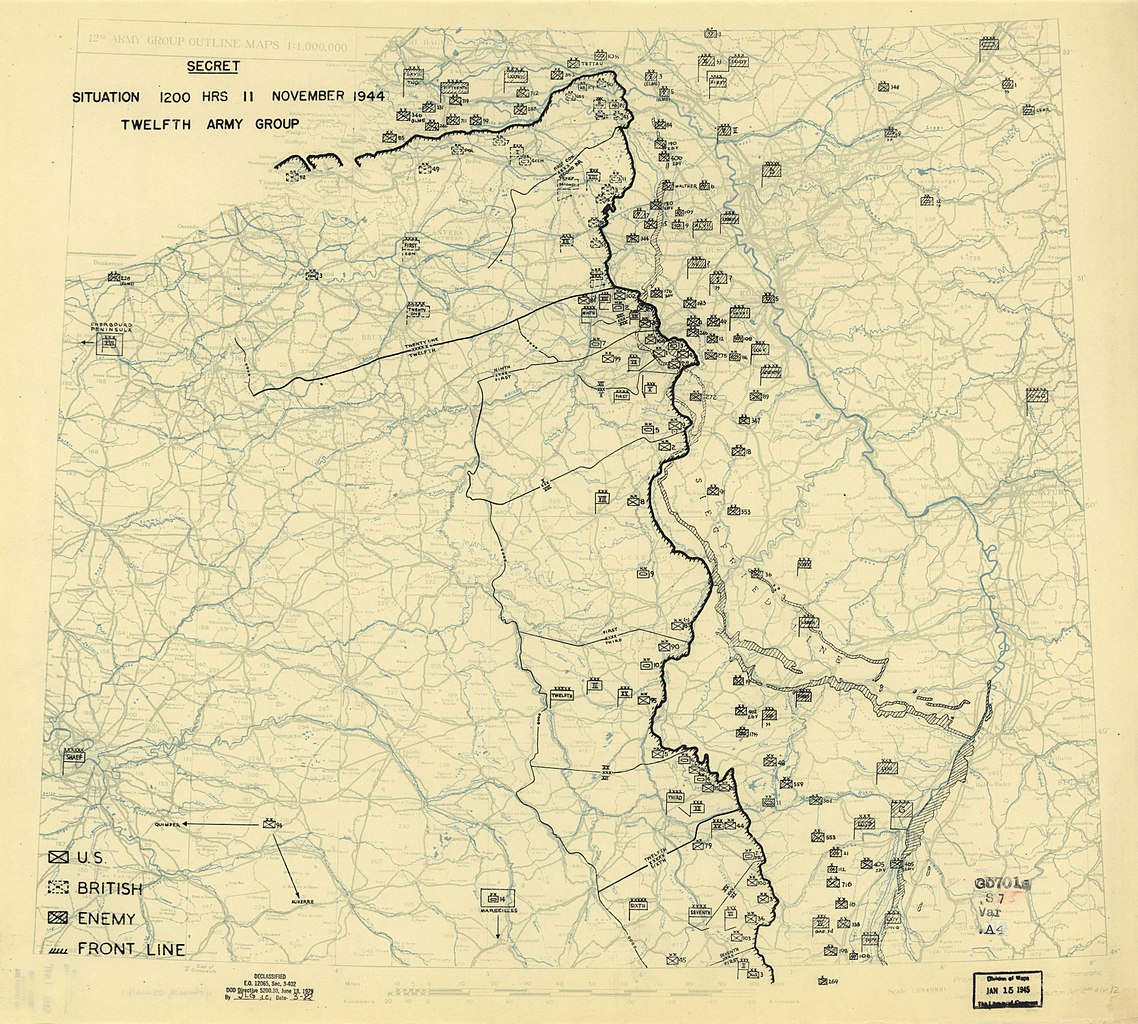 In Paris Churchill and Eden attend Armistice Day (Remembrance Day) ceremonies. U.S. freighter Lee S. Overman is mined off Le Havre, France; outside of one merchant sailor injured, there are no casualties among the 39-man civilian complement and the 27-man Armed Guard. The ship is later written off as a total loss. Air War over Europe 122 RAF Lancasters of No 3 Group carried out a G-H attack on the synthetic-oil refinery at Castrop-Rauxel. The bombing was believed to be accurate and no aircraft were lost. U.S. freighter 'Lee S. Overman' is mined off Le Havre, France; outside of one merchant sailor injured, there are no casualties among the 39-man civilian complement and the 27-man Armed Guard. The ship is later written off as a total loss. The 305th Troop Carrier Squadron, 442d Troop Carrier Group, moves from Peray to St-Andre-de-L'Eure with C-47s. US First Tactical Air Force (Provisional): HQ 320th Bombardment Group and the 441st, 442d, 443d and 444th Bombardment Squadrons (Medium) move from Corsica to Longvic Airfield at Dijon, France with B-26s. The XIX Tactical Air Command flies armed reconnaissance and supports the US XII and XX Corps in the Thionville-Metz, France area. In France, the 405th Fighter Squadron, 371st Fighter Group, based at Tavaux Airfield at Dole begins operating from Dijon with P-47s. Harburg: 237 RAF Lancasters and 8 Mosquitos of No 5 Group. 7 Lancasters lost. The aiming point for this raid was the Rhenania-Ossag oil refinery, which had been attacked several times by American day bombers. (US Eighth Air Force): Mission 712: 482 bombers and 367 fighters make PFF attacks on oil refineries and marshalling yards in W Germany; 1 bomber and 1 fighter are lost: 1. 197 B-17s are sent to hit the Oberlahnstein marshalling yard (146); 24 hit the secondary, the Koblenz marshalling yard; 2 hit a target of opportunity; 1 B-17s is damaged beyond repair and 31 damaged; 1 airman is KIA. Escorting are 170 P-47s and P-51s without loss. 2. 129 B-17s are sent to hit the Buer oil refinery at Gelsenkirchen (100); 23 hit the secondary, the Rheine marshalling yard; 1 B-17 is damaged beyond repair and 1 damaged; 7 airmen are KIA. Escorting are 52 P-51s; 1 is lost. 3. 143 B-24s are sent to hit the Bottrop oil refinery (124); 1 hit Recklinghausen, a target of opportunity; 1 B-24 is lost and 39 damaged; 10 airmen are MIA. Escorting are 98 P-47s and P-51s. 12 of 13 B-17s fly a screening mission. 31 P-51s fly a scouting mission. Dortmund: 209 RAF Lancasters and 19 Mosquitos of Nos 1 and 8 Groups. No aircraft lost. The aiming point was the Hoesch Benzin synthetic-oil plant in the Wambel district. A local report confirms that the plant was severely damaged. Other bombs hit nearby housing and the local airfield. 41 RAF Mosquitos to the Kamen oil refinery, 12 to Osnabrück, 9 to Wiesbaden, 6 to Gotha and 3 to Erfurt, 36 RCM sorties, 59 Mosquito patrols, 26 Lancasters and 24 Halifaxes minelaying off Oslo, in the Kattegat and in the River Elbe. No aircraft lost. (US Fifteenth Air Force): 220+ heavy bombers attack marshalling yards in Rosenheim, Germany; Salzburg, Villach, Linz, and Lienz, the railroad at Zell am See and highway bridge at Sillian, and Wurzen Pass, Austria; railroad bridges at Pinzano al Tagliamento, Latisana, and Casarsa della Delizia, and Aviano Airfield, Italy. Fighters escort all missions except the bridge attacks. Bad weather grounds 100+ other heavy bombers, and another 320+ are recalled before reaching their target areas. (US Ninth Air Force): In Germany, 190 B-26s and A-20s hit strongpoints at Putzlohn and rail bridges at Sinzig, Euskirchen, Ahrweiler, and Mayen; the IX Tactical Air Command hits railroads and other targets, escorts the bombers, and supports the US 28th Infantry Division in the Schmidt area. The XXIX Tactical Air Command hits targets in W Germany. Battle of the Atlantic German submarine 'U-771' sunk in the Arctic in the Andfjord near Harstad, Norway, in position 69.17N, 16.28E, by torpedoes from the British submarine HMS 'Venturer'. 51 dead (all hands lost). German submarine 'U-1200' sunk south of Ireland, in position 50.24N, 09.10W, by depth charges from the British corvettes British corvettes HMS 'Pevensey Castle', HMS 'Launceston Castle', HMS 'Portchester Castle' and HMS 'Kenilworth Castle'. 53 dead (all hands lost). Once again a hunter-killer group found and attacked 'U-1227' with depth charges. Yet again she escaped but was further damaged and when the snort broke down (was repaired at sea though) had to abort to Norway. Italian campaign (US Twelfth Air Force): In Italy, medium bombers strike at railroad bridges in NC and NE Italy, damaging a bridge at Piazzola sul Brenta and knocking out 2 spans of a bridge at Latisana; fighter-bombers continue support of ground forces S of Bologna, attack vehicles, trains, and communications in the Genoa-Alessandria area, bomb Villafranca di Verona Airfield and set most of the area aflame; during the night of 10/11 Nov A-20s bomb Ghedi Airfield and targets of opportunity in the Po Valley. The 17th and 18th Troop Carrier Squadrons, 64th Troop Carrier Group, cease operating from Istres, France and return to base at Ciampino, Italy with C-47s. United StatesPhoto: The escort carrier USS Shamrock Bay (CVE-84) underway off Norfolk, Virginia (USA) on 11 November 1944. She is painted in camouflage Measure 33, Design 10A. The 28 aircraft of Composite Squadron 42 (VC-42), 16 FM-2 Wildcats and 12 TBM-3 Avengers, are tied down between Shamrock Bay's two elevators, as she steams from Norfolk towards the Panama Canal, which she reached six days later 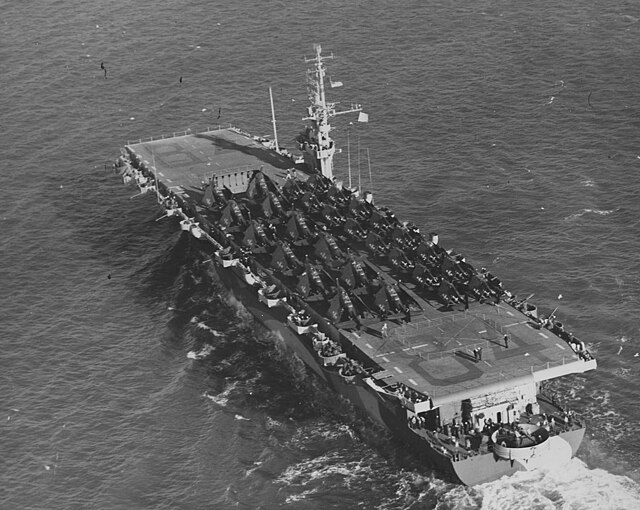 Pacific War Pacific War CHINA (Fourteenth Air Force): 18 B-25s hit Phuc Yen, French Indochina, Wan Lai-Kam, Burma, and damage a bridge on the Mekong River in French Indochina. 10 B-25s bomb Kweilin Airfield in China while 4 hit Wanling, Burma. 5 B-25s and 6 P-40s attack Chingmen Airfield, China. 70+ P-40s, P-51s and P-38s over S China and N Indochina on armed reconnaissance hit targets of opportunity at several locations, concentrating on Lampang, Thailand, and the Changsha, Lingling, and Hengyang, China areas. The attack on Hengyang is so successful that the Japanese are forced to confine future operations from this field to army co-operation flights. Japanese forces capture the Allied airbases at Kweilin and Liuchow. American forces have rendered the base at Liuchow unusable prior to withdrawing. BURMA In the Northern Combat Area Command (NCAC) area, the British 36th Division halts after futile efforts to outflank the Japanese in the Pinwe area. INDIA-BURMA (Tenth Air Force): In Burma, nearly 90 P-47s hit troop concentrations at Chaungdauk, Nawngtao, Mankang, and in the Indaw vicinity; damage and knock out bridges at Meza and S of Kawlin, score near misses on bridges in the Hsenwi and Namhkai area; blast a radio installation near Manoi, bomb Kawlin Airfield, hit rail traffic between Shwebo and Padu, and attack targets of opportunity along the Irrawaddy River from Tigyaing to Twinnge. Transports fly 237 sorties to forward areas. The 115th Liaison Squadron, Tenth AF, arrives at Ledo, India from the US with L-1s and L-5s. A detachment of the 317th Troop Carrier Squadron (Commando), Tenth AF, begins operating from Tulihal, India with C-47s (squadron is based at Sylhet, India). IWO JIMA (Seventh Air Force): Escorted by newly arrived P-38s (some of which also escort the B-29 on Truk Atoll) 29 Guam based B-24s pound Iwo Jima airfields. 16 Saipan based P-47s hit Pagan beach defenses and storage caves. TG 30.2 (Rear Admiral Allan E. Smith) (three heavy cruisers and five destroyers) bombards airfields and other Japanese shore installations on Iwo Jima; shelling commences shortly before midnight and continues into 12 November. PB4Ys screen the group's approach, spot gunfire, and cover the retirement. ENIWETOK Photo: The U.S. Navy seplane tender USS St. George (AV-16) at Eniwetok on 11 November 1944, with a Martin PBM Mariner on deck aft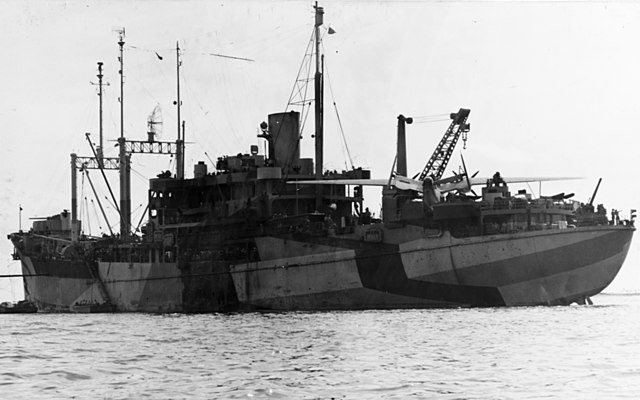 SOUTHWEST PACIFIC AREA [Far East Air Force]: The 19th and 33d Bombardment Squadrons (Heavy), 22d BG (Heavy), move from Owi to Leyte Island with B-24s; the 460th Fighter Squadron, 348th FG, moves from Noemfoor to Tacloban with P-47s; the 500th Bombardment Squadron (Medium), 345th BG (Medium), moves from Mokmer to Dulag with B-25s (squadron continues operating from Biak). The 371st, 372d and 424th Bombardment Squadrons, 307th BG (Heavy), move from Wakde Island to Morotai with B-24s (squadrons are operating from Noemfoor). Lost is A-20G 43-21428. JAPANESE OCCUPIED NETHERLANDS EAST INDIES In the Netherlands East Indies, USAAF Far East Air Forces fighter-bombers and B-25s hit shipping and Namlea Airfield on Boeroe (Buroe) Island. On Celebes Island, P-38s hit Kendari Airfield and B-24s bomb the Ninring River area. PHILIPPINE CAMPAIGN (1944) In the U.S. Sixth Army's X Corps area on Leyte, the 21st Infantry Regiment of the 24th Infantry Division continues the assault on Breakneck Ridge after a preparatory bombardment, the 1stt Battalion gaining the ridge that is its immediate objective but halting short of crest. The 1st Battalion of the 34th Infantry Regiment, which is out of rations, moves to Agahang, about 3,800 yards NW of Limon, and obtains food from the Filipinos. USAAF Far East Air Forces B-24s hit Dumaguete Airfield on Negros Island while fighter-bombers hit shipping in the Palompon area of Leyte Island and targets of opportunity at Valencia on Mindanao Island. Aircraft from Task Group 38.1 (Rear Admiral Alfred E. Montgomery), TG 38.3 (Rear Admiral Frederick C. Sherman) and TG 38.4 (Rear Admiral Ralph E. Davison) set upon a Japanese convoy (fourth phase of TA Operation) as it enters Ormoc Bay, Leyte Island, sinking destroyers Hamanami, Naganami, Shimakaze, and Wakatsuki; minesweeper W.30; three army cargo ships; and a merchant cargo ship. Photo: A Japanese destroyer burns and sinks off Leyte, Philippine Islands after being attacked by U.S. carrier planes, 11 November 1944 UNITED STATES NAVY DEPARTMENT COMMUNIQUES, CINCPAC COMMUNIQUÉ NO. 180, NOVEMBER 11, 1944 Carrier‑based Hellcat fighters, Avenger torpedo planes and Helldiver dive bombers of the Third Fleet attacked a 10‑ship enemy convoy just outside Ormoc Bay on November 10 (West Longitude Date), destroying or probably destroying nine ships. The convoy consisting of three large transports, one medium transport, five destroyers, and one destroyer escort, was apparently attempting to reinforce enemy positions on Leyte Island. The damage inflicted upon the enemy consisted of the following Transport seen to explode and sink. The three other transports seen to sink. Two destroyers seen to sink One destroyer escort seen to sink One destroyer left awash, thought to have sunk. One destroyer with bow blown off, thought to have sunk One destroyer damaged (These ships destroyed and damaged are in addition to the ones destroyed the previous day in the same general area by General MacArthur's land‑based aircraft and reported previously by him.) Approximately 20 aggressive enemy fighters furnished aerial cover for the convoy attacked by the carrier‑based planes. Of these 13 were shot down and five were probably destroyed. In addition, a two‑engined reconnaissance plane and a dive bomber were shot down near our carriers. Our losses were nine planes but it is believed that most of the pilots and aircrewmen were rescued. Catalinas of Fleet Air Wing One on the night of November 8 bombed ground installations at Koror Island in the Northern Palau Islands. Hellcats of the Second Marine Aircraft Wing harassed the Arakabesan Area on Babel*thuap in night sorties. Corsairs of the Second Marine Aircraft Wing bombed Yap Island, hitting the airstrip, hangars and small craft. Liberators of the Seventh Army Air Force on November 8 bombed anti*aircraft gun positions and harbor shipping at Haha Jima in the Bonins. Other Liberators bombed Okimura Town on Haha Jima, causing two large explosions near antiaircraft gun positions. A Navy search Liberator bombed Iwo Jima in the Volcano Islands while Army Liberators strafed Kita Iwo Jima. On November 9 Seventh Army Air Force Liberators again bombed Iwo Jima, hitting the airfield. Our planes were intercepted by from three to five enemy fighters, of which one was shot down and two damaged. Corsairs of the Second Marine Aircraft Wing strafed enemy targets on Rota Island on November 9. PACIFIC The U.S. 77th Infantry Division, en route from Guam, Mariana Islands, to Manus Island, Admiralty Islands, is ordered to Leyte Island in the Philippine Islands. U.S. submarines begin series of attacks on Japanese convoy MOMA-07 (see 12-14 November 1944); Queenfish (SS-393) damages transport Miho Maru off Miike harbor, 32°20'N, 128°00'E. Submarine Scamp (SS-277) is sunk, probably by Japanese Coast Defense Vessel No.4 and naval aircraft off Tokyo Bay, 33°38'N, 141°00'E. Japanese minesweeper W.22 is sunk by mine off Babelthuap, Palau.
|
|
lordroel
Administrator
Posts: 68,033 
Likes: 49,431
|
Post by lordroel on Nov 12, 2023 10:52:10 GMT
Day 1889 of World War II, November 12th 1944Western Front (1944) - Liberation of FranceMap: HQ Twelfth Army Group situation map, November 12th 1944 Photo: Two color guards and color bearers of the Japanese-American 442d Combat Team, stand at attention, while their citations are read. They are standing on ground in the Bruyeres area, France, where many of their comrades fell, 12 November 1944 Photo: Two color guards and color bearers of the Japanese-American 442d Combat Team, stand at attention, while their citations are read. They are standing on ground in the Bruyeres area, France, where many of their comrades fell, 12 November 1944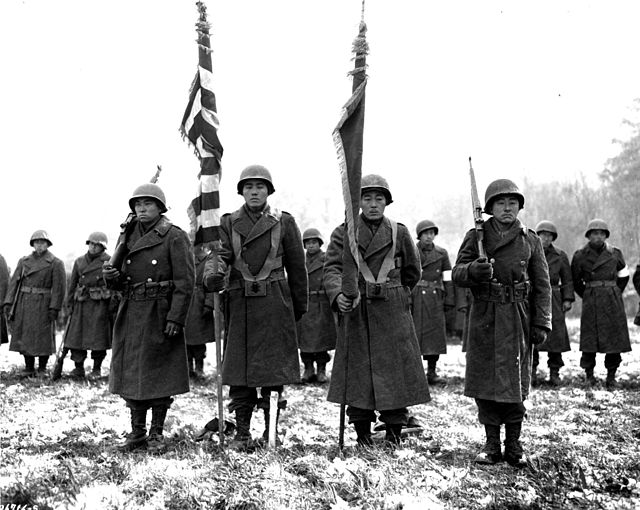 Air War over Europe Air War over Europe (US Eighth Air Force): The operational tour of duty for fighter pilots is set at 270 hours. (US Ninth Air Force): Weather prevents operations by the 9th Bombardment Division; fighter operations are limited but IX and XIX Tactical Air Command's fly patrols and armed reconnaissance in W Germany and along the French-German border. In France, the 404th Fighter Squadron, 371st Fighter Group, based at Tavaux Airfield, Dole begins operating from Dijon with P-47s. Italian campaign (US Fifteenth Air Force):In Italy, 107 fighter-escorted B-24s strike at bridges at Ora, Albes, and Mezzocorona, a viaduct at Avisio, plus the alternate target of Casarsa della Delizia railroad bridges and targets of opportunity in NE Italy including the Latisana railroad bridge and an airfield to the N. (US Twelfth Air Force): In Italy, bad weather grounds medium bombers; fighter-bombers support ground forces in the N Apennines and hit railway targets in the Po Valley, cut rail lines in 18 places and destroy or seriously damage 8 bridges; during the night of 11/12 Nov A-20s hit motor transport, Bergamo Airfield, and the Po River crossing at San Benedetto Po. Destroyer Woolsey (DD-437) shells German howitzer emplacement east of San Remo, Italy, and encounters "fairly accurate" 88-millimeter gunfire in return; shrapnel showers the ship but she suffers no casualties. Military operations, Norway (1944)The German battleship Tirpitz is attacked at anchor in Tromsofiord, German occupied Norway by 21 British Lancaster bombers carrying 12,000-pound bombs. The planes are from No. 9 and No. 617 Squadrons. There are several direct hits and near misses which, combined, cause the ship to capsize. A total of 902 German sailors are killed in the attack. Offshore, British Royal Navy cruisers and destroyers attack a German coastal convoy. Royal Navy sinks ten ships in a German convoy. Operation Counterblast's object was the destruction of shipping off the south west coast of Norway. Forces taking part were: 'Kent' (Rear Admiral Commanding, 1st Cruiser Squadron), 'Bellona', 'Myngs' (Captain (D) 26th Destroyer Flotilla), 'Zambesi', 'Verulam', and 'Algonquin'. Fighter cover was provided by Operation Steak. Allied controlled Italy80,000 leftists demonstrated in Rome in celebration of the anniversary of the Bolshevik Revolution and denounced the monarchy. GermanyHimmler reads out Hitler's speech at the "Beer-hall putsch" celebrations in Munich. United KingdomPhoto: Captain class frigate HMS Ekins, off Harwich, 12 November 1944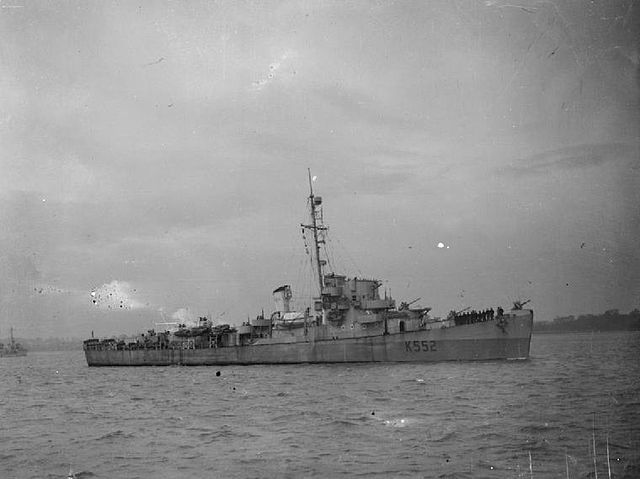 United StatesPhoto: The U.S. Navy aircraft carrier USS Randolph (CV-15) in the Chesapeake Bay area during her shakedown period, 12 November 1944. She is wearing camouflage Measure 32 Design 17a. Photographed from USS Charger (CVE-30) United StatesPhoto: The U.S. Navy aircraft carrier USS Randolph (CV-15) in the Chesapeake Bay area during her shakedown period, 12 November 1944. She is wearing camouflage Measure 32 Design 17a. Photographed from USS Charger (CVE-30)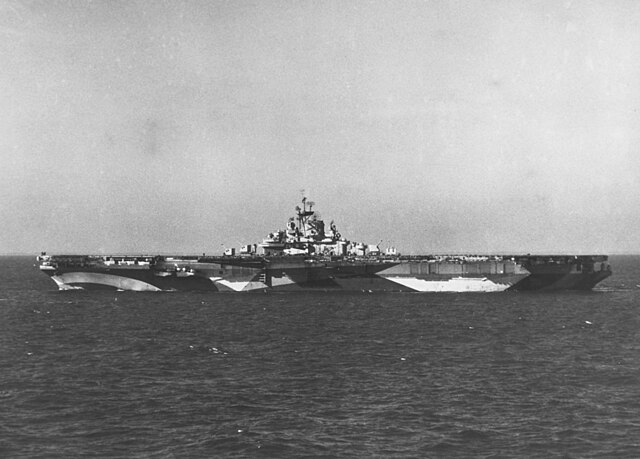 Pacific War Pacific WarCHINA (Fourteenth Air Force): 8 B-25s knock out a railway bridge and damage 2 others near Thanh Hoa, French Indochina. In Burma, 4 B-25s bomb the town of Man Pwe while 4 attack Wanling. In China, 38 P-51s and P-40s hit Hengyang Airfield and attack river, rail, and road traffic, artillery pieces, pillboxes, and storage around Hengyang, Lingling, and Kweilin; 13 P-40s hit the Changsha area; 40 P-51s and P-38s hit various targets of opportunity at several other locations scattered throughout S China and N French Indochina; the 21st Photographic Reconnaissance Squadron, Fourteenth AF, based at Kunming, sends a flight to operate from Suichwan with F-5s (other flights are operating from Kanchow and Hanchung). The East China Air Task Force, formed by Major General Claire Chennault, Commanding General USAAF Fourteenth Air Force, to help Chinese troops defend east China airfields from bases west and east of Japanese-held corridor, begins arriving at Suichwan and goes into action within a week. (Twentieth Air Force): The USAAF Twentieth Air Force's XX Bomber Command flies Mission 16: 96 China-based B-29s are dispatched to bomb to bomb Omura, Kyushu Island. While en route, it is learned that there is bad weather at the target due to a typhoon and the aircraft are ordered to hit a target in China. Twenty nine bombers do not get the word and bomb Omura with the loss of five aircraft. INDIA-BURMA (Tenth Air Force): In Burma, 16 P-47s support ground forces in the Pinwe area and near Indaw; 24 attack supplies and communications targets in the Kawlin area while 9 bomb Japanese concentrations at Indaw and Man Hkong; the town of Pegon is attacked by 11 P-47s and 20+ others and 9 B-25s hit targets of opportunity during the sweeps of the Irrawaddy River from Singu to Katha and along rail lines at several points in N Burma. 250+ transport sorties are flown to forward bases and frontline areas. HQ 2d Air Commando Group arrives at Kalaikunda, India from the US. CEYLON Allied Land Forces South East Asia (ALFSEA) is activated under British Lieutenant General Sir Oliver Leese. The new headquarters consists of former Headquarters, 11 Army Group, previously under General Sir George Giffard, and some U.S. officers; has control over British troops, the Northern Combat Area Command (NCAC), Chinese Army in India (CAI), and Chinese forces within the South East Asia Command (SEAC). American Lieutenant General Raymond A. Wheeler takes over Lieutenant General Joseph Stilwell's former post of Deputy Supreme Allied Commander, SEAC. SAIPAN (Seventh Air Force): 29 Saipan based B-24s with P-38 escort bomb the airfield on Iwo Jima. 11 P-47s strafe the runway and storage area on Pagan. During the night a B-24 on a snooper mission bombs Iwo Jima. B-24s from Angaur Airfield bomb Koror. SOUTHWEST PACIFIC AREA [Far East Air Force]: Units moving to Leyte Island, Philippine Islands: HQ 91st Photographic Wing (Reconnaissance) moves from Biak Island; HQ 345th BG (Medium) and the 498th and 499th Bombardment Squadrons (Medium) from Biak Island with B-25s (squadrons continue to operate from Biak Island). The 370th Bombardment Squadron (Heavy), 307th BG (Heavy), ceases operating from Noemfoor with B-24s and returns to base on Wakde. JAPANESE OCCUPIED NETHERLANDS EAST INDIES In the Netherlands East Indies, USAAF Far East Air Forces B-24 Liberators and fighter- bombers over northeastern Celebes and Halmahera Islands attack shipping and Djailolo Aerodrome on Halmahera Island. Lost is B-25G 42-65142. In Netherlands New Guinea, over 50 USAAF Far East Air Force B-25s blast Mapia and Asia Islands. PHILIPPINE CAMPAIGN (1944) In the U.S. Sixth Army's X Corps area on Leyte Island, the 21st Infantry Regiment, the 24th Infantry Division gains the crest of Breakneck Ridge shortly after noon but is unable to advance south along Highway 2 from there. The 1st Battalion, 34th Infantry Regiment, after receiving its first airdrop of supplies, moves through Consuegra to Cabiranan. The 2d Battalion, 19th Infantry Regiment, blocks Highway 2 south of Limon and maintains the block with difficulty until 23 November. USAAF Far East Air Force B-24s bomb Alicante (Escalente) Airfield on northeast Negros Island while on Leyte Island, fighter-bombers hit Linao barges on the west coast and shipping in Ormoc Bay and B-25s bomb Degos (Digos or Daliao or Degosu) and Matina Aerodromes on Mindanao Island. Major Thomas B. McGuire, Jr. shoots down two "Jack" fighters over Leyte bringing his total victories to 28. ALASKA (Eleventh Air Force): 2 B-24s fly armed reconnaissance over Onnekotan and Matsuwa Islands. PACIFIC Destroyer Nicholas (DD-449) sinks Japanese submarine I-37 south of Yap Island, 08°04'N, 138°03'E. Submarines Barb (SS-220) and Peto (SS-265) continue attacks against Japanese convoy MOMA-07 in the East China Sea. Barb sinks army cargo ship Naruo Maru and damages merchant cargo ship Gyokuyo Maru, 31°39'N, 125°36'E (see 14 November 1944); Peto sinks army cargo ship Tatsuraku Maru, 31°18'N, 125°30'E. Submarine Redfin (SS-272) damages Japanese ship Asogawa Maru, 12°45'N, 118°14'E. Japanese auxiliary submarine chaser Cha 84 is sunk by aircraft off Banggi, North Borneo. PB4Y attacks Japanese convoy SIMA-04 (see 2 November 1944) and sinks merchant cargo ship Atsuta Maru off Malampaya Sound, 11°50'N, 119°19'E. USAAF P-51s damage Japanese auxiliary-powered sailing vessel Namikiri Maru at entrance to Haiphong River, French Indochina.
|
|
lordroel
Administrator
Posts: 68,033 
Likes: 49,431
|
Post by lordroel on Nov 13, 2023 3:45:19 GMT
Day 1890 of World War II, November 13th 1944Eastern Front German forces evacuate Skopje in southern Yugoslavia. The Bulgarian 1st Army advances in this area. Lapland War Last Finnish naval units leave the Kemi-Tornio area. The German-Finnish sea war has ended. Western Front (1944) - Liberation of FranceMap: HQ Twelfth Army Group situation map, November 13th 1944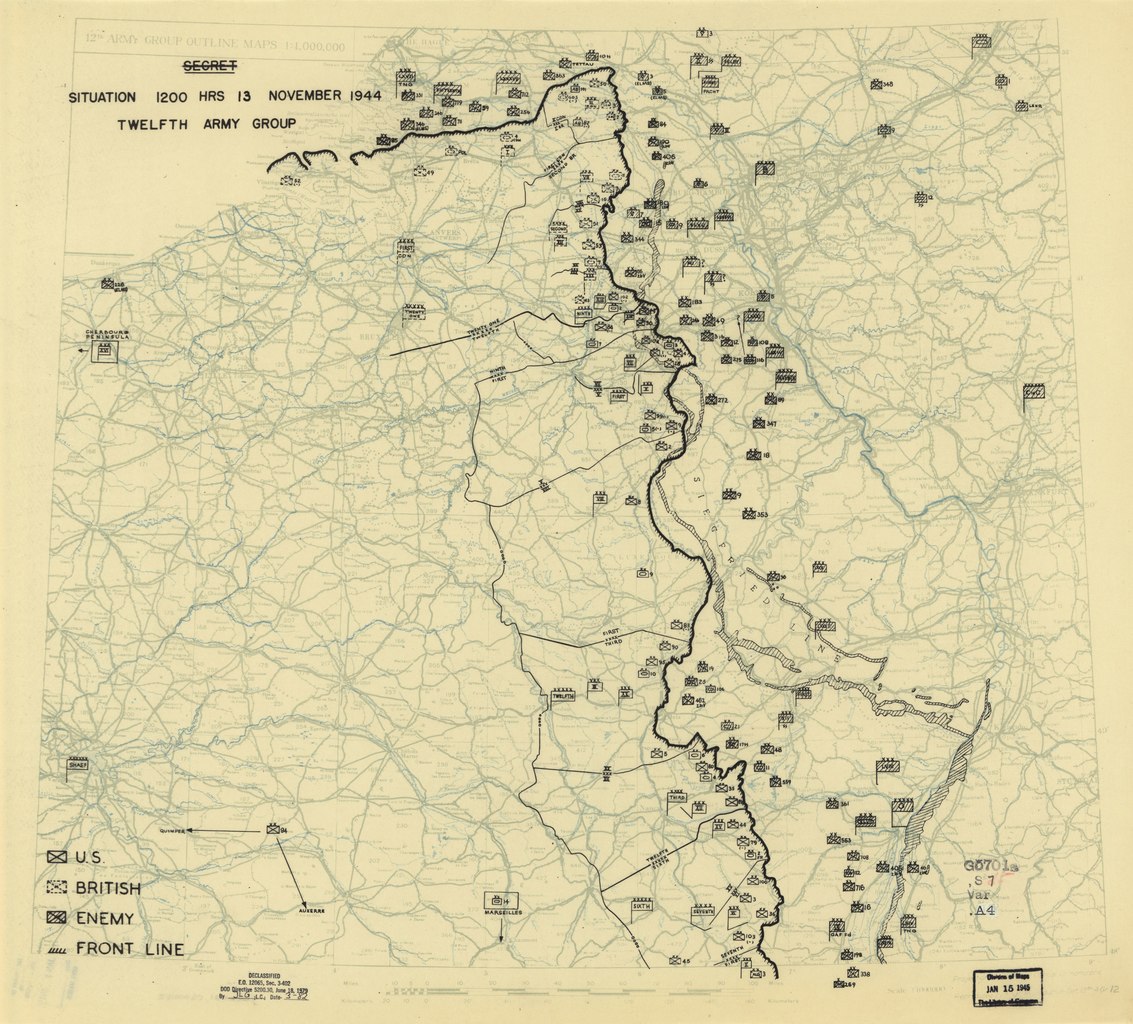 The US 3rd Army has crossed the Moselle River north of Thionville. To the south they advance toward Falquemont and Morhange. Photo: A Japanese-American unit moves out of its old command post. The unit, Company F, 2nd Battalion, 442nd Regimental Combat Team, is holding a section of the front lines near St. Die Area, France, 13 November 1944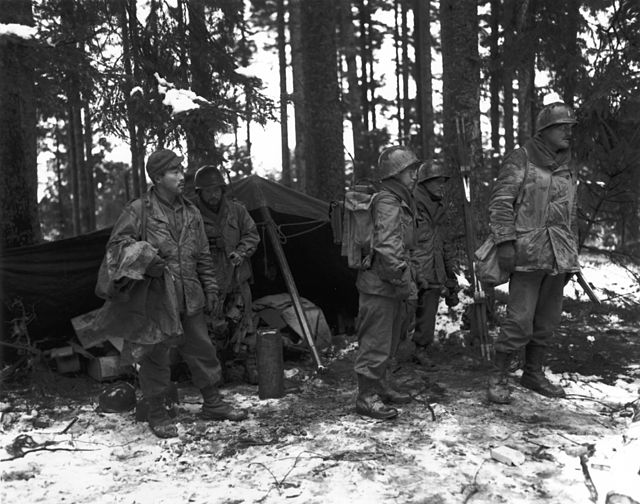 German units withdraw from St. Dies in the face of pressure from the US 7th Army. US forces penetrate the heavy defences of Metz, but they meet strong resistance as they press on to the Saar. Air War over Europe(US Eighth Air Force): Mission 713: 4 B-17s and 8 B-24s drop leaflets in the Netherlands, France and Germany during the night. US Fifteenth Air Force: During the night of 12/13 Nov 14 B-17s and B-24s hit the oil refinery at Blechhammer, Germany; 5 others hit alternate targets and targets of opportunity at scattered locations including Gleiwitz, Germany, Karvina, Poland and Ruzomberok and Vac, Czechoslovakia. Day operations are limited to reconnaissance missions. Italian campaign(US Twelfth Air Force): In Italy during the night of 12/13 Nov A-20s bomb ammunition dumps, pontoon bridge, and targets of opportunity in the Po Valley; a thick overcast covering N Italy the following morning vastly curtails medium bombers which attack only a railway bridge at Padua; fighter-bombers continue to hit communications N of the battle area and also the oil pipeline across the Po River at Ostiglia. United StatesPhoto: The U.S. Navy battlecruiser USS Alaska (CB-1) photographed from the air on 13 November 1944 Photo: The U.S. Navy destroyer minelayer USS Tolman (DM-28) in Boston harbour, Massachusetts (USA), on 13 November 1944. The ship is painted in Camouflage Measure 31, Design 16D. Tolman was laid down as DD-740, but was redesignated DM-28 prior to launching. Note the mines aboard Photo: The U.S. Navy destroyer minelayer USS Tolman (DM-28) in Boston harbour, Massachusetts (USA), on 13 November 1944. The ship is painted in Camouflage Measure 31, Design 16D. Tolman was laid down as DD-740, but was redesignated DM-28 prior to launching. Note the mines aboard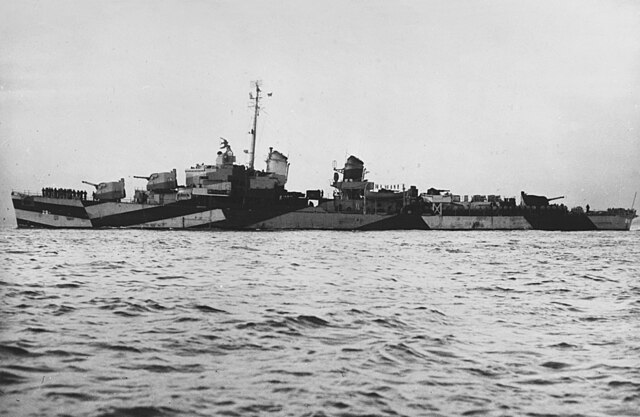 Photo: The U.S. Navy large cruiser USS Guam (CB-2) underway during her shakedown cruise off Trinidad, 13 November 1944 Photo: The U.S. Navy large cruiser USS Guam (CB-2) underway during her shakedown cruise off Trinidad, 13 November 1944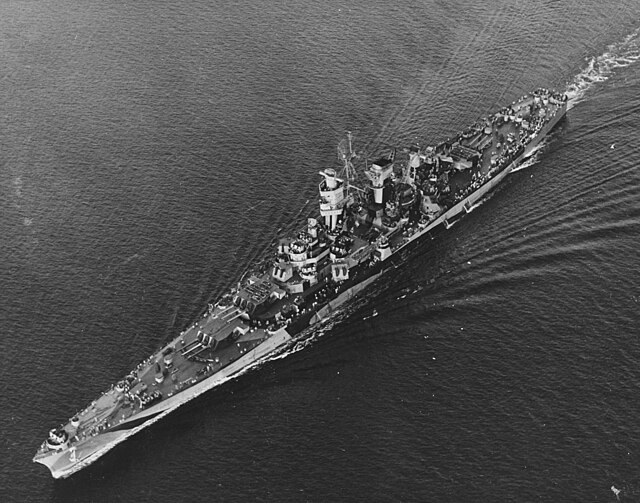 Pacific War Pacific WarCHINA THEATER (Fourteenth Air Force): In Burma, 4 B-25s bomb Man Pwe while 4 others blast 3 warehouses at Wanling. 60+ P-40s, P-51s, and P-38s on armed reconnaissance over S China and as far W and SW as Burma and Thailand hit numerous targets of opportunity including shipping, troops, and railroad targets. INDIA-BURMA (Tenth Air Force): In Burma, 100+ fighter-bombers pound numerous targets in N Burma; close support strikes are made on the Pinwe area, bridges at Namhkai, Meza, and Thegyaung, on troop concentrations and on supplies at Loi-Lum and Namhpakka; the ferry crossing at Shweli is hit by 12-hour delay bombs, the Nawnghkio landing ground is strafed, and numerous targets of opportunity along the Irrawaddy River and rail lines in N Burma are hit. Transports fly 300+ sorties to forward areas; the 166th Liaison Squadron (Commando), 1st Air Commando Group, moves from Asansol, India to Yazagyo with UC-64s and L-5s; the 427th Night Fighter Squadron, AAF, India-Burma Theater, based at Pandaveswar, India, sends detachment to operate from Myitkyina with P-61s. GUAM (Seventh Air Force): 6 B-24s from Guam escorting US Navy photo aircraft over Iwo Jima and the Bonin Islands, attack shipping at Futamiko in the Bonin; 1 B-24 from Saipan carrying out an unsuccessful shipping search, bombs Iwo Jima. 7 B-24s from Angaur Airfield hit oil storage on Malakal Island, Palau Islands and attack a bridge between Malakal and Koror Islands. SOUTHWEST PACIFIC AREA [Far East Air Force]: the 433d Fighter Squadron, 475th Fighter Group, moves from Biak to Dulag with P-38s; the 501st Bombardment Squadron (Medium), 345th BG(Medium), moves from Biak to Dulag but continues to operate from Biak. JAPANESE OCCUPIED NETHERLANDS EAST INDIES Over Halmahera Island and in the Ceram Island area fighter-bombers and A-20s bomb airfields and various targets of opportunity. Pegun Island, New Guinea, is blasted by 2 waves of 70 A-20s. PHILIPPINES CAMPAIGN (1944) Aircraft from three carrier task groups (TG 38.1, TG 38.3, and TG 38.4) of TF 38 (Rear Admiral Frederick C. Sherman, in the temporary absence of Vice Admiral John S. McCain) pound Japanese shipping and port facilities at Manila and in central Luzon. At the former place, TF 38 planes sink light cruiser Kiso, destroyers Hatsuharu and Okinami, and auxiliary submarine chaser Cha 116 14°35'N, 120°50'E; and army cargo ships Eiwa Maru, Kinka Maru, Kakogawa Maru, Sekiho Maru, and Teiyu Maru, as well as merchant cargo ships Taitoku Maru, Hatsu Maru, Seiwa Maru and Shinkoku Maru, 14°35'N, 120°55'E, and damage destroyer Ushio. At Cavite, Navy carrier planes sink destroyers Akebono and Akishimo, fleet tanker Ondo, and guardboat Daito Maru, 14°29'N, 120°55'E. TF 38 planes also sink army cargo ship Heian Maru at Cabcaben, and auxiliary submarine chaser Cha 116 some 20 nautical miles west of Cavite, 14°30'N, 120°45'E. In the Philippine Islands, B-24s pound Fabrica Airfield on Negros Island while fighter-bombers hit shipping and other targets of opportunity; a few fighter-bombers hit Legaspi Airfield; B-25s, with P-38 cover, hit San Roque Airfield and the town of Zamboanga on Mindanao Island; UNITED STATES NAVY DEPARTMENT COMMUNIQUES, CINCPAC COMMUNIQUÉ NO. 181, NOVEMBER 13, 1944 Under cover of a storm during the night of November 7‑8, an enemy force of approximately 200 troops, equipped with knee mortars and machine guns, went ashore on Ngeregong island northeast of Peleliu in the Palau Group. This island had previously been occupied by a small patrol of United States Marines. Several LCI's took off our patrol without casualties. Two of our gunboats and a destroyer blocked Denges Passage to the north from which the enemy troops had apparently come, and bombarded the island. On November 9 our planes bombed and strafed the island, sinking a barge. On November 9 Corsairs and Avengers of the Second Marine Aircraft Wing attacked Ngesang on Babelthuap Island in the Northern Palaus, sinking one barge and setting fire to a fuel tank. Moderate antiaircraft fire was en*countered. Hellcat fighters bombed Koror and Babelthuap. Corsairs sank a barge at Babelthuap and scored a direct bit on a radio station. Yap Island was bombed by Corsairs of the Second Marine Aircraft Wing. Corsairs of the Second Marine Aircraft Wing on November 10 sank a Japanese destroyer previously damaged near Golou in the Palau Islands. Liberators of the Seventh Army Air Force on November 10 bombed Koror Island starting large fires. Several small islands in the Northern Palaus were hit by Catalinas of Fleet Air Wing One and Corsairs and Avengers of the Second Marine Aircraft Wing in night operations, and two fuel dumps were set afire. Airfields on Peleliu Island and Angaur Island are now being used by United States land‑based aircraft of the Seventh Army Air Force and the Second Marine Aircraft Wing. On November 10 Liberators of the Seventh Army Air Force bombed airstrips on Iwo Jima causing large fires in storage areas. Meager antiaircraft fire was encountered. Another force of Liberators bombed the Iwo Jima air*fields the next day. Three enemy fighters were seen in the air but did not attack our planes. Thunderbolts of the Seventh Army Air Force attacked Pagan Island In the Marianas without encountering resistance on November 10 and 11. Cor*sairs of the Second Marine Aircraft Wing also attacked installations on Rota on November 10 and 11. On November 10 enemy‑held positions. in the Marshall Islands were further neutralized by Navy search Venturas of Fleet Air Wing Two and Corsairs of the Fourth Marine Aircraft Wing. PACIFIC Minesweeper Ardent (AM-340) and frigate Rockford (PF-48) sink Japanese submarine I-12 (that had sunk freighter John A. Johnson on 29 October 1944) 100 miles west-southwest of Los Angeles, California, 31°55'N, 139°45'W. Submarine Seal (SS-183) sinks Japanese merchant cargo ship Gassan Maru north-northwest of Etorofu, Kurils, 45°35'N, 148°14'E. Japanese submarine I-53 is damaged, cause unspecified, off Marcus Island.
|
|
lordroel
Administrator
Posts: 68,033 
Likes: 49,431
|
Post by lordroel on Nov 14, 2023 3:50:15 GMT
Day 1891 of World War II, November 14th 1944Eastern Front The Yugoslavs announce the fall of Skoplje, which has been a main staging point for the Germans withdrawing from Greece. Photo: Bulgarian troops in Skopje on November 14, 1944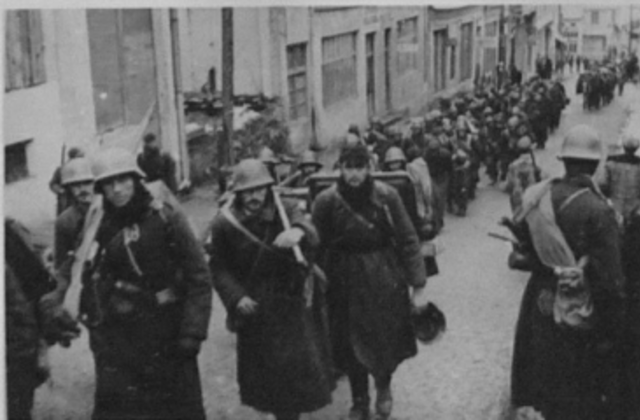 Western Front (1944) - Liberation of FranceMap: HQ Twelfth Army Group situation map, November 14th 1944 Western Front (1944) - Liberation of FranceMap: HQ Twelfth Army Group situation map, November 14th 1944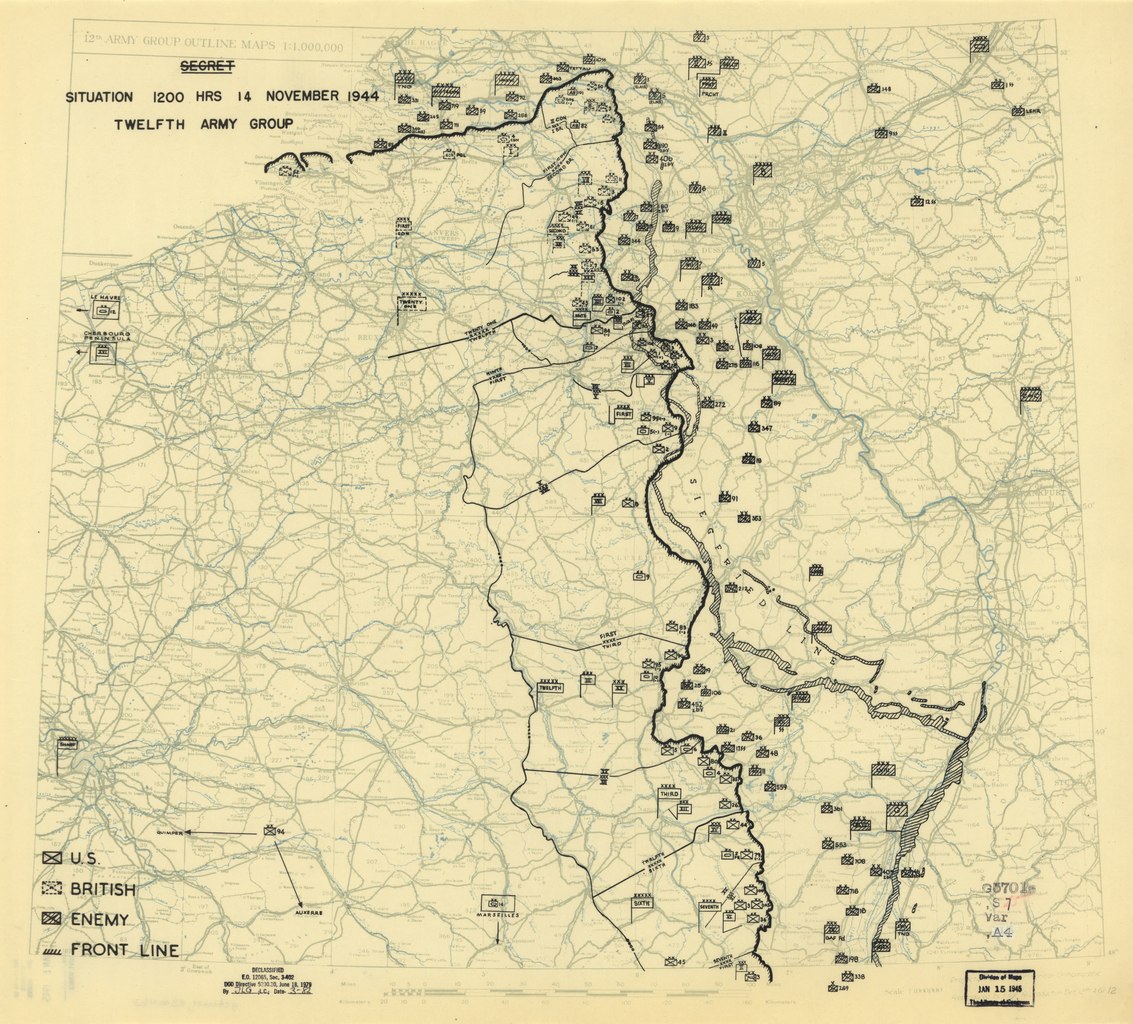 In the U.S. Third Army's XX Corps area, Oudrenne falls to the 359th Infantry Regiment, 90th Infantry Division; the 358th cuts the Inglange-Distroff road and clears Distroff. The 90th Reconnaissance Troop links the bridgeheads of the 90oth and 95th Infantry Divisions, providing the 10th Armored Division a protected route of advance. A Bailey bridge is completed at Thionville during morning, and Combat Command B of the 10th Armored Division starts across it in afternoon. Combat Command A of the 10th Armored Division and the 3d Cavalry Group (Mechanized) cross at Mailing, latter to screen in the Sarre-Moselle triangle. The 95th Infantry Division, which has been engaged largely in containing the German bridgehead west of Metz, begins attacks west of the river with the 379th Infantry Regiment after artillery preparation: while the 2d Battalion works around to the rear of Fort Jeanne d’Arc and holds off counterattacks, the 1st Battalion begins the reduction of fortifications known as the Seven Dwarfs, taking the three northern works and attempting in vain to gain the next, Fort Bois Ia Dame. The regiment is isolated in these advanced positions, though, and must be supplied by air. East of the Moselle River, the 2d Battalion of the 378th Infantry Regiment, 95th Infantry Division, takes Haute Yutz and opens an assault on Fort d’IlLange; the 1st Battalion, 377th Infantry Regiment, is heavily engaged at Bertrange and Imeldange. The 10th and 11th Infantry Regiments, 5th Infantry Division, drive northward abreast toward Metz while the 3d Battalion, 2d Infantry Regiment, moves to the Sorbey area; the 11th clears the woods southwest of Fort Verdun and takes Prayelle Farm; the 10th cleans out the southern half of Bois de l’Hôpital. In the XII Corps area, Lieutenant General Manton Eddy, Commanding General XII Corps, limits the 80th Infantry Division’s mission to clearing the high ground south of Faulquemont. Combat Command A of the 6th Armored Division attacks toward Côte de Suisse, a ridge extending from Landroff to Thicourt, taking Brulange, Suisse, and Landroff. The Germans begin a series of determined attempts to recover Landroff at dusk, pushing into the village. Combat Command B, 4th Armored Division, and the 137th Infantry Regiment, 35th Infantry Division, close in on Morhange, seizing Destry and Baronville in bitter fighting. The 134th Infantry Regiment, 35th Infantry Division, moves forward to the right. Combat Command A, 4th Armored Division, sweeps through Bois de Kerperche, extending northeast from Koecking ridge, and gets elements to Guebling. The 328th Infantry Regiment, 26th Infantry Division, continues to clear Koecking forest, from which the Germans begin withdrawing, during the night of 14/15 November. In the U.S. Seventh Army's XV Corps area, the 44th Infantry Division continues to battle the Germans near Leintrey. The 79th Infantry Division overcomes opposition at Ste Pole and Ancerviller. In the French First Army area, I Corps opens an offensive toward the Belfort Gap, attacking astride the Doubs River at noon with the 2d Moroccan Division assisted by the 5th Armored Division on the left and the 9th Colonial Division on the right. Tactical surprise is achieved and gains are made all along front. Air Chief Marshal Sir Trafford Leigh-Mallory and his wife Doris die today when the Avro York transport carrying them to Ceylon crashes in atrocious weather on the Cheminee du Diable in the French Alps. Sir Trafford is on his way to take up his new appointment as Air Commander-in- Chief South East Asia Command (SEAC). Western Front (1944) - Liberation of the NetherlandsIn the British Second Army area, XII Corps opens an offensive to reduce the German bridgehead west of the Maas River in the Roermond-Venlo area, attacking across Nord and Wesscm Canals with the 53d and 51st Divisions while the 7th Armoured Division takes the locks at Panheel. Air War over Europe Photo: Aerial views an attack by USAAF Martin B-26 Marauders on the Konz-Karthaus railway bridge across the Moselle River on 14 November 1944 Italian campaign Italian campaign In the British Eighth Army's V Corps area, the 4th Division reaches the Montone River in the region north of Highway 9. Advancing along the highway, the 167th Brigade of the 56th Division crosses the Montone River. South of Highway 9, the 6th Division continues toward the Samoggia River. Bad weather restricts USAAF Twelfth Air Force operations to fighter-bomber attacks by 17 P-47 Thunderbolts on rail lines and a road north of the battleline. GermanyGeneral Andrei Vlasov, a Soviet officer captured by the Germans in 1942, defects. Vlasov argues that Germany should set up a Russian provisional government and recruit a Russian army of liberation under his command. Vlasov writes an anti-Bolshevik leaflet which aircraft drop by the millions on Soviet forces, and as a direct consequence thousands of Soviets desert. German Chancellor Adolf Hitler authorizes him to set up the Russian Liberation Committee and the Russian Liberation Army, known as ROA (from Russkaya Osvoboditel' naya Armiya), to fight the Soviets. United Kingdom The Norwegian government-in- exile announces that Norwegian troops under Colonel Arne Dahi have landed in Norway to operate with the Soviet Karelian forces against the Germans on the Arctic front. United StatesPhoto: The U.S. Navy destroyer seaplane tender USS Childs (AVD-1) underway, 14 November 1944 Photo: The U.S. Navy troop transport USS General W. P. Richardson (AP-118) at sea in the Atlantic Ocean on 14 November 1944. She is painted in Camouflage Measure 32, Design 10T. The photo was taken by a blimp from squadron ZP-12 Photo: The U.S. Navy troop transport USS General W. P. Richardson (AP-118) at sea in the Atlantic Ocean on 14 November 1944. She is painted in Camouflage Measure 32, Design 10T. The photo was taken by a blimp from squadron ZP-12 Pacific War Pacific War CHINA (Fourteenth Air Force): In E Burma and in the China-Burma boundary areas 8 B-25s bomb Wanling and Hsenwi, Burma; 15 P-38s and P-40s on armed reconnaissance hit targets of opportunity around Wanling, Burma and Mangshih, China. BURMA In the Northern Combat Area Command (NCAC) area, the Chinese 22d Division, upon taking Man-tha with ease and blocking the road from Bhamo, is ordered to continue the drive to Si-u. The Chinese 38th Division’s 114th and 113th Regiments are converging on Bhamo: the 114th, pressing west toward the town, is bitterly opposed by the Japanese in the Mornauk area, 8 miles east of Bhamo; the 113th, upon crossing the Taping River at Myothit, moves west along the south bank of the river toward Bhamo. INDIA-BURMA (Tenth Air Force): In Burma, 12 B-25s bomb a supply area near Lashio; 56 fighter-bombers hit supply areas, enemy concentrations, town areas, and general targets of opportunity at Tingka, China and Kutkai, Sandaya, Palaung, Kawlin, and in the Shwebo-Kyaukmyaung area. 12 support ground forces in the Pinwe area, 4 bomb Sindaw River bridges and 30+ others maintain patrols S of Myitkyina. 300+ transport sorties are flown to forward areas. SAIPAN (Seventh Air Force): 22 Saipan and Guam based B-24s bomb Woleai, hitting an airfield and adjacent installations and firing an oil dump. 4 Saipan based P-47s hit the airfield on Pagan. During the night of 14/15 Nov a B-24 from Saipan on a snooper mission attacks shipping SW of the Bonin. BONIN ISLANDS PROJECT Mike continues as USAAF B-24s (42d Bomb Squadron) lay 6 mines in effective locations off Ani Jima and Haha Jima. SOUTHWEST PACIFIC AREA [Far East Air Force]: the 310th Bombardment Wing (Medium) moves from Morotai to Leyte; the ground echelon of the 418th Night Fighter Squadron, 13 AF, moves from Morotai to Dulag (the air echelon remains on Morotai with P-61s). The 370th Bombardment Squadron (Heavy), 307th BG (Heavy), moves form Wakde to Morotai with B-24s. JAPANESE OCCUPIED NETHERLANDS EAST INDIES In the Netherlands East Indies, B-24s strike Langoan Airfield on the northeastern tip of Celebes Island. NEW GUINEA CAMPAIGN B-25s pound Pegun Island, New Guinea in preparation for allied amphibious landings early the following morning PHILIPPINE CAMPAIGN (1944) In the U.S. Sixth Army's X Corps area, Lieutenant General Walter Krueger, Commanding General Sixth Army, orders Major General Franklin Sibert, Commanding General X Corps, to commit the 32d Infantry Division, originally intended to operate on southern Samar, in the zone of the 24th Infantry Division in order to relieve elements of that division. Breakneck Ridge is now largely clear, but the Japanese still retain several adjacent spurs. The 1st Battalion, 34th Infantry Regiment, patrols actively on Kilay Ridge; supplies for the battalion are hand carried by Filipinos from Consuegra. In the XXIV Corps area, the 32d Infantry Regiment of 7th Infantry Division is ordered to start north to the Damulaan-Caridad area and upon order to advance upon Ormoc. USAAF Far East Air Forces B-24s, with P-38 and P-47 cover, bomb Bacalod (Bacolod) Airfield on Negros Island while fighter-bombers hit trucks and buildings in the Valencia, Mindanao Island area. On Leyte Island, fighter-bombers attack targets near Linao and hit shipping south of Ormoc. On Cebu Island, B-25s and fighter-bombers attack Lahug and Opon Airfields. Photo: 14 Nov 1944, USS Essex TBF-1 Avenger dropping a bomb over Pasig River in Manila targeting the dockyard TF 38 (Rear Admiral Frederick C. Sherman) air strikes against Japanese shipping in Philippines continue. At Manila, Navy carrier-based planes sink transport Tatsura Maru, merchant tanker No.5 Horai Maru, merchant cargo ships Hatsu Maru and Aoki Maru, and damage transport Tottori Maru and army cargo ship Myogi Maru; cargo ship Yukihisa Maru is sunk just outside Manila Bay, 13°58'N, 120°36'E. Off Mindoro, F6Fs from carrier Yorktown (CV-10) attack Japanese convoy SIMA-04, sinking merchant tanker Ayagiri Maru, 12°40'N, 120°41'E; and damaging army cargo ship Yutaka Maru (see 15 November 1944) as well as escorting submarine chasers Ch 1, Ch 19, Ch 26, and Ch 36. UNITED STATES NAVY DEPARTMENT COMMUNIQUES, CINCPAC COMMUNIQUÉ NO. 182, NOVEMBER 14, 1944 Hellcat fighters, Avenger torpedo planes and Helldiver bombers from car*rier task groups of the Pacific Fleet attacked enemy shipping and installations in and around Manila Bay on November 12 (West Longitude Date). The following damage was done to enemy shipping: One light cruiser badly damaged. Two destroyers exploded. An estimated 11 cargo vessels and oilers sunk or blazing. One floating dock hit by torpedoes. Many docks in Manila Bay and at Cavite Navy Yard were struck. In the attack, 18 of 20 intercepting enemy aircraft were shot down over Luzon and 10 others were shot down near the task groups. An estimated 130 to 140 single and twin‑engined enemy planes on Legaspi, Manila and Clark Airstrips were strafed. One of our surface ships was damaged. The carrier task groups engaged in this operation were under the tactical command of Rear Admiral Frederick C. Sherman, United States Navy. Corsairs of the Second Marine Aircraft Wing strafed and bombed the Northern Palau Area on November 11. One small enemy vessel was sunk. Hellcats bombed Koror , Malakal and Arakabesan in the Palaus on the same day. Avengers and Corsairs loosed bombs on the Yap Airstrip the same day. Liberators of the Seventh Air Force bombed a power station at Koror on November 11, but results were not observed. A Navy search Liberator of Fleet Air Wing One dropped bombs on Iwo Jima in the Bonins on November 11. Results were unobserved. Aircraft of Fleet Air Wing One bombed islands in the Bonins on Novem*ber 13. A near miss was scored on a medium cargo vessel, and two near misses on an escort surface craft at Chichi Jima. A few airborne enemy planes which were over Iwo Jima did not attack our planes. PACIFIC Submarine Halibut (SS-232) is damaged by depth charges and aerial bombs, Luzon Strait, 20°56'N, 121°33'E, but returns from patrol with no difficulty. Submarine Jack (SS-259) attacks Japanese convoy, sinking merchant cargo ship Hinaga Maru and damaging merchant tanker No.2 Yuzan Maru, 11°02'N, 109°02'E (see 15 November 1944). Submarines Batfish (SS-310), Raton (SS-270) and Ray (SS-271) attack Japanese convoy off the northwest coast of Luzon; Raton damages supply ship Kurasaki north-northwest of Cape Bolinao, 17°41'N, 118°00'E (see 15 November 1944), and sinks merchant tanker No.5 Unkai Maru, 17°48'N, 117°58'; Ray sinks Coast Defense Vessel No.7 65 miles northwest of Cape Bolinao, 17°45'N, 117°45'E. Submarine Skipjack (SS-184) damages Japanese motor sailship No.6 Tatsu Maru off Shimushiru, Kurils,46°40'E, 151°40'E. Strong currents then drive the damaged vessel upon a reef; she is declared a total loss. Submarine Spadefish (SS-411) sinks Japanese merchant cargo ship Gyokuyo Maru, previously damaged by Barb (SS-220) on 12 November 1944 while in convoy MOMA-07, 31°04'N, 123°56'E. During Japanese air raid on U.S. shipping off Leyte, freighter Floyd B. Olson is damaged by bomb; there are, however, no casualties among the 43-man merchant complement, the 28-man Armed Guard, and the 409 stevedores embarked to work cargo. USAAF B-24 sinks Japanese lugger Kiho Maru off Sandakan harbor. Japanese ship Heiyo is sunk by mine, Adang Bay, 01°43'S, 116° 26'E.
|
|
lordroel
Administrator
Posts: 68,033 
Likes: 49,431
|
Post by lordroel on Nov 15, 2023 3:47:52 GMT
Day 1892 of World War II, November 15th 1944Eastern Front Jasberény, 30 miles (48 kilometers) east of Budapest falls to the Soviets. Western Front (1944) - Liberation of FranceMap: HQ Twelfth Army Group situation map, November 15th 1944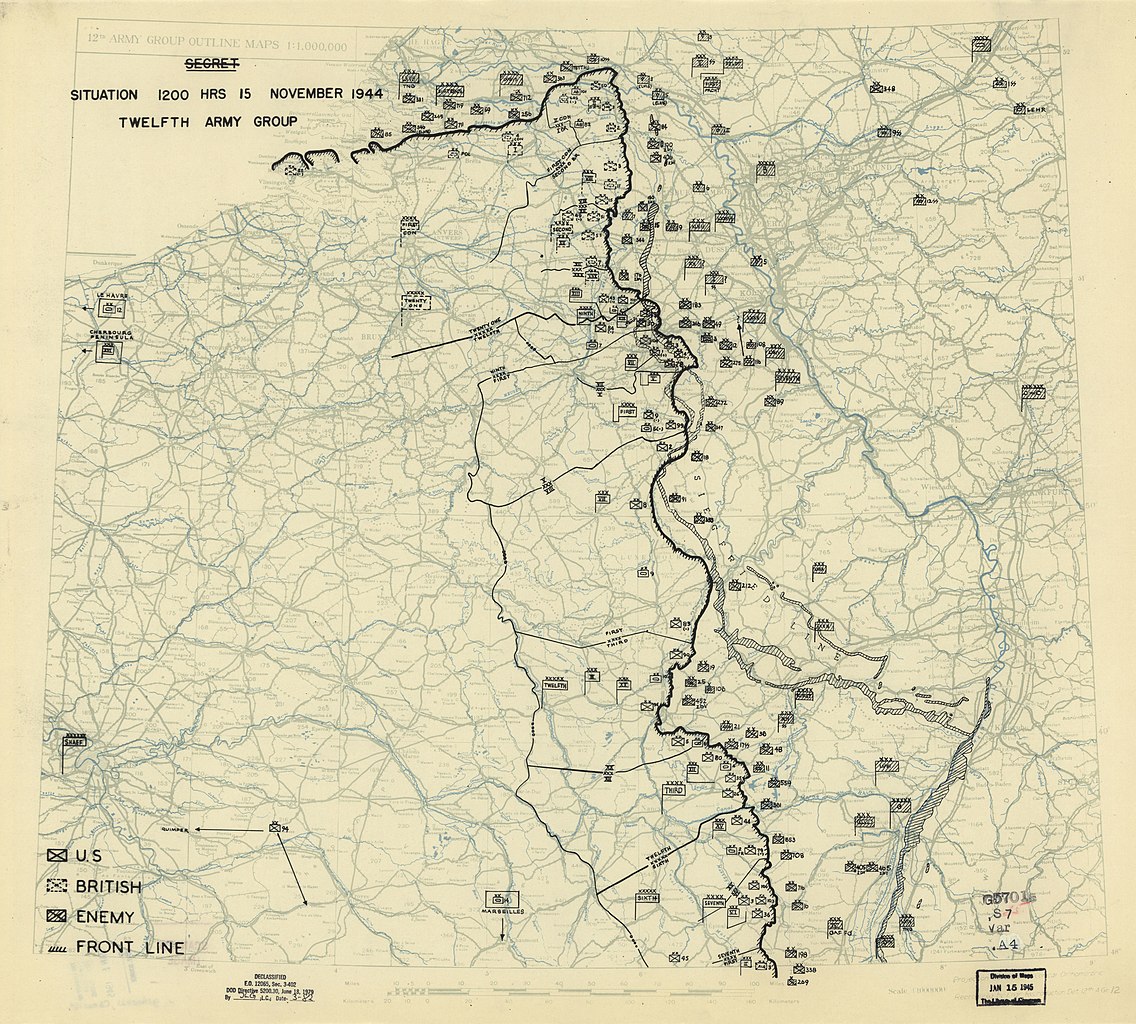 Forces of the US 3rd Army advance around Metz. To the south of the city, the Metz-Sarrebourg rail line is cut. To the right, the US 7th Army advances along the line north of St. Die. On the right flank of the Allied armies, the French 1st Army continues its offensive toward Belfort. Western Front (1944) - Siegfried Line campaignIn the U.S. First Army's VII Corps area, the 12th Infantry Regiment, 4th Infantry Division, breaks through to the encircled companies on a plateau southwest of Huertgen and withdraws them, but by now the Regiment holds only the southern edge of the plateau. Air War over Europe The USAAF Eighth Air Force flies Mission 714: six B-17s and six B-24s drop leaflets in the Netherlands, France and Germany during the night. Weather prevents USAAF Ninth Air Force bomber operations and limits fighters; the XIX Tactical Air Command flies armed reconnaissance in the Merzig-Trier- Saarbrucken, Germany area and supports the XX Corps in same area. One each USAAF Fifteenth Air Force bomber hits Passau and the Main marshalling yard at Salzburg. During the day, RAF Bomber Command dispatches 177 Lancasters to carry out a G-H attack on the Hoesch synthetic oil plant at Dortmund; 174 hit the target. The raid, through thick cloud, is believed to have been accurate. Two Lancasters are lost. During the night of 15/16 November, RAF Bomber Command Mosquitos hit six targets: 34 bomb Berlin, six bomb the Krupp Treibstoff synthetic oil refinery at Wanne-Eikel, five bobm Gotha, four each hit the Karlsruhe and the Buer synthetic oil refinery at Gelsenkirchen and one attacks Osnabruck. One aircraft is lost. Italian campaignIn the U.S. Fifth Army's British XIII Corps area, 8th Indian Division troops push into Modigliana, where contact is made with the Polish II Corps. Bad weather cancels all USAAF Twelfth Air Force operations except for reconnaissance by four P-47 Thunderbolts and attack by two on a railroad bridge and rolling stock in the Po Valley. Four USAAF Fifteenth Air Force B-24s bomb troop concentrations in the Novi Pazar area. Battle of the MediterraneanDestroyer escort 'Frament' (DE-677) collides with Italian submarine 'Luigi Settembrini' 685 miles west of Gibraltar; 'Frament' is damaged, but 'Luigi Settembrini' sinks. United StatesA number of senior armed forces commanders are promoted to the new ranks of General of the Army and Admiral of the Fleet. The new ranks are identified by a five star insignia. Photo: The U.S. Navy attack transport USS Magoffin (APA-199) underway at sea on 15 November 1944. She is painted in Camouflage Measure 32, Design 4T. The photo was taken by a blimp of squadron ZP-31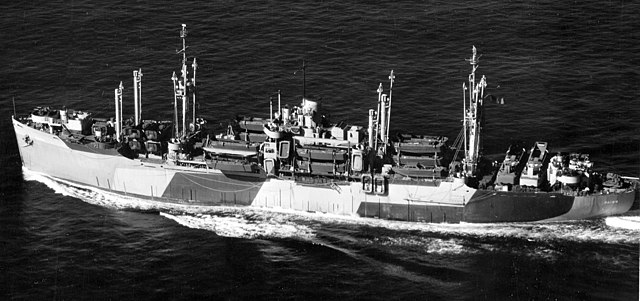 Photo: The U.S. Navy attack transport USS Lubbock (APA-197) underway at sea on 15 November 1944. She is painted in Camouflage Measure 32, Design 4T. The photo was taken from a blimp oftaken by squadron ZP-31 Photo: The U.S. Navy attack transport USS Lubbock (APA-197) underway at sea on 15 November 1944. She is painted in Camouflage Measure 32, Design 4T. The photo was taken from a blimp oftaken by squadron ZP-31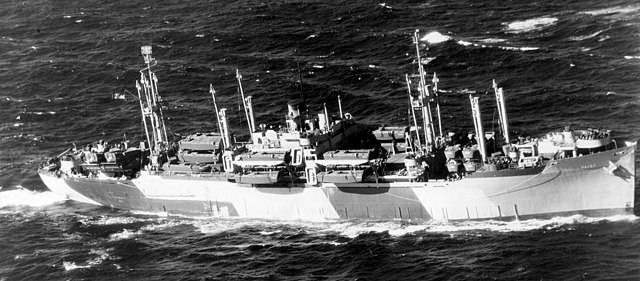 Photo: The U.S. Navy attack transport underway on 15 November 1944. She is painted in Camouflage Measure 32, Design 4T Photo: The U.S. Navy attack transport underway on 15 November 1944. She is painted in Camouflage Measure 32, Design 4T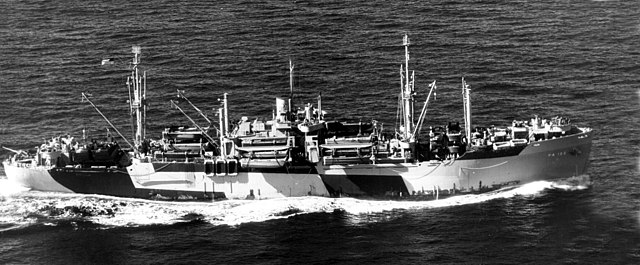 Photo: A North American P-51D-5-NA Mustang (s/n 44-14017) is lowered to the hangar aboard the U.S. Navy aircraft carrier USS Shangri-La (CV-38) during a test flight on 15 November 1944 Photo: A North American P-51D-5-NA Mustang (s/n 44-14017) is lowered to the hangar aboard the U.S. Navy aircraft carrier USS Shangri-La (CV-38) during a test flight on 15 November 1944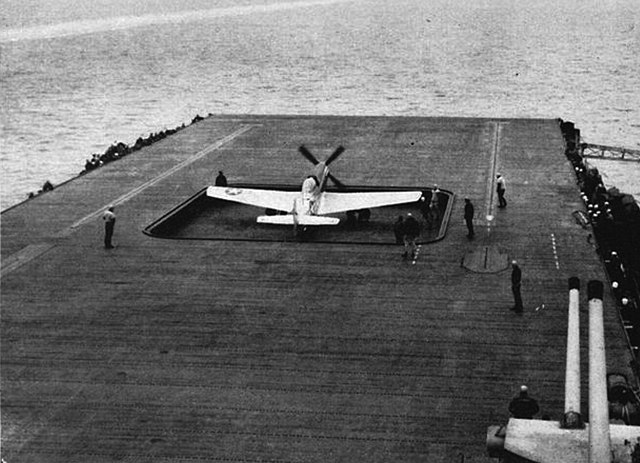 Photo: A North American PBJ-1H Mitchell on the flight deck of the U.S. Navy aircraft carrier USS Shangri-La (CV-38) during tests of the airplane's carrier suitability, 15 Novermber 1944 Photo: A North American PBJ-1H Mitchell on the flight deck of the U.S. Navy aircraft carrier USS Shangri-La (CV-38) during tests of the airplane's carrier suitability, 15 Novermber 1944 Photo: The U.S. Navy destroyer USS Winslow (DD-359) underway off Lakehurst, New Jersey (USA), on 15 November 1944. Note that this ship still carries four twin 127 mm/38 single-purpose gun mounts Photo: The U.S. Navy destroyer USS Winslow (DD-359) underway off Lakehurst, New Jersey (USA), on 15 November 1944. Note that this ship still carries four twin 127 mm/38 single-purpose gun mounts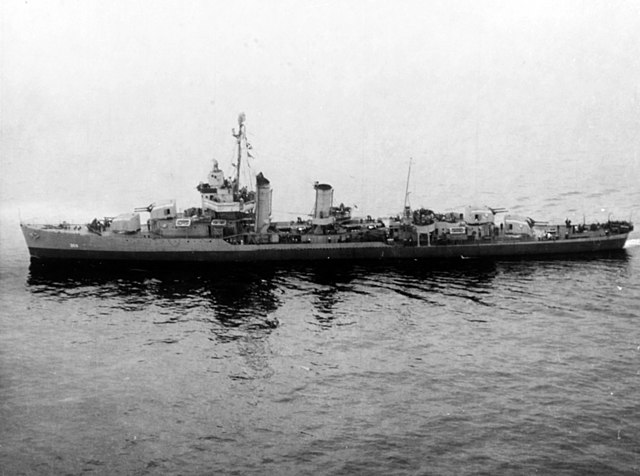 Pacific War Pacific War CHINA (Fourteenth Air Force): 19 B-25s and 16 P-51s and P-40s over SW China, W Burma, and N Indochina hit railroad targets, villages, town areas, and general targets of opportunity at or near man Pwe and Wanling, Burma; Mangshih and Tingka, China; Quang Yen, Nam Dinh, and Thanh Hoa, French Indochina. INDIA-BURMA (Tenth Air Force): In Burma, 12 B-25s attack the airfield at Kawlin; 42 P-47s hit supplies, troop and vehicle concentrations, and targets of opportunity at Mansak, Gyogon, Banmauk, Namtao, and Wuntho; 20 support ground forces in the Pinwe area while 16 attack bypass bridges at Kawnghka and Namhkai, knocking out the latter; 8 P-47s bomb Kyaikthin rail sidings and junction, 8 strafe Anisakan Airfield, and 12 hit targets of opportunity during N Burma road sweeps. 280 transport sorties are flown. GUAM (Seventh Air Force): Guam based B-24s on a shipping strike to the Bonin, attack vessels at Haha Jima and near Chichi Jima. 1 Saipan Island-based B-24, during the night of 15/16 Nov snooper mission, bombs Iwo Jima after failing to find shipping targets in the Bonin. SOUTHWEST PACIFIC AREA [Far East Air Force]: HQ 22d and 43d BGs move from Owi to Leyte; the 8th Bombardment Squadron, 3d BG, moves from Hollandia to Dulag; the 20th Combat Mapping Squadron, 6th Photographic Reconnaissance Group, moves from Biak Island to Dulag (air echelon continues operating from Biak Island with F-7s; the 80th Fighter Squadron, 8th Fighter Group, moves from Morotai to Dulag but continues to operate from Morotai with P-38s. 68th Troop Carrier Squadron, 433d Troop Carrier Group, moves from Nadzab to Biak (detachment remains at Biak) with C-47s. JAPANESE OCCUPIED NETHERLANDS EAST INDIES In NE Celebes B-24s bomb Tanamon, Celebes Island while other B-24s, B-25s, and fighter-bombers hit scattered targets of opportunity on Celebes and Halmahera Islands. NEW GUINEA CAMPAIGN TG 78.14 (Captain Lord Ashbourne, RN) lands Army troops (31st Division) on Mapia Island, 160 nautical miles northeast of Sansapor. Marines reoccupy Ngeregong Island, finding that the Japanese have abandoned it after being pounded by Marine aircraft and LCI(L)-bombardment. PHILIPPINES CAMPAIGN (1944) In the Philippine Islands, B-24s, with P-38 support, bomb La Carlota Airfield while B-25s hit Lahug; B-25s and fighter-bombers attack targets of opportunity on Cebu and shipping off the W coast of Leyte Island; on Mindanao Island B-24s hit 3 airfields while P-38s hit shipping and other targets of opportunity; ALASKA (Eleventh Air Force): 8 B-25s weather-abort an armed photo reconnaissance over Paramushiru Island. PACIFIC Submarine Barbel (SS-316) attacks Japanese convoy in the South China Sea about 250 miles east of Tourane, French Indochina, sinking transports Misaki Maru, 15°10'N, 112°40'E, and Sugiyama Maru, 15°14'N, 112°14'E. Submarine Guavina (SS-362) sinks abandoned Japanese army cargo ship Yutaka Maru, damaged the day before by Navy carrier-based aircraft, off Mindoro, 12°25'N, 120°55'E. Submarine Jack (SS-259), operating in the South China Sea, sinks Japanese transports Nichiei Maru, 11°11'N, 108°56'E, and No.2 Yuzan Maru, 11°15'N, 108°57'E. Submarine Queenfish (SS-393) attacks Japanese convoy HI-81, and sinks army cargo ship/aircraft transport Akitsu Maru at southern entrance of Tsushima Strait, about 60 miles east of Saishu Island, 33°05'N,128°38'E. Japanese supply ship Kurasaki sinks as the result of damage inflicted by submarine Raton (SS-270) the previous day, north-northwest of Cape Bolinao, Luzon, 17°27'N, 117°43'E. Submarine Saury (SS-189) damages Japanese guardboat Kojo Maru, northwest of the Bonins, 29°59'N, 139°44'E (see 16 November 1944). Submarines Sterlet (SS-392) and Silversides (SS-236) damage Japanese guardboat No.12 Hachiryu Maru northwest of Ogasawara-Gunto, 30°10'N, 137°23'E. No.12 Hachiryu Maru reaches port, but apparently performs no more service. PB4Y completes destruction of Japanese ship Celebes Maru, aground since 10 November 1944 off Bondoc Point, Luzon, 13°17'N, 112°37'E. Navy land-based aircraft sink Japanese ship Harufuji Maru off Borneo, 06°52'N, 116°51'E. USAAF P-38s damage Japanese gunboat Man-Yo Maru off Balikpapan. RAF Liberators bomb Japanese shipping at Mergui, sinking No.3 Tanshin Maru and communications boat Kasumi.
|
|
lordroel
Administrator
Posts: 68,033 
Likes: 49,431
|
Post by lordroel on Nov 16, 2023 3:40:58 GMT
Day 1893 of World War II, November 16th 1944Eastern Front Twenty USAAF Fifteenth Air Force B-24s bomb Visegrad Airfield and five others hit a highway; 26 P-38s strafe transport targets on roads between Sarajevo and Novi Pazar. Western Front (1944) - Liberation of FranceMap: HQ Twelfth Army Group situation map, November 16th 1944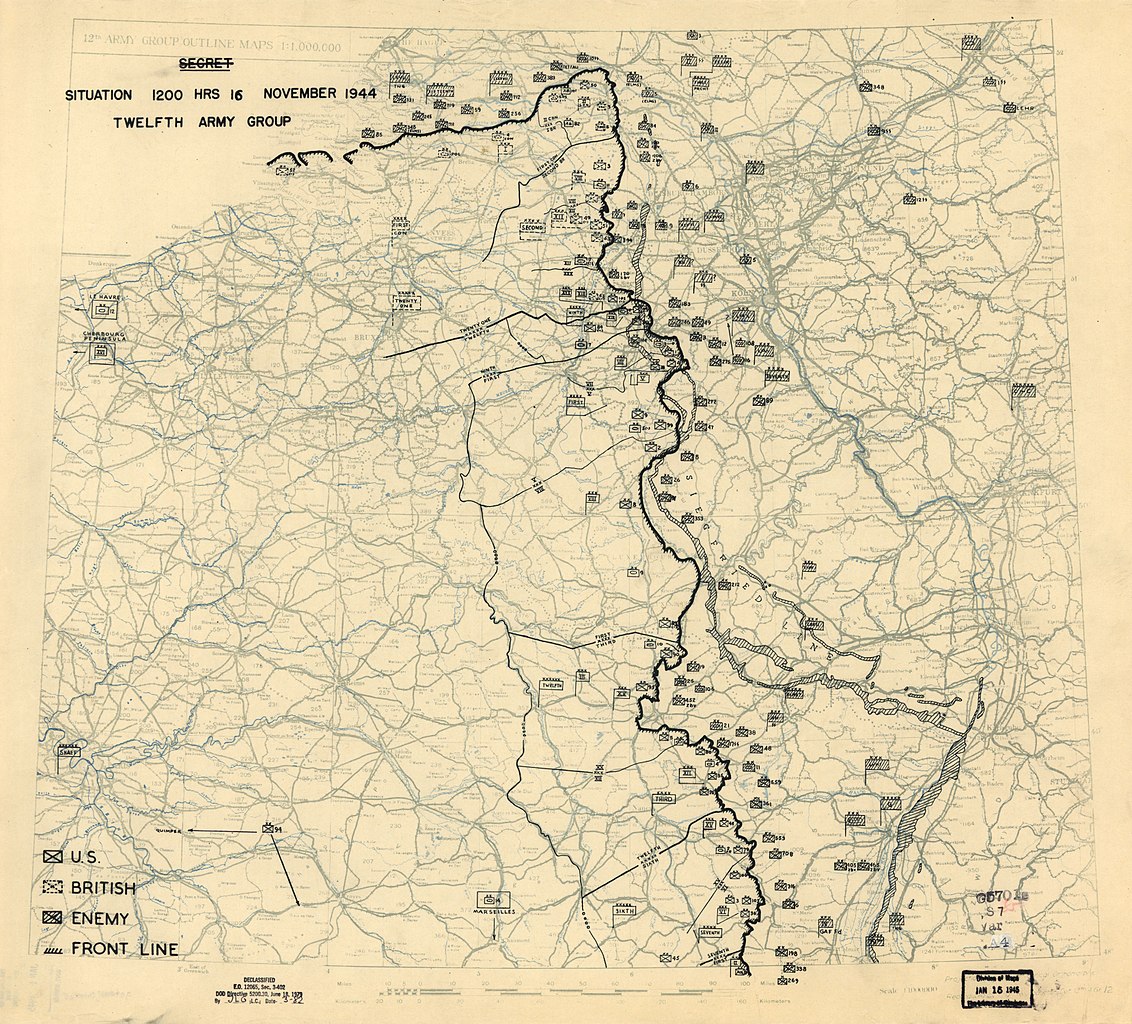 In U.S. Third Army's XX Corps area, 357th Infantry Regiment, 90th Infantry Division, silencing guns of the Hackenberg, takes a ridge beyond; the 358th Infantry seizes Inglange and Metzervisse. Combat Command B, 10th Armored Division, reaches Kirschnaumen; Combat Command A’s Task Force Chamberlain gets beyond Laumesfeld while Task Force Standish takes Ste Marguerite. Task Force Bacon, 95th Infantry Division, starts south toward Metz along the east bank of the Moselle River, advancing steadily 4.5 miles miles to Traemery. In the region west of the Moselle River, the 377th and 378th Infantry Regiments take up pursuit as the Germans begin withdrawing their bridgehead, abandoning Woippy; the 379th Infantry, strengthening its attack, takes St Hubert Farm and Moscou Farm. The 5th Infantry Division attacks north toward Metz: the 11th Infantry Regiment contains the Verdun Forts and is heavily engaged at Frescaty Airfield; the 10th Infantry finishes clearing Marly and pushes on toward Magny; the 2d Infantry is largely engaged at the Nied Francaise River line, but a battalion pushes toward Frontigny. In the XII Corps area, Combat Command A, 6th Armored Division, and 318th and 319th Infantry Regiments, 80th Infantry Division, attack toward Faulquemont, supported by massed fire from Cote de Suisse, and seize the high ground south of town; during the advance, the Germans are driven from five towns and about 1,200 prisoners are taken. In the U.S. Seventh Army's XV Corps area, the 79th Infantry Division gains ground toward the Vezouse River, overrunning Barbas. The French 2d Armored Division, which is to exploit the expected breakthrough of infantrymen, clears the Nonhigny with reconnaissance elements of Combat Command R. In the VI Corps area, 103d Infantry Division clears part of the triangular hill mass southwest of St Die. In the French First Army area, I Corps overruns Ste Marie and pushes on toward Montbaeliard on the left and thrusts to Roches-les-Blamont on the right. Western Front (1944) - Liberation of the NetherlandsIn the British Second Army’s VIII Corps area, the 15th Division finds Meijel clear of the Germans. In the XII Corps area, patrols reach the Zig Canal, southeast of Meijel. Western Front (1944) - Siegfried Line campaignThe U.S. Ninth and First Armies open a co-ordinated offensive to clear the Roer Plain between the Wurm and the Roer Rivers. The combined air-ground effort is called Operation QUEEN. The air phase of Queen marks the greatest close support effort yet made by Allied air forces, British and U.S. strategic and tactical air forces joining in the assault on relatively small zone of attack and dropping more than 9,400 tons of high-explosive bombs. In the U.S. Ninth Army area, XIX Corps attacks for a crossing of the Roer at Juelich at 1245 hours. Combat Command B, 2d Armored Division, pushes toward Gereonsweiler on the left flank of corps from Waurichen and Beggendorf, seizing Immendorf, Floverich, and Puffendorf. Puffendorf is in the outer ring of the Juelich defenses. Efforts of one column to take Apweiler are costly and unsuccessful, but another column seizes a hill 700 yards northeast of Puffendorf on the highway to Gereonsweiler. In the center, the 29th Infantry Division, committing a battalion each from 115th and 175th Regiments, attacks from the Baesweiler-Oidtweiler area toward Aldenhoven en route to Juelich but is stopped close to the line of departure near the villages of Siersdorf and Bettendorf. The 30th Infantry Division, reinforced by a regiment of the 84th, attacks south in the Wuerselen area with three regiments abreast, the 117th taking Mariadorf and 120th overrunning Euchen; bit little progress is made in Wuerselen. In the U.S. First Army area, VII Corps opens an attack at 1245 hours, pushing toward Dueren and Cologne to secure Roer River crossings, with the 104th Infantry Regiment, 3d Armored, 1st Infantry, and 4th Infantry Divisions from left to right. The 104th Infantry Division makes their main effort on the right with 414th Infantry Regiment, reinforced by a battalion of the 415th Infantry, driving toward the Donnerberg (Hill 287) and Eschweiler Woods; German opposition from commanding ground of the Donnerberg limits progress, but elements secure a weak hold on the Birkengang, suburb of Stolberg northwest of the Donnerberg; the rest of the 104th Infantry Division conducts limited actions to the north without making appreciable headway. Combat Command B, 3d Armored Division, attacks in the Stolberg corridor toward four villages at the western base of Hamich Ridge. Task Force Mills loses 15 tanks in a vain effort to take Hastenrath and Scherpenseel. Task Force Lovelady seizes Kottench and Werth. The 1st Infantry Division, reinforced by the 47th Infantry Regiment, 9th Infantry Division, makes the main effort of the corps from Schevenhuette, pressing through Huertgen Forest toward Langerwehe and Juengersdorf; the 47th Infantry Regiment gets a battalion into Gressenich; the 16th and 26th Infantry Regiments attack in the Huertgen Forest astride the Schevenhuette-Langerwehe highway, the 26th Infantry Regiment on the right, but lacks tank support and advance slowly; the 16th Infantry reaches the edge of the woods overlooking Hamich. The 4th Infantry Division, reinforced by Combat Command R of the 5th Armored Division, attacks on a broad front in the Huertgen Forest at the scene of earlier battles in an effort to break through between Schevenhuette and Huertgen, making their main effort on the left in order to support the 1st Infantry Division: elements of the 8th Infantry Regiment on the north and the 22d Infantry Regiment in the center make extremely slow progress against well-organized positions within the forest; the 12th Infantry Regiment can scarcely move on plateau southwest of Huertgen. Air War over Europe The primary target for the USAAF Fifteenth Air Force today is the Main marshalling yard at Innsbruck: 62 B-17s bomb the yard with the loss of three aircraft. One each B-17 bomb the marshalling yard at Villach and the railroad at Zillertaller. The USAAF Eighth Air Force flies Mission 715 in support of Operation QUEEN: 1,243 bombers and 282 fighters, along with Ninth Air Force and RAF aircraft, are dispatched to attack tactical targets east of Aachen, Germany in support of the US First and Ninth Armies' offensive; 1 fighter is lost: 713 B-17s and B-24s hit Eschweiler and 478 B-17s hit Duren. Eighty USAAF Ninth Air Force 9th Bombardment Division bombers hit defended areas and strongpoints at Echtz, Luchem, and Eschweiler; IX Tactical Air Command fighter-bombers dive-bomb gun positions and other targets in the Stolberg and Hurtgen areas and XIX Tactical Air Command supports the US XX Corps in the Merzig, Trier, and Saarbrucken area; the XXIX Tactical Air Command attacks targets in 12 west German towns. During the day, RAF Bomber Command is asked to bomb three towns near the German lines in the area between Aachen and the Rhine in support of Operation QUEEN. The RAF dispatches 1,188 aircraft to attack Duren, Jaelich and Heinsburg in order to cut communications behind the German lines. Duren is attacked by 485 Lancasters and 13 Mosquitos, Jaelich by 413 Halifaxes, 78 Lancasters and 17 Mosquitos and Heinsberg by 182 Lancasters. Three Lancasters are lost on the Duren raid and a Lancaster on the Heinsberg raid. Four hundred forty eight USAAF Fifteenth Air Force B-17s and B-24s attack the Munich marshalling yard with the loss of three aircraft. Over 250 P-51s and P-38s support the attack on Munich. Italian campaign In the U.S. Fifth Army area, the British XIII Corps pauses to regroup so that troops may be rotated. In the British Eighth Army area, V Corps halts along the line of the Montone and Cosina Rivers and regroups. USAAF Twelfth Air Force medium bombers fly 250+ sorties against rail lines in the Brenner Pass and other parts of northeastern Italy destroying the railroad bridge at Sacile; fighter-bombers in support of the British Eighth Army advance to the northwest of Forli, hit guns, ammunition supplies, and other military targets, attack pipeline crossings of the Po River at Ostiglia and Ferrara, and pontoon stores near Ficarola, as well as hitting communications targets north of the battle area. USAAF Fifteenth Air Force bombs hit three targets: three bomb a railroad bridge at Casarsa, two attack the railroad in the Brenner Pass and one hits a railroad bridge at Pinzano. During the night of 16/17 November, RAF bombers of No. 205 (Heavy Bomber) Group fly two missions: 77 drop supplies to partisans in Northern Italy and ten bomb a pontoon bridge at Ficorolo. Battle of the Atlantic U.S. freighter 'Theodore Parker' is mined about 12 miles east of the mouth of the Humber River, 53°33'N, 00°39'E, but returns, under her own power, to the port of Hull for repairs. There are no casualties to the 42-man merchant complement or the 27-man Armed Guard. Battle Indian OceanU.S. freighter Mary Ball rescues 17 survivors of U.S. tanker Fort Lee, torpedoed and sunk by German submarine U-181 on 2 November 1944, but not before she has fired on the lifeboat until identifying it as friendly. Fortunately, there are no casualties. BelgiumThree Belgian government ministers without portfolio resign because of differences between the government in exile and the resistance. United StatesPhoto: The U.S. Navy destroyer USS Bullard (DD-660) off San Francisco, California (USA), on 16 November 1944. She is painted in Camouflage Measure 32, Design 10D Photo: The U.S. Navy high-speed transport USS Kinzer (APD-91) underway off Charleston, South Carolina (USA), on 16 November 1944. She is painted in Camouflage Measure 31, Design 20L Photo: The U.S. Navy high-speed transport USS Kinzer (APD-91) underway off Charleston, South Carolina (USA), on 16 November 1944. She is painted in Camouflage Measure 31, Design 20L Photo: The U.S. Navy attack transport USS Fond du Lac (APA-166) at Astoria, Oregon (USA) on 16 November 1944. She is painted in Camouflage Measure 32, Design 4T Photo: The U.S. Navy attack transport USS Fond du Lac (APA-166) at Astoria, Oregon (USA) on 16 November 1944. She is painted in Camouflage Measure 32, Design 4T Pacific War Pacific WarCHINA (Fourteenth Air Force): In China, 23 B-24s bomb Changsha; 8 B-25s hit Lohochai and bomb the Wanling, Burma area. In French Indochina, 16 B-25s hit Nghia Trang, Duc Tho, Nha Trang, and Do Len. 70+ P-40s and P-51s over SE and SW China on armed reconnaissance attack road, river, and rail traffic, town areas, and other targets of opportunity at several scattered locations. INDIA-BURMA (Tenth Air Force): In Burma, 30 P-47s hit troop concentrations and supply areas at Naungmo, Nawngmoloi, and Lashio; 11 support ground forces in the Pinwe area, 4 attack bridges at Meza and over the Sindaw River; 4 bomb the Meza railroad station, 16 sweep the railroad from Sagaing to Kanbalu, and 16 strafe Nawnghkioand Hsumhsai Airfields. Transports fly 270+ sorties to forward bases and frontline areas. BURMA In the Northern Combat Area Command (NCAC) area, the British 36th Division is still held up in the railroad corridor by stubborn opposition in the Pinwe area. Two companies are isolated by a Japanese roadblock and have to be withdrawn. SAIPAN (Seventh Air Force): 12 Saipan Island-based B-24s bomb shipping at Chichi Jima Island while 2 others attack barges at Haha Jima. 12 P-47s and 3 P-38s hit the airfield on Pagan in the first combat strike by P-38s in the Mariana Islands. During the night of 16/17 Nov a snooper mission in the Bonin Islands, a B-24 attacks shipping. SOUTHWEST PACIFIC [Far East Air Force]: Colonel Willard R Wolfinbarger becomes Commanding Officer of the XIII Fighter Command. Units moving to Leyte: HQ 3d BG and 90th Bombardment Squadron from Hollandia, New Guinea with A-20s; HQ 348th Fighter Group from Noemfoor. JAPANESE OCCUPIED NETHERLANDS EAST INDIES In the Kendari area and on the northeast peninsula of Celebes Island, and on Halmahera Island in the Netherlands East Indies, USAAF Far East Air Forces B-24s, B-25s, and fighter-bombers pound airfields, villages and shipping. B-25 also support ground forces in the Mapia Island and bomb Namlea Airfield on Boeroe Island. PHILIPPINE CAMPAIGN (1944) In the U.S. Sixth Armys X Corps area on Leyte, two battalions of the 128th Infantry Regiment, 32d Infantry Division, begin a drive on Ormoc, passing through the 21st Infantry Regiment, 24th Infantry Division, on Breakneck Ridge. One battalion is soon halted but the second pushes forward 350 yards without opposition. In the central Philippines and in the Mindanao Island area, USAAF Far East Air Forces B-25s, B-24s, and fighter-bombers hit airfields, harbors, shipping, and targets of opportunity. UNITED STATES NAVY DEPARTMENT COMMUNIQUES, CINCPAC COMMUNIQUÉ NO. 183, NOVEMBER 16, 1944 A revision based on evidence gathered after the carrier task group at¬tacks in the Manila Bay Area on November 12 (West Longitude Date) raises the damage figures (given in communiqué Number 182) on Jap ship losses. It is now known that: A light cruiser was sunk, it had been reported as badly damaged. Four destroyers were sunk; two had been reported as exploded. Eleven cargo vessels and oilers were sunk; this number had been reported as sunk or blazing. There are no other revisions of any information contained in communiqué Number 182. On the night of November 10 11 (West Longitude Date) search Liberators of Fleet Air Wing One bombed airplane storage areas on Iwo Jima in the Bonin Islands. Weak fighter opposition was encountered. On November 12 Navy search Liberators again bombed installations on Iwo Jima and scored near misses on a medium cargo vessel at Chichi Jima. The following day a Navy search Liberator was credited with probable hits on a small cargo ship near Iwo Jima. On November 13 a Mitchell of tile Second Marine Aircraft Wing made possible hits on a medium cargo vessel near Haha Jima. Search Venturas of Fleet Air Wing One bombed installations on the Yap Airstrip on the night of November 10 11, meeting meager antiaircraft fire. On November 12 Corsairs and Hellcats of the Second Marine Aircraft Wing with Navy search Liberators of Fleet Air Wing One bombed and destroyed warehouses and vehicles on Japanese bases in the Northern Palau Islands. Corsairs of the Second Marine Aircraft Wing struck the airstrip on Yap on the same day. Strafing Corsairs of the Second Marine Aircraft Wing sank several barges and small craft on November 13 in the Northern Palaus and Yap areas and struck the airstrip on Yap, and Liberators of the Seventh Army Air Force pounded docks and a radio station on Arakabesan. Hellcats of the Second Marine Aircraft Wing made harassing attacks on Japanese bases in the Palaus on the night of November 13. On November 13 bombers of the Seventh Army Air Force and Navy search Liberators struck the airstrip and installations on Woleai in the Western Carolines. Avengers and Corsairs of the Second Marine Aircraft Wing bombed Rota in the Marianas on November 12 13. Thunderbolts of the Seventh Army Air Force hit Pagan on November 13. Continuing neutralization raids were made in the Marshalls on Novem¬ber 11. Corsairs of the Fourth Marine Aircraft Wing and a Navy search Ventura of Fleet Air Wing Two bombed Jaluit on the same day. Nine fires were seen. Dauntless dive bombers of the Fourth Marine Aircraft Wing at¬tacked installations at Mille on November 11. PACIFIC Submarine Scabbardfish (SS-397) sinks Japanese transport Kisaragi Maru north by west of Chichi Jima, 29°04'N, 142°12'E. Submarine Tambor (SS-198) sinks Japanese guardboat Takashiro Maru southwest of Torishima, 30°00'N, 139°30'E. Japanese guardboat Kojo Maru, damaged the previous day by submarine Saury (SS-189), sinks northwest of the Bonins, 29°59'N, 139°39'E. Other Japanese losses include heavy cruiser Haguro, light cruiser Oyodo, and destroyer Yukikaze damaged by aircraft off Brunei, North Borneo; merchant tanker Asokawa Maru damaged by unspecified cause off Brunei; and fleet tanker Kyoei Maru sunk by USAAF B-24 and P-38 aircraft; and Man-yo Maru damaged off Tarakan, Borneo.
|
|
lordroel
Administrator
Posts: 68,033 
Likes: 49,431
|
Post by lordroel on Nov 17, 2023 8:49:00 GMT
Day 1894 of World War II, November 17th 1944Eastern Front USAAF Fifteenth Air Force B-24s bomb two targets: 66 hit the marshalling yard at Gyor with the loss of two B-24s and one bombs Varoslod. German resistance ends in Tirana, Albania. Western Front (1944) - Liberation of FranceMap: HQ Twelfth Army Group situation map, November 17th 1944 In the U.S. Third Army's XX Corps area, the 10th Armored Division fans out to pursue the Germans toward the Sarre River, closely supported by aircraft. The 357th Infantry Regiment, 90th Infantry Division, cleans out the Hackenberg fortifications, which are found leveled by direct fire, and takes Klang; the 358th Infantry seizes Metzeresche. The Germans begin withdrawing in front of the division after nightfall. Task Force Bacon, 95th Infantry Division, gets almost to Metz, stopping for the night within sight of Fort St Julien. West of the Moselle River, the 95th Infantry Division continues toward Metz, the 377th Infantry Regiment reaching the suburb of Sansonnet. Against weakened resistance, the 5th Infantry Division continues northward toward Metz: the 11th Infantry Regiment clears most of Frescaty Airfield, but is stopped on the right by fire from Fort St Privat; the 10th Infantry is halted at Fort Queuleu but gets patrols to the city limits; the 2d Infantry withdraws elements east of the Nied Franaise River in order to strengthen the drive on the right flank of the division and pushes northward beyond Frontigny. In the U.S. Seventh Army's XV Corps area, Avricourt falls to the 44th Infantry Division. The 79th Infantry Division reaches the Vezouse River line in the Blmont-Cirey area and begins crossing. Combat Command B, French 2d Armored Division, seizes Badonviller, near the junction of XV and VI Corps front, and pushes on to Bremenil. In the VI Corps area, the 100th Infantry Division prepares for a full-scale attack on Raon from the north, the 398th Infantry Regiment crossing the Meurthe River at Baccarat. The 103d Infantry Division finishes clearing the heights southwest of St Die; during the night of 17/18 November, patrols into St Die, from which the Germans are withdrawing. 36th Infantry Division patrols enter Corcieux, where the Germans have already applied the torch. In the French First Army's Western French Forces area, General Renea-Marie de Larminat, commander of Detachment Altantique, organizes Forces Francaises de l'Ouest (FFO) to safeguard the coast of Bay of Biscay from Isle de Re and La Rochelle on the north to Royan and Pointe de Grave on the south. The command post has recently moved from Paris to Cognac. The I Corps breaks through the outer defenses of Belfort along the line of the Lisaine and Gland Rivers. Among towns taken are Haericourt, Montbliard, and Hérimoncourt. Photo: 730 foot Heavy Ponton Bridge built at Uckange, France, by 1139th Engineer Combat Group, November 17 1944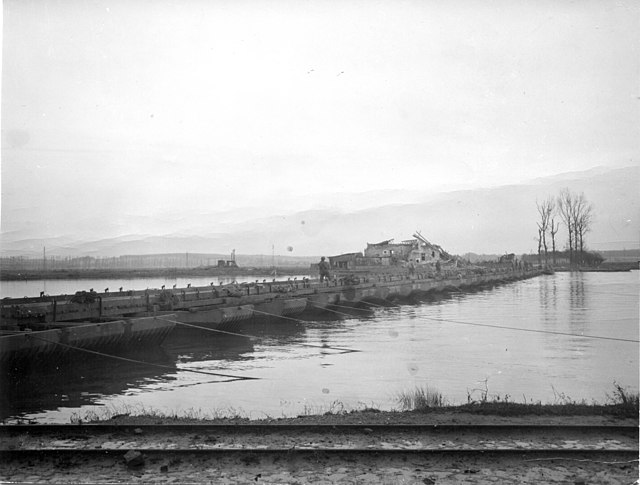 Western Front (1944) - Liberation of the Netherlands Western Front (1944) - Liberation of the NetherlandsIn the British Second Army area, XII Corps gets forward elements to the Maas River across from Roermond and takes Wessem. Photo: German prisoners captured by 53rd (Welsh) Division in Holland, 17 November 1944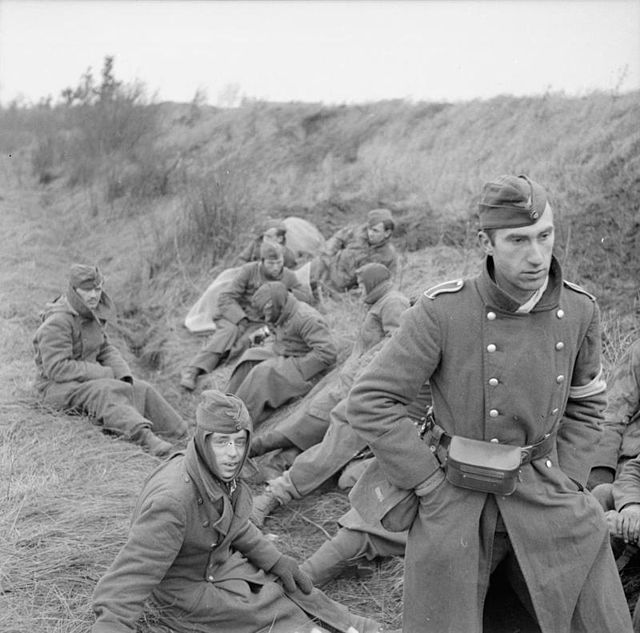 Western Front (1944) - Siegfried Line campaign Western Front (1944) - Siegfried Line campaignIn the U.S. First Army's VII Corps area, the 104th Infantry Division, renewing their effort to advance its right wing with a heavy volume of fire support, is still firmly opposed from the Donnerberg and makes slow progress, although Birkengang is largely cleared. Task Force Mills of Combat Command B, 3d Armored Division, gains a weak hold on the southern part of Hastenrath and Scherpenseel, but since its flank is exposed by the failure of 104th Infantry Division to advance, is precariously situated; German fire from the Eschweilcr Woods and the Donnerberg takes heavy toll of Combat Command B's armor, which by nightfall is at half its original strength. In the1st Infantry Division sector, the 47th Infantry Regiment eliminates German rear-guard opposition from Gressenich; the 16th Infantry Regiment, with tank support, advances almost to Hamich while the 26th Infantry gains a few hundred yards to the right. The Germans continue to contain the efforts of the 4th Infantry Division to advance through the Huertgen Forest. Photo: Seventh Army infantrymen move through rain and mist to assault a nearby town in the new advance on German held territory. Raon L'Etape area, France. 17 November, 1944 In the U.S. Ninth Army's XIX Corps area, Combat Command B, 2d Armored Division, withstands determined counterattacks against Immendorf and Puffendorf but loses a hill northeast of the latter; another attempt to take Apweiler fails; Combat Command A commits Task Force A to drive through Puffendorf toward Ederen but cannot get beyond Puffendorf. The 29th Infantry Division employs a battalion of the 116th Infantry Regiment, attached to the 115th Infantry Regiment, against Setterich, on the main highway and needed to support tanks of 2d Armored Division, but is unable to take it; nor do assault forces to the south succeed in clearing either Siersdorf or Bettendorf. The 30th Infantry Division makes progress in the heavily built up area on the southern flank of the corps, taking the village of Heengen on north and on the south clearing the rest of Wuerselen and overrunning Broichweiden. One hundred seventeen USAAF Fifteenth Air Force B-24s bomb the I.G. Farben synthetic oil refinery at Blechhammer with the loss of one aircraft. Air War over Europe Thirty USAAF Ninth Air Force bombers of the 9th Bombardment Division hit Haguenau, France; weather prevents over 100 bombers from attacking targets; fighters escort bombers, fly patrol and armed reconnaissance over a wide area of western Germany, and support the US 104th and 4th Infantry Divisions and 2d Armored Division, east of Aachen and near Hurtgen, Germany. Two hundred two USAAF Fifteenth Air Force B-24s bomb the Floridsdorf oil refinery in Vienna. Other targets hit in Austria are: 14 bomb the industrial area at Leoben, 11 each hit the railroad at St. Johann and the marshalling yard at Villach, four attack Vocklmarkt, and nine aircraft bomb other targets. A second raid by 117 B-17s hit the Main marshalling yard at Salzburg with the loss of one aircraft. Italian campaignDestroyer 'Woolsey' (DD-437) shells German artillery at Ventimiglia; shrapnel again showers the ship but she suffers no casualties; destroyer 'Benson' (DD-421) bombards barracks in same area. In the British Eighth Army's Polish II Corps area, hard fighting develops on Mt. Fortino, north of Converselle, which the Germans lose and then regain in a counterattack. USAAF Twelfth Air Force medium bombers hit rail bridges and viaducts in the northeast, concentrating on the Brenner Pass where ground haze and smoke screen at the Avisio viaduct hamper the attacks; fighter-bombers of the XXII Tactical Air Command cut rail lines, hit larger concentrations of railroad cars, and blast several ammunition and fuel dumps north of the battleline below Bologna; fighter-bombers closely supporting ground forces also hit guns and other military targets in battle area. During the night of 17/18 November, RAF aircraft of No. 205 (Heavy Bomber) Group bomb two airfields: 35 bomb Vicenza Airfield and 34 bomb the Main airfield at Udine. Battle of the Mediterranean For the first time in several months, USAAF Twelfth Air Force medium bombers attack targets in Yugoslavia, hitting bridges along the Brod-Zagreb- Maribor railroad. USAAF Fifteenth Air Force B-24s attack two targets: 30 bomb the marshalling yard at Maribor with the loss of one aircraft and one bombs the railroad at Dravograde. During the night of 17/18 November, 13 RAF bombers of No. 205 (Heavy Bomber) Group bomb a highway choke point at Novi Pasar. United StatesThe Combined Chiefs of Staff approve the proposal of Admiral Louis Mountbatten, Supreme Allied Commander South East Asia Command (SEAC), made in late October to clear the Arakan, Burma area along the northeast coast of the Bay of Bengal; reject the Kra Isthmus operation in the north central section of southwestern Thailand; and ask for a plan to develop the Cocos Islands in the Indian Ocean as a staging base. Photo: The U.S. Navy attack transport USS Eastland (APA-163) on 17 November 1944. She is painted in Camouflage Measure 32, Design 6A. The photo was taken by a blimp of squadron ZP-31. Eastland had been commissioned on 26 October 1944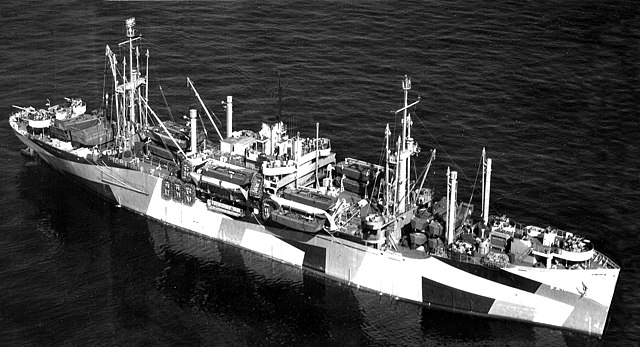 Photo: The U.S. Navy attack transport USS Missoula (APA-211) underway at sea on 17 November 1944. The ship is painted in Camouflage Measure 32, Design 4T. The photo was taken by a blimp of squadron ZP-31 Photo: The U.S. Navy attack transport USS Missoula (APA-211) underway at sea on 17 November 1944. The ship is painted in Camouflage Measure 32, Design 4T. The photo was taken by a blimp of squadron ZP-31 Photo: The U.S. Navy attack transport USS Drew (APA-162) underway on 17 November 1944. She is painted in Camouflage Measure 32, Design 4T. The photo was taken by a blimp of squadron ZP-31. Drew had been commissioned on 22 October 1944 Photo: The U.S. Navy attack transport USS Drew (APA-162) underway on 17 November 1944. She is painted in Camouflage Measure 32, Design 4T. The photo was taken by a blimp of squadron ZP-31. Drew had been commissioned on 22 October 1944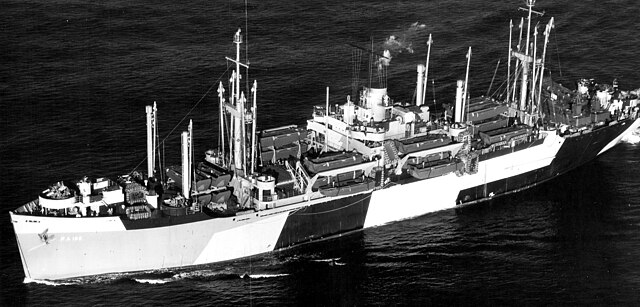 Belgium BelgiumAllied representatives meet with Belgian ministers over their differences with the resistance. Pacific War CHINA (Fourteenth Air Force): In China, 3 B-24s bomb Kowloon Docks, Hong Kong; 15 B-25s, in flights of 2 or 3 each, attack gun positions, storage areas, and village and town areas N of Chuchou, W of Nanyo, and at Chefang and Nanyo and S of Hpalen, Burma; also a bridge at Tingka is knocked out; 100+ P-40s and P-51s hit targets of opportunity throughout SE and SW China, concentrating on the Mangshih and Changsha areas. CHINA From the Kweilin-Liuchow area, the Japanese begin a drive on Kweiyang, possession of which would open way to Kunming, the Hump terminus, and Chungking, the capital. INDIA-BURMA (Tenth Air Force): In Burma, 33 P-47s hit troop and vehicle concentrations and supply areas at Manlu, Loi-Lum, Nawngmoloi, and Kyaukme; 10 P-47s support ground forces in the N Burma railroad corridor near Meza; 16 others sweep the rail line from Hsipaw to Sedaw hitting rolling stock, gun positions and other targets of opportunity while 3 bomb the Meza railroad station; 16 others strafe airfields at Nawnghkio, Anisakan, and Onbauk; 9 B-25s bomb bridges at Lashio, knocking out a bypass bridge and damaging others; several machinegun positions are silenced in the bridge area; transports continue to operate on large scale, flying 266 sorties to forward areas. Photo: A Royal Air Force Republic Thunderbolt Mark II (s/n HD298, "RS-U") of No. 30 Squadron RAF, taking off off from Chittagong, India, for a sortie over the Arakan front. HD298 (USAAF P-47D-27-RE s/n 42-26911) was wrecked when struck by Thunderbolt HD294 (USAAF 42-26907) on the ground at Chittagong on 17 November 1944 BURMA Photo: Troops cross the Chindwin River near Sittaung before pushing east to link with the 36th Infantry Division, 17 November 1944 SAIPAN (Seventh Air Force): In the Bonin Islands, 15 B-24s, flying a shipping strike out of Saipan Island, attack vessels SW of Muko Jima Island and the attack harbor and town of Okimura. SOUTHWEST PACIFIC AREA [Far East Air Force]:HQ 317th Troop Carrier Group moves from Hollandia, New Guinea to Leyte Island. JAPANESE OCCUPIED NETHERLANDS EAST INDIES In the Netherlands East Indies, USAAF Far East Air Forces B-25s fly heckling missions over northeastern Celebes Island. NEW GUINEA CAMPAIGN In Dutch New Guinea, USAAF Far East Air Forces B-25s continue to support ground forces on Mapia Island. PHILIPPINE CAMPAIGN (1944) In the U.S. Sixth Army's X Corps area on Leyte, a battalion of the 128th Infantry Regiment, 32d Infantry Division, gets to within 500 yards of Limon, but the 1st Battalion is still held up by the Japanese on the slopes of Corkscrew Ridge. USAAF Far East Air Forces B-24s bomb Sanbon Field at Legaspi on the southeastern tip of Luzon Island; on Mindanao Island, B-24s bomb Sasa and Likanan Airfields; other B-24s and B-25s fly heckling missions over the central Philippine Islands and Mindanao Island. ALASKA (Eleventh Air Force): 4 B-24s bomb Suribachi Airfield on Paramushiru; 2 fighters intercept and damage 1 B-24 which force-lands on Kamchatka, USSR. PACIFIC Attack transport Alpine (APA-92) is damaged by kamikaze off Leyte, 11°07'N, 125°02'E. Elsewhere, during a Japanese air raid on shipping off Red Beach, Leyte, freighter Benjamin Ide Wheeler is damaged by bombs; there are no casualties. TBM (VC 82) from escort carrier Anzio (CVE-57) and destroyer escort Lawrence C. Taylor (DE-415) sink Japanese submarine I-26 in Philippine Sea, 12°44'N, 130°42'E. Submarine Bluegill (SS-242) is damaged by depth charges in Makassar Strait, 00°48'N, 118°52'E, but remains on patrol. Submarines Burrfish (SS-312) and Ronquil (SS-396) battle Japanese guardboat Fusa Maru in a spirited surface gunnery action fought in heavy weather south of Hachiro Jima, central Honshu, 32°15'N, 140°00'E; American gunfire damages the enemy patrol craft, but not before she in turn damages Burrfish. Ronquil is damaged by own gunfire (premature explosion of 40-millimeter shell or contact with lifeline stanchion) and is forced to terminate her patrol. Fusa Maru is written off as a total loss and performs no more active service. Submarine Gunnel (SS-253) attacks Japanese convoy and sinks torpedo boat Hiyodori and merchant tanker Shunten Maru 130 miles east of Tourane, French Indochina, 16°56'N, 110°30'E. Destroyer Shiokaze and submarine chaser Ch 21's hunter-killer operations are ineffective. Submarine Picuda (SS-382) sinks Japanese landing ship Mayasan Maru and damages merchant tanker Awagawa Maru,33°16'N, 124°43'E. Submarine Spadefish (SS-411) sinks Japanese escort carrier Shinyo 140 miles northeast of Shanghai, China, in Yellow Sea, 33°02'N, 123°33'E, and damages landing ship Shinshu Maru. Submarine Sunfish (SS-281) damages Japanese army transport Edogawa Maru west of Quelpart Island, 33°40'N, 124°30'E; although Coast Defense Ship No.61 claims her destruction, Sunfish escapes. Edogawa Maru sinks the next day. PROJECT mike continues as USAAF B-24s (42d Bomb Squadron) lay 8 mines in effective locations in Futami Ko, Chichi Jima. USAAF P-38s sink Japanese ships Jinko Maru and No.3 Yawata Maru off Merida, 10°55'N, 124°30'E. Japanese merchant tanker Seian Maru runs aground off entrance to Subic Bay (see 19 November). Photo: Japanese trawler photographed through USS Albacore's periscope, 17 November 1944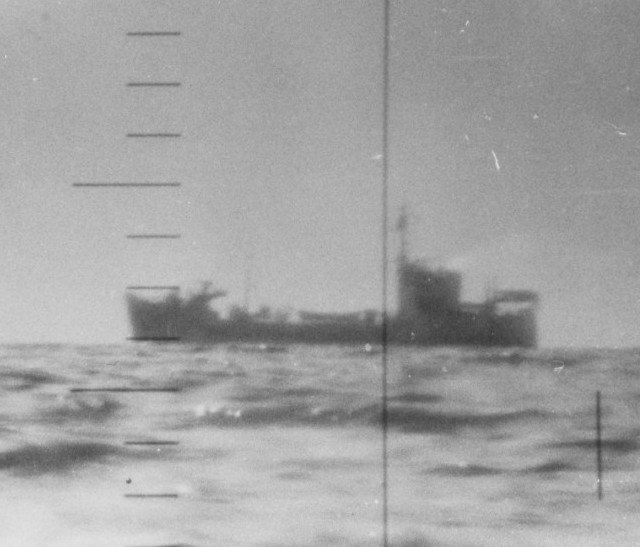
|
|
lordroel
Administrator
Posts: 68,033 
Likes: 49,431
|
Post by lordroel on Nov 18, 2023 9:32:16 GMT
Day 1895 of World War II, November 18th 1944YouTube (How Himmler Learned to Love the Russians)Eastern Front Soviet 8th Army (part of Leningrad Front) renew their efforts to win control of Gulf of Riga, stepping up action against the German garrison, which is clinging tenaciously to southern tip of Saaremaa Island. Lapland WarGermans leave the northernmost tip of Finland. Western Front (1944) - Liberation of FranceMap: HQ Twelfth Army Group situation map, November 18th 1944 In the U.S. Third Army's XX Corps area, the 10th Armored Division continues to pursue the Germans, Combat Command B columns reaching Launstroff and Schwerdorff and Combat Command A detachment reaching the Nied River opposite Bouzonville; finding a damaged bridge north of Bouzonville near Filstroff, the Combat Command A force begins crossing. The 90th Infantry Division races southward to cut off the retreating Germans; the 359th Infantry Regiment is committed and gets elements across the Nied River at Conde Northen; the 90th Reconnaissance Troop seizes Avancy. The 357th Infantry Regiment, on the division's left, is slowed by antitank ditches, mines, and craters. Task Force Bacon, 95th Infantry Division, pushes into the northeast part of Metz, overrunning Fort St Julien and Fort Bellacroix; the 95th Infantry Division forces west of Metz reach the Moselle River and find all bridges except one blown; the 377th Infantry Regiment clears the island formed by the Hafen Canal and the river; a 378th Infantry patrol starts across the Moselle bridge into Metz but the Germans blow the bridge, and other elements of the regiment begin an assault on Fort Plappeville; the 379th Infantry Regiment drives to the Moselle River at Moulins-ls-Metz, where a bridge is down. The 5th Infantry Division advances into Metz from the south: the 11th Infantry Regiment, leaving elements behind to contain Fort St Privat, pushes into the city and begins clearing the southern part; some elements of the 10th Infantry drive into Metz while others remain behind at Fort Queuleu; the 2d Infantry Regiment advances northward as quickly as possible in an effort to make contact with the 90th Infantry Division and complete the encirclement of Metz, overrunning Courcelles-sur- Nied and Ars-Laquenexy. XII Corps renews a drive toward the Sarre River with two divisions abreast after preparatory fire. The 35th Infantry Division takes Bistroff and positions east of Vallerange. the 26th Infantry Division attacks to the right of the 35th Infantry Division against the German Dieuze-Benestroff line and pushes through Bois de Benestroff and recapturing Guebling with the assistance of tanks and tank destroyers and drives to edge of Bourgaltroff. In the U.S. Seventh Army's XV Corps area, the 79th Infantry Division begins assault on Fremonville; elements find Blamont clear of Germans. In VI Corps area, the 100th Infantry Division attacks Raon-l'Etape, the 397th Infantry Regiment pushing into town and 398th Infantry starting across the Plaine River. The 36th Infantry Division is closing along the Meurthe River on the southern flank of corps and gains positions overlooking Gerardmer. In the French First Army's I Corps area, the 5th Armored and 2d Moroccan Divisions are closing in on Belfort on the northern flank of the corps. The 1st Armored Division, assisted by the 9th Colonial Division, drives 7 miles through Belfort Gap between the Rhine-Rhone Canal and the Swiss border to Delle; from the Allaine River, where the Germans are holding out at Morvillars, the 1st Armored Division reconnoiters east toward the Rhine River, taking Faverois, Courtelevant, Suarce, and Joncherey. Photo: S.S. LEE S. Overman ("Liberty" Ship) sunk in shallow water off Le Havre, France, November 18, 1944. She had struck a mine a few days earlier. Note: Date may be wrong. Some sources give this ship's loss date as December 11, 1944 Western Front (1944) - Siegfried Line campaign Western Front (1944) - Siegfried Line campaignIn the British Second Army area, XXX Corps begins an offensive to reduce the Geilenkirchen salient (Operation CLIPPER), driving northeast with the 43d Division on the left and the U.S. 84th Infantry Division, reinforced by the British Drewforce (flail tanks and searchlight battery), on the right. The 43d Division secures Tripsrath and most of Bauchem. The 334th Infantry Regiment, 84th Infantry Division, takes Prummern; continuing their assault after nightfall with the aid of searchlights, gains a position dominating Sueggerath but is unable to take the high ground, called Mahogany Hill, northeast of Prummern. Geilenkirchen is now surrounded on three sides. Photo: Troops of the 7th Somerset Light Infantry, 43rd (Wessex) Division resting during the assault on Geilenkirchen in Germany, 18 November 1944 Photo: Universal carriers of 43rd (Wessex) Division advance along a muddy lane during the advance on Geilenkirchen, 18 November 1944 Photo: Universal carriers of 43rd (Wessex) Division advance along a muddy lane during the advance on Geilenkirchen, 18 November 1944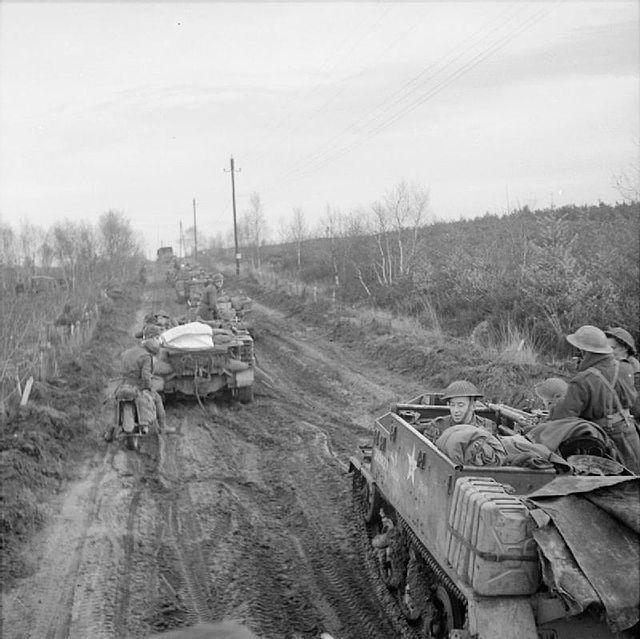 Photo: A Sherman tank carrying infantry of 43rd Division advances towards Geilenkirchen, 18 November 1944 Photo: A Sherman tank carrying infantry of 43rd Division advances towards Geilenkirchen, 18 November 1944 In the U.S. Ninth Army's XIX Corps area, Combat Command B of 2d Armored Division, after repelling a minor counterattack against Immendorf, takes Apweiler in a limited attack, then pauses while the 29th Infantry Division is clearing Setterich. The 29th Infantry Division, with close tank and artillery support, makes substantial progress, the 116th Infantry Regiment gaining a firm foothold in Setterich and other elements penetrating the outer defenses of Juelich to take Siersdorf and Bettendorf. The 30th Infantry Division continues to mop up Broichweiden and seizes Warden, southeast of Mariadorf, after being twice driven off. In the U.S. First Army's VII Corps area, the 104th Infantry Division seizes most of the Donnerberg and breaks into Eschweiler Woods as the German opposition slackens. Task Force Mills of Combat Command B, 3d Armored Division, assisted by reserves, takes .Hastenrath and Scherpenseel; Combat Command B then goes on the defensive. The 16th Infantry Regiment, 1st Infantry Division, committing its full strength, takes Hill 232, key to Hamich Ridge, and clears most of town of Hamich as the 26th Infantry Regiment continues slowly toward its first objective, Laufenburg Castle. The Germans make several strong efforts to regain Hamich and Hill 232. The 4th Infantry Division advances in the Huertgen Forest, where the 8th Infantry Regiment, in 1,000-yard (914 meter) drive, penetrates the outer defenses of the approach to Dueren and the 22d Infantry Regiment reaches positions astride the road leading east to Grosshau, but a gap exists between the regiments. Photo: M10 TDs move up in the Hurtgen forest, November 18, 1944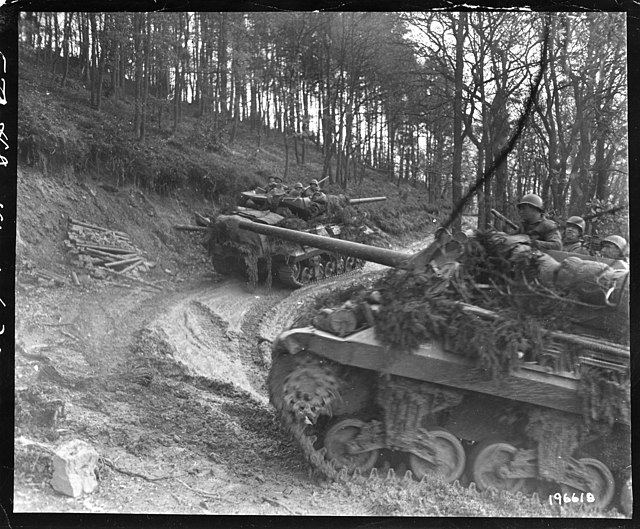 Air War over Europe Air War over Europe USAAF Fifteenth Air Force B-17s and B-24s attack two oil refineries in Vienna: 131 hit the Floridsdorf refinery with the loss of three aircraft while 71 bomb the Korneuburg refinery. The USAAF Eighth Air Force flies Mission 716: 402 fighters (47 P-47 Thunderbolts and 355 P-51s) are dispatched to strafe oil storage depots in the Hanau and Ulm areas, airfields at Leipheim and Lechfeld, and miscellaneous ground targets; 374 actually attack. About 70 Luftwaffe fighters are encountered and the USAAF pilots claim 26-2-6 in the air and 69-0-41 on the ground. Two P-47s and five P-51s are lost. During the day, RAF Bomber Command dispatches 479 aircraft, 367 Halifaxes, 94 Lancasters and 18 Mosquitos, to attack Munster; 444 bomb the city. The raid was not concentrated and bombs fell in all parts of Munster. During the night of 18/19 November, RAF Bomber Command dispatches 285 Lancasters and 24 Mosquitos to bomb the Krupp Treibstoff synthetic oil refinery at Wanne-Eikel; 295 bomb the target. The intention of the raid is to hit the local oil plant. Large explosions seem to erupt in the plant and post-raid reconnaissance shows that some further damage is caused to it. The local report does not mention the oil plant but states that the Hannibal coal mine is destroyed. Meanwhile, Mosquitos hit five targets: 31 fly a "spoof" raid to Wiesbaden; 18 hit Hannover; three bomb Erfurt; and one each attack Kassel and Rheinburg. Over 340 USAAF Ninth Air Force bombers of the 9th Bombardment Division strike barracks areas, rail bridges, rail facilities, strongpoints, and defended positions at 13 locations in Germany; fighters escort the bombers, fly sweeps and armed reconnaissance over western Germany, and support ground forces east of Aachen, Germany and in the Sarreguemines, France area. During the night of 18/19 November, USAAF Eighth Air Force flies Mission 717: four B-24s and six B-17s drop leaflets in Belgium, the Netherlands and France. USAAF Twelfth Air Force medium bombers bomb a bridge at Zidani Most and also hit the Brod-Ljubljana railway, the principal German escape route in the Balkans. Sixteen USAAF Fifteenth Air Force bombers attack the city and troop concentrations at Visegard. During the night of 18/19 November, RAF bombers of No. 205 (Heavy Bomber) Group attack four targets: 42 hit the West marshalling yard at Sarajevo; 19 bomb tactical targets at Sjenica; 16 attack tactical targets at Novi Pasar; and one bombs tactical targets at Pribaj. Italian campaign The British Eighth Army orders a co-ordinated attack toward Faenza by V Corps and the Polish II Corps, beginning on 20 November. In the Polish II Corps area, the 3d Carpathian Division takes over from the 5th Kresowa Division in Mt. Fortino area and prepares to attack. USAAF Twelfth Air Force medium bombers bomb bridges at Pizzighettone, Romano di Lombardia, Castelnuovo di Garfagnana, Migazzone, Casarsa della Delizia, and Casale Monferrato while fighter-bombers continue successful attacks on rail lines, dumps, guns, and pipelines in the northern Apennines and the Po Valley, XXII Tactical Air Command claiming 100+ train cars, eight locomotives, and nearly 75 vehicles destroyed. During the night of 18/19 November USAAF Twelfth Air Force A-20s on armed reconnaissance bomb Ghedi Airfield and targets in the Bologna, Ferrara, Mantua, Cremona, and Parma areas. USAAF Fifteenth Air Force bombers hit four airfields with the loss of four aircraft: 147 bomb Vincenza Airfield; 115 hit Aviano Airfield; 109 attack Udine Airfield and 96 bomb Villa Franca Airfield. United StatesPhoto: The U.S. Navy attack transport USS Chilton (APA-38) off Boston, Massachusetts (USA) on 18 November 1944. She is painted in Camouflage Measure 32, Design 3D Photo: The U.S. Navy destroyer escort USS Robert Brazier (DE-345) underway off New York City (USA) on 18 November 1944. Robert Brazier had the short mast with the HF/DF antenna, but retains the torpedo tubes. She is painted in Camouflage Measure 32, Design 3D Photo: The U.S. Navy destroyer escort USS Robert Brazier (DE-345) underway off New York City (USA) on 18 November 1944. Robert Brazier had the short mast with the HF/DF antenna, but retains the torpedo tubes. She is painted in Camouflage Measure 32, Design 3D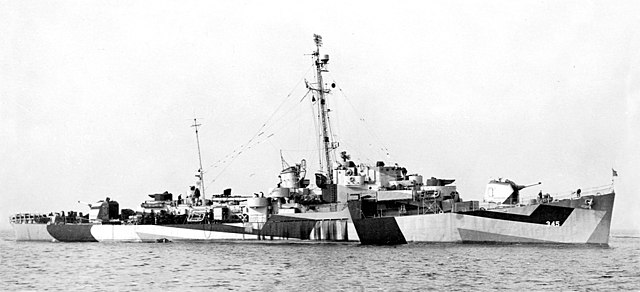 Belgium BelgiumBelgian resistance representatives agree to surrender their arms. Pacific WarCHINA (Fourteenth Air Force): In China, 10 B-25s blast stores at Hengshan and hit populated areas from Ishan to Liuchow; 130+ P-51s, P-40s, and P-38s pound targets of opportunity scattered over vast areas of S China; troops, shipping, supplies, trucks, and railroad targets are hit particularly hard N of Lingling, from Liuchow to Ishan, from Hengshan to Hengyang, from Kweilin to Liuchou, from Siangtan to Paoching, and at Chuanhsien, Hwaiyuanchen, Chingmen, Chuchiang, and Shihkiachwang. INDIA-BURMA (Tenth Air Force): In Burma, 27 fighter-bombers support ground forces S of Pinwe and in the Bhamo area; 16 attack troops and supply area at Panglong and Nga-pwegyi while 7 hit the ferry area at Meza; 20 hit targets of opportunity along the Kanbalu-Wuntho railroad and at Maymyo and Wetwin; 9 B-25s pound Man Pwe rail yards, destroying warehouses and other buildings and causing much general damage. Transports continue large-scale operations to forward areas. In India, the detachment of the 317th Troop Carrier Squadron (Commando), 2d Air Commando Group, operating from Tulihal with C-47s returns to base at Sylhet. SAIPAN (Seventh Air Force): B-24s from Saipan and Guam hit shipping at Chichi Jima and Haha Jima. P-38s and B-24s from Saipan escort photo planes over Iwo Jima. Project MIKE continues as USAAF B-24 Liberators lay 12 mines in effective locations in Futami Ko, Chichi Jima. SOUTHWEST PACIFIC AREA [Far East Air Force]: HQ 58th FG and the 310th and 311th Fighter Squadrons move from Noemfoor to San Roque with P-47s. 66th Troop Carrier Squadron, 433d Troop Carrier Group, moves from Nadzab to Biak with C-47s. Lost is P-61 42-5515. JAPANESE OCCUPIED NETHERLANDS EAST INDIES USAAF East Air Force B-24s, with P-38s and P-47s supporting, launch a major strike against oil installations at Tarakan, Dutch Borneo; other B-24s and B-25s hit shipping off Tarakan and in Brunei Bay, Brunei On Celebes Island in the Netherlands East Indies, B-24s bomb the Makassar and Kendari area and the Polewali shipyards. Other B-24s bomb airfields in the Ceram Island-Ambon Island area while P-38s strafe shipping. RAAF No. 22 Squadron flying (A-20C) Boston Mk. IIIs fly their first mission from Morotai against targets on northern Celebes Island. NEW GUINEA CAMPAIGN In Dutch New Guinea, USAAF Fifth Air Force B-25s continue to support ground forces on Mapia Island off the northwest coast of New Guinea. PHILIPPINE CAMPAIGN (1944) In the U.S. Sixth Army's X Corps area on Leyte, the 3d Battalion of 128th Infantry Regiment, 32d Infantry Division, halts on a ridge 500 yards north of Limon to await the 1st Battalion, which is still battling the Japanese on Corkscrew Ridge. Positions of the 1st Battalion, 34th Infantry Regiment, on Kilay Ridge are seriously threatened and under heavy fire. USAAF Far East Air Force B-24s, B-25s and A-20s again hit airfields and targets of opportunity on Mindanao Island. Fighter-bombers, A-20s and B-25s over several locations in the Philippine Islands attack shipping, supply and personnel areas, harbors, barges, airstrips, and communications targets. In the Philippine Sea, USN destroyer escort USS Lawrence C. Taylor and a TBM Avenger of Composite Squadron Eighty Two in the escort aircraft carrier USS Anzio, sink Japanese submarine HIJMS I-41 about 345 nautical miles ENE of Tacloban, Leyte, Philippine Islands in position 12.44N, 130.42E. This is the second submarine sunk by these units in two days. Photo: The U.S. Navy escort carrier USS Makin Island (CVE-93) underway in the southwestern Pacific, near Leyte, Philippine Islands, 18 November 1944. The ship is wearing Camouflage Measure 32, Design 16A Photo: The U.S. Navy high-speed transport USS George E. Badger (APD-33) in Leyte Gulf, Philippine Islands, on 18 November 1944, during the early stages of the Leyte invasion. She is painted in what appears to be Camouflage Measure 31, Design 12T Photo: The U.S. Navy high-speed transport USS George E. Badger (APD-33) in Leyte Gulf, Philippine Islands, on 18 November 1944, during the early stages of the Leyte invasion. She is painted in what appears to be Camouflage Measure 31, Design 12T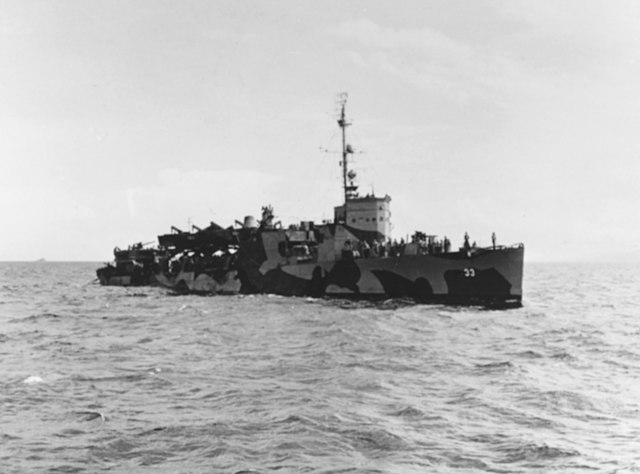 ALASKA (Eleventh Air Force): On Paramushiru Island, 4 B-24s strike Suribachi shore batteries, including one on Takikawa Cape. A shipping sweep by 6 B-25s is cancelled due to weather. PACIFIC Destroyer escort Lawrence C. Taylor (DE-415) and TBM (VC 82) from escort carrier Anzio (CVE-57) sink Japanese submarine I-41 in Philippine Sea, 12°44'N, 130°42'E. Submarine Pampanito (SS-383) sinks Japanese depot ship No.17 Banshu Maru and merchant cargo ship No.1 Shinko Maru, 19°12'N, 110°51'E. Submarines Peto (SS-265), Spadefish (SS-411) and Sunfish (SS-281) operate against the same Japanese convoy attacked the previous day in the East China Sea west of Saishu Island, Peto sinks army cargo ships Aisakasan Maru, 33°50'N, 124°44'E, and Chinkai Maru, 33°39'N, 124°26'E; Spadefish sinks auxiliary submarine chaser Cha 156, 33°07'N, 123°19'E; Sunfish sinks army transport Seisho Maru, 33°36'N, 124°18'E. Submarine Saury (SS-189) damages Japanese merchant cargo ship No.11 Asahi Maru, 30°50'N, 141°56'E. Japanese planes raid U.S. shipping off Leyte; freighter Nicholas J. Sinnott is near-missed by a kamikaze, 11°15'45"N, 125°02'45"E. There are no casualties among the 40-man merchant complement, the 80 Army passengers or the 26-man Armed Guard. Off Tacloban, Armed Guard gunners on board freighter Gilbert Stuart shoot the tail off a kamikaze which nevertheless crashes their ship, triggering fires that are ultimately brought under control with the help of fleet tug Chickasaw (ATF-83). While 5 of the 39-man merchant complement perish in the attack, only 1 of the 29-man Armed Guard is killed in action. Freighter Cape Romano is damaged by near-miss of bomb. PROJECT Mike continues as USAAF B-24s (42d Bomb Squadron) lay 12 mines in effective locations in Futami Ko, Chichi Jima. B-24s sink auxiliary sailing vessel Sumiei Maru off Haha Jima. Off Borneo, aircraft damage Japanese escort destroyer Okinawa off Labuan. Guardboats No.6 Kompira Maru, Benten Maru, and Eikoku Maru are sunk by U.S. aircraft off Tarakan.
|
|
lordroel
Administrator
Posts: 68,033 
Likes: 49,431
|
Post by lordroel on Nov 19, 2023 9:09:57 GMT
Day 1896 of World War II, November 19th 1944Eastern Front In Albania, Partisan forces commanded by Hodja enter Tirana after German forces pull out of the city. Western Front (1944) - Liberation of FranceMap: HQ Twelfth Army Group situation map, November 19th 1944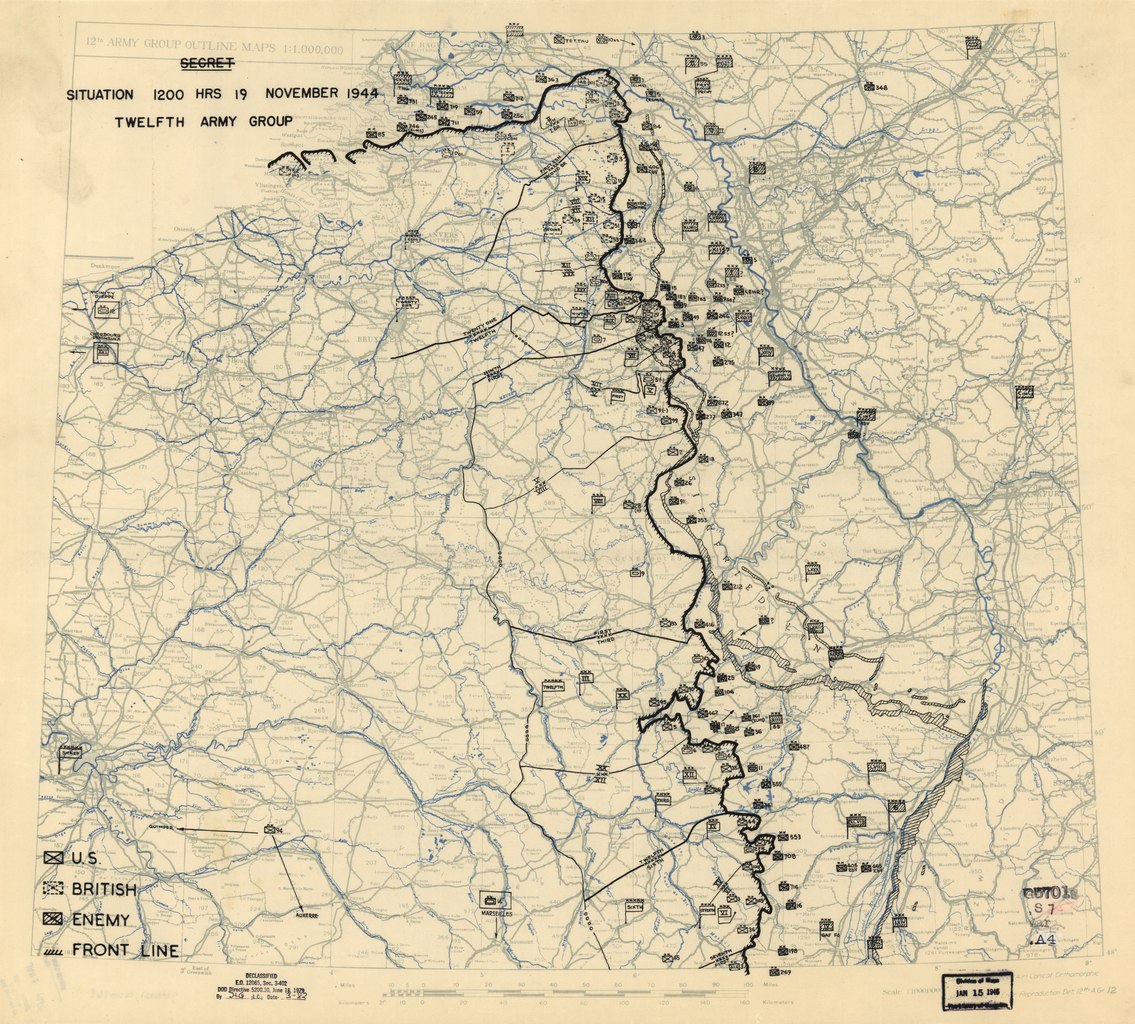 In the U.S. Third Army area, XX Corps closes circle around Metz as the 90th, 95th, and 5th Infantry Divisions join hands. The 90th Infantry Division concludes its operations against Metz and halts upon order along the Nied River: the 357th Infantry Regiment drives to the Nied west of Boulay-Moselle; the 359th plugs a German escape route at Les Etangs; the Reconnaissance Troop establishes contact with 5th Infantry Division. Task Force Bacon, 95th Infantry Division, is clearing the streets in the northeast part of Metz; the 377th and 378th Infantry Regiments drive into Metz from the northwest, crossing the Moselle River. The 5th Infantry Division continues to clear the southern part of Metz The 10th Armored Division, in order to speed their drive to the Sarre River, withdraws Combat Command A's Nied bridgehead, during the nigh of 19/20 November, and blows the bridges. In the XII Corps area, Combat Command B of 6th Armored Division begins attack through the 137th Infantry Regiment of 35th Infantry Division and, assisted by the 137th, takes Bertring and Gros Tenquin; Virming falls to 320th Infantry Regiment. The 26th Infantry Division commits its full strength to attack against the Dieuze-Bonestroff line, meeting stiff opposition from German forces covering a general withdrawal, which is accomplished during the night of 19/20 November: the 104th and 101st Infantry Regiments fight in vain for Marimont and Marimont Hill (Hill 334) during the day but move forward as the Germans withdraw after nightfall; the 328th Infantry Regiment, reinforced by elements of the 4th Armored Division, is committed against Dieuze arid, upon the German withdrawal, enters together with the 2d Cavalry Group and takes the bridge intact. Combat Command A, 4th Armored Division, enters the battle in the zone of the 26th Infantry Division, recapturing Rodalbe and helping the 320th Infantry Regiment of 35th Infantry Division to take Virming. Photo: M4 medium tank passing through St. Pole to take part in the drive on Dadonville, 19 November, 1944 In the U.S. Seventh Army's XV Corps area, the 44th Infantry Division, pushing toward Sarrebourg, takes Ibigny and St Georges. The German line along the Vezouse River in the Blmont-Cirey area collapses as the 79th Infantry Division completes the capture of Fremonville and Combat Command R, French 2d Armored Division, takes Cirey. To exploit the breakthrough, Combat Command L begins a drive to secure Saverne Gap, through which the advance can be continued to Strasbourg. The 79th Infantry Division, instead of helping the 44th Infantry Division take Sarrebourg, is to exploit the success of French armor and protect the southern flank of the corps. The VI Corps closes along the Meurthe River and prepares to attack across it. The 100th Infantry Division, already east of the Meurthe River, continues to advance in the Raon area, the 398th Infantry Regiment pushing south across the Plaine River to gain control of the road southeast from the town and the 397th Infantry working on a quarry strongpoint at the edge of town. The Division Reconnaissance Troop and the 117th Reconnaissance Squadron advance to Badonviller without opposition. In the French First Army's I Corps area, the 2d Moroccan Division, supported by the 5th Armored Division, reaches Chalonvillars, a suburb of Belfort. The 1st Armored Division tries unsuccessfully to open a route to Dannemarie so that 5th Armored Division may drive on Cernay via Fontaine; continuing reconnaissance eastward along three routes on the right flank, gets elements to the Rhine River at Rosenau at 1830 hours. The French are thus the first of the Allied forces to reach the Rhine, but on a narrow front in a sector where the road net is too poor to support an advance in strength. Among the villages taken, Seppois is the first in Aisace to be recovered by the French. Western Front (1944) - Liberation of the NetherlandsThe British XII and VII Corps advance near Venlo. Western Front (1944) - Siegfried Line campaignIn the British Second Army's XXX Corps area, 334th Infantry Regiment of the U.S. 84th Infantry Division continues to clear the Prummern area and tries in vain to take Mahogany Hill; the 333d Infantry attacks up the Wurm River valley toward Wurm, taking Geilenkirchen and Sueggerath. In the XII Corps area, the 51st Division takes Helden and Panningen and makes contact with the 15th Infantry Division of VIII Corps. Photo: Churchill AVRE of 617th Assault Squadron Royal Engineers near Geilenkirchen, 19 November 1944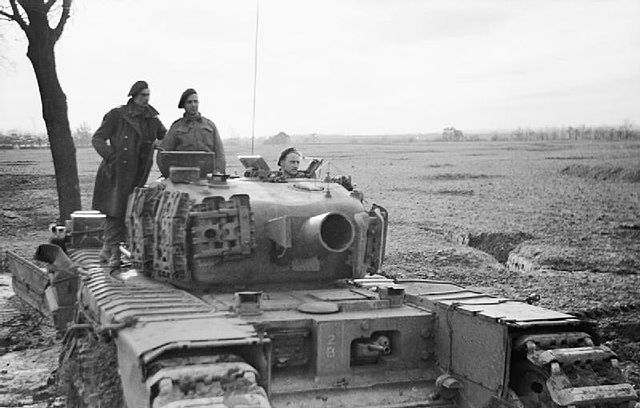 Photo: Churchill AVRE entering Geilenkirchen, 19 November 1944 Photo: Churchill AVRE entering Geilenkirchen, 19 November 1944 Photo: Sherman tanks in Gillrath, Germany, 19 November 1944 Photo: Sherman tanks in Gillrath, Germany, 19 November 1944 In the U.S. Ninth Army's XIX Corps area, Combat Command B of the 2d Armored Division repels determined counterattack against Apweiler. Combat Command A, reinforced by a battalion of the bn of the 119th Infantry Regiment, 30th Infantry Division, attacks in two columns from Setterich and Puffendorf toward a spur of high ground between Ederen and Frelaldenhoven, one column reaching positions near Freialdenhoven. The 29th Infantry Division clears the rest of Setterich and an antitank ditch east of the village and then advances to take the villages of Duerboslar and Schleiden. The 30th Infantry Division’s 117th Infantry Regiment, with powerful support of heavy weapons, easily takes St Joeris and Kinzweiler. In the U.S. First Army's VII Corps area, the 104th Infantry Division mops up and shifts its main weight of attack to the Eschweiler-Weisweil er industrial complex north of the Inde River. On the north flank of the 1st Infantry Division, the 47th Infantry Regiment column drives northwest along Hamich Ridge from Hill 232 to the base of Hill 187; the 16th Infantry Regiment finishes clearing Hamich and pushes to the southern part of Bovenberger Wald; the reserve regt, the 18th Infantry, begins an attack in the center of the division line toward Langerwehe. previously the objective of the 26th Infantry Regiment, reaching the vicinity of Wenau; the 26th Infantry, whose objectives are now Juengersdorf and Merode, commits reinforcements and advances to positions less than 500 yards from Laufenburg Castle. The 4th Infantry Division suspends eastward attacks in order to consolidate and try to close gap between the 8th and 22d Infantry Regiments. In the V Corps area, Lieutenant General Courtney Hodges orders the corps to begin offensive on 21 November instead of waiting as planned until VII Corps has broken through the German defenses west of the Roer River in order to assist VII Corps. In the U.S. Third Army area, XX Corps area, Combat Command B, 10th Armored Division, is meeting stiffer opposition as it approaches Merzig and the Saar River. Air War over Europe USAAF Fifteenth Air Force B-24s and B-17s bomb four targets in Vienna and targets in five cities. In Vienna, 143 bomb the Winerhafen oil storage facility, 98 hit the Lobau oil refinery, 52 attack the Schwechat benzine synthetic oil refinery and 56 bomb the Vosendorf oil refinery; three aircraft are lost. Other targets are: 54 bomb the Hermann Goering benzine synthetic oil refinery at Linz, 45 hit Horsching Airfield, 13 attack the aircraft engine plant at Wiener Neudorf and one each bomb the marshalling yard at Leoben and a railroad bridge. One USAAF Fifteenth Air Force bomber bombs a railroad, a target of opportunity. USAAF Fifteenth Air Force bomber attack two targets: 24 aircraft bomb the marshalling yard at Gyor and six bomb the marshalling yard at Kesztheley. Over 450 USAAF Ninth Air Force A-20s, A-26s, and B-26s bomb storage depots, bridge, junction, ordnance depots, and defended positions in or near ten German towns and cities; fighters escort the bombers, carry out patrols, and fly armed reconnaissance hitting rail facilities and other targets over western German areas including Euskirchen, Trier, Saarbrucken, Julich, and Cologne; the IX, XIX, and XXIX Tactical Air Commands support the US VII, XII, XIX, and XX Corps areas east of Aachen and near Hurtgen, Germany, between Metz, France and Saarlautern, Germany and near Sarreguemines, France. RAF bombers of No. 205 (Heavy Bomber) Group hit four targets during the day: 65 bomb troop concentrations at Podgorica, 42 attack a pontoon bridge at Visegard, 15 hit troop concentrations at Sjenica with the loss of two aircraft, and 15 bomb troop concentrations at Novi Pasar. Italian campaign Fog and low clouds force cancellation of USAAF Twelfth Air Force missions against western Po Valley targets and limit fighter-bombers to a midday attack on rail lines, guns, troop concentrations, motor transport, and other military targets in and near the battle area south of Bologna. During the night of 19/20 November, USAAF Twelfth Air Force A-20s attack Po River crossings, airfields and lights in the Po Valley. Battle of the Mediterranean Land Forces Greece and Military Liaison Greece are integrated as Headquarters Land Forces and Military Liaison Greece, under Lieutenant General Sir Ronald Scobie, General Officer Commanding British Troops in Greece. United States Looking for ways to fund World War II, President Franklin D. Roosevelt announces the 6th War Loan Drive today. The Loan Drive floods the market with war bonds intended to meet Roosevelt's goals of "immediately" raising US$14 billion (US$ 242.16 billion in year 2023 dollars) for the war. Photo: The U.S. Navy attack transport USS Hansford (APA-106) in San Pedro Bay, 19 November 1944. The last four ships built at Western Pipe and Steel Company (APA-106 to APA-109) had two pairs of kingposts connected at the top by light lattice trusses. They also received the additional pair of short kingposts just forward of the bridge introduced in USS Barnstable (APA-93) Pacific War Pacific WarCHINA (Fourteenth Air Force): 3 B-24s bomb Samah Bay docks on Hainan Island. In China, 10 B-25s damage 2 buildings N of Chefang and score hits on bridges at Tingka and Wan Lai-Kam, Burma; 8 P-40s and P-38s hit targets of opportunity S of Tingka and Chefang; 19 P-40s blast troops and river, rail, and road traffic in the Hankow area; 27 P-40s, P-51s, and P-38s hit numerous targets of opportunity in the Mangshih area. The 35th Photographic Reconnaissance Squadron, Fourteenth AF, based at Chanyi, sends a flight to operate from Suichwan with F-5s. INDIA-BURMA (Tenth Air Force): In Burma, 15 P-47s support ground forces attacking Bhamo and fighting in the Pinwe area; 36 P-47s pound enemy concentrations at Man Mao, Sekang, and Manlu. Transports fly 290 sorties to forward areas. BURMA In the British Fourteenth Army's IV Corps area, the Indian 19th Division begins crossing the Chindwin River at Sittaung. GUAM (Seventh Air Force): 5 B-24s from Guam on armed reconnaissance over Iwo Jima and bomb airfields on Iwo Jima while 15 hit shipping at Chichi Jima and Haha Jima Islands. 1 B-24 from Angaur Airfield bombs Legaspi Airfield. SOUTHWEST PACIFIC AREA [Far East Air Force]: Units moving to Leyte Island: HQ 312th BG and the 386th, 387th, 388th and 389th Bombardment Squadrons from Hollandia, New Guinea with A-20s; 2d Bombardment Squadron (Heavy), 22d BG (Heavy), from Owi with B-24s; 39th Troop Carrier Squadron, 317th Troop Carrier Group, from Hollandia; 403d Bombardment Squadron (Heavy), 43d BG (Heavy) from Owi with B-24s. Lost is B-24J 44-41258. JAPANESE OCCUPIED NETHERLANDS EAST INDIES USAAF Far East Air Forces B-25s hit Sidate, Mapanget, and Borebore on Celebes Island while other B-25s and A-20s hit airfields and shipping in the Ceram Island-Ambon Island-Boeroe Island area. NEW GUINEA CAMPAIGN In Dutch New Guinea, elements of Task Group 78.14 land Army troops, a company of the 124th Infantry Regiment, 31st Infantry Division, U.S. Eighth Army, on Asia Island, 100 nautical miles W of Sansapor. The landing is supported by USAAF Far East Air Forces B-25s and A-20s. PHILIPPINE CAMPAIGN (1944) The 77th Infantry Division, en route to Leyte, is ordered to release a detachment of some 1,200 men, upon landing, for a projected operation against Mindoro. In the U.S. Sixth Army's X Corps area on Leyte, the 1st Battalion of the 128th Infantry Regiment, 32d Infantry Division, continues efforts to drive the Japanese from Corkscrew Ridge. The 1st Battalion of the 34th Infantry Regiment, still under heavy fire on Kilay Ridge, withdraws 100 yards N, abandoning the knoll on the south. USAAF Far East Air Forces B-24s bomb Alicante on the northeast of Negros Island and Palompon on Leyte Island while P-47s hit the Valencia, Mindanao Island, and Ormoc, Leyte Island areas. On Mindanao Island B-24s hit Libby Aerodrome while others bomb airfields at Sasa. One USAAF Seventh Air Force B-24 from Angaur Island, Palau Islands, Caroline Islands, bombs Sanbon Field near Legaspi on Luzon Island. TF 38 (Vice Admiral John S. McCain) aircraft attack Japanese shipping off Luzon, in addition to airfields on that island. Navy carrier-based planes attack convoy ten miles off San Fernando, sinking merchant cargo ship Esashi Maru and damaging escorting submarine chasers Ch 19 and Ch 26, 16°50'N, 120°08'E. UNITED STATES NAVY DEPARTMENT COMMUNIQUES, CINCPAC COMMUNIQUÉ NO. 184, NOVEMBER 19, 1944 Before dawn on November 10 (West Longitude Date) ships of the Pacific Fleet bombarded installations on Iwo Jima in the Bonins. Several explosions were observed after the first salvos. Large fires ashore were started, which could be seen by ships 35 miles away. The enemy apparently was surprised, and his shore batteries replied ineffectively to our fire, causing no damage or casualties to our forces. Only one enemy plane was in the air. On November 14 units of the 81st Army Division reoccupied Ngeregong Island in the Palaus without resistance. The island had been occupied by an enemy force of approximately 200 men on the night of November 7 8 (reported in communiqué Number 181) which meanwhile had been heavily attacked with bombs and gunfire. Corsairs and Hellcats of the Second Marine Aircraft Wing with Navy search Liberators of Fleet Air Wing One bombed enemy held islands in the Northern Palaus on November 14, destroyed vehicles and barges and starting fires in ammunition dumps. Fighters of the Second Marine Air¬craft Wing pounded the airfield on Yap the same day. Navy search Liberators of Fleet Air Wing One attacked Haha Jima and Iwo Jima in the Bonins on November 14. On the next day Navy search Liberators hit Chichi Jima and Haha Jima. One coastal cargo ship was hit at Chichi Jima. Liberators of the Seventh Army Air Force on November 16 sank one medium cargo ship at Haha Jima in the Bonins and caused explosions and fires in two other cargo ships. Other Liberators of the Seventh Army Air Force the same day struck at shipping in Chichi Jima, and Navy search Liberators of Fleet Air Wing One bombed Okimura Town on Haha Jima. Results were not observed. From November 14 to 16 Marine units on Saipan killed 248 and captured 47 Japanese in a drive to clear the island of remnants of the enemy garrison. A number of machine guns were captured. Our losses were nine killed and 40 wounded. Fighters of the Second Marine Aircraft Wing blasted airfields at Yap on November 16. Fires were started in fuel storage spaces and storage buildings In the Northern Palaus. Avengers and Corsairs of the Second Marine Aircraft Wing hit Rota on November 17. Eleventh Army Air Force Liberators on November 16 bombed Suribachi in the Northern Kuriles. Meager antiaircraft fire was met. Fighters of the Seventh Army Air Force made strafing attacks on Pagan in the Marianas on November 15. The Fourth Marine Aircraft Wing continued neutralizing attacks in the Marshalls on November 16. PACIFIC Elements of TG 78.14 (Captain Lord Ashbourne, RN) land Army troops (31st Division) on Asia Island, 100 nautical miles west of Sansapor. Destroyer escorts Conklin (DE-439) and McCoy Reynolds (DE-440) sink Japanese submarine I-37, 100 miles west of Palaus, 08°07'N, 134°16'E.29 Submarine Hake (SS-256) torpedoes Japanese light cruiser Isuzu west of Corregidor, 14°22'N, 119°38'E. British submarine HMS Stratagem sinks Japanese merchant tanker Nichinan Maru in Malacca Strait, 01°36'N, 102°53'E. U.S. freighter Alcoa Pioneer is crashed by kamikaze, San Pedro Bay, Leyte, killing 6 of the 28-man Armed Guard. Thirteen other men from among the 46-man merchant complement and two passengers are injured; patrol escort vessel PCE-851 provides medical assistance. Nearby, a second kamikaze crashes Norwegian motor vessel General Fleischer, while a third crashes U.S. freighter Cape Romano; there are, however, no casualties among Cape Romano's 47-man merchant complement, her two passengers, or the 26-man Armed Guard. Navy aircraft sink motor sailship No.8 Kyoun Maru off Mindoro. Aircraft sink Japanese submarine chaser Ch 36 and merchant tanker Seian Maru off Subic Bay. USAAF B-24s damage Japanese transport Natsukawa Maru off Brunei Bay, Borneo, 05°20'N, 115°13'E; Natsukawa Maru, however, does not return to service, a total loss.
|
|
lordroel
Administrator
Posts: 68,033 
Likes: 49,431
|
Post by lordroel on Nov 20, 2023 3:45:11 GMT
Day 1897 of World War II, November 20th 1944Eastern Front German forces evacuate Tirana, Albania. Western Front (1944) - Liberation of FranceMap: HQ Twelfth Army Group situation map, November 20th 1944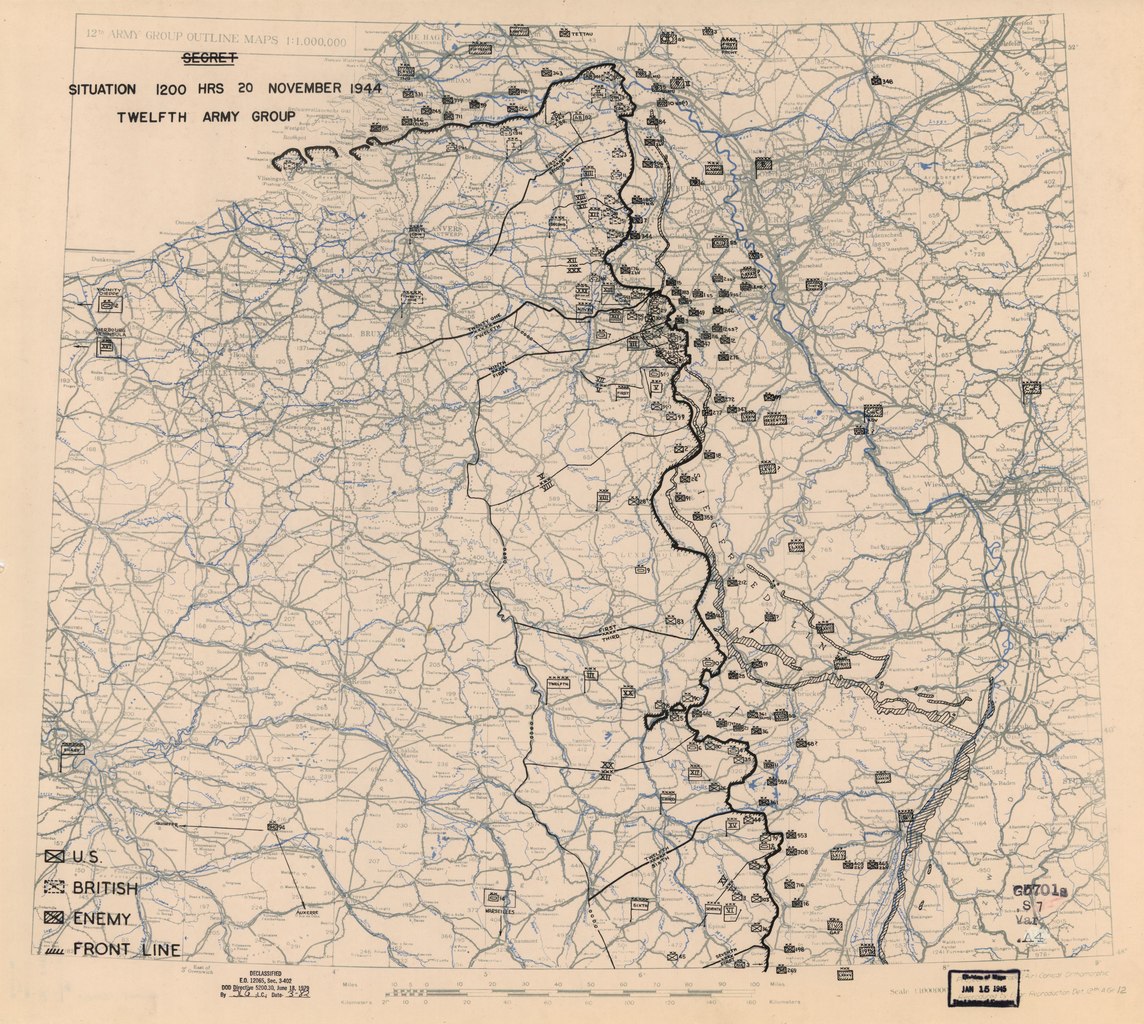 In the U.S. Third Army's XX Corps area, the 95th and 5th Infantry Divisions continue methodically to clear rear-guard opposition within Metz and contain the forts about the city. Preparations are made for the final drive to the Saar River. In the XII Corps area, the 80th Infantry Division conducts a reconnaissance in force on the northern flank of corps, seizing a bridge at Faulquemont and establishing a bridgehead north of the Nied Allemande River. The 137th Infantry Regiment, 35th Infantry Division, upon emerging from Bois de Freybouse, is disorganized by a German counterattack. Combat Command A, 4th Armored Division, followed by the 320th Infantry Regiment, secures Francaltroff. The 26th Infantry Division advances quickly behind the retreating Germans, elements of 101st Infantry Regiment reaching Torcheville, west of Munster. Corps orders Combat Command A, 6th Armored Division, to attack to gain Saar River crossings in the 35th Infantry Division zone and Combat Command B of 4th Armored Division to advance through Mittersheim in 26th Infantry Division zone; Combat Command A of 4th Armored Division is recalled from Francaltroff area to assembly area near Conthil. Photo: American infantrymen patrol a section of Metz in search of snipers. 20 November, 1944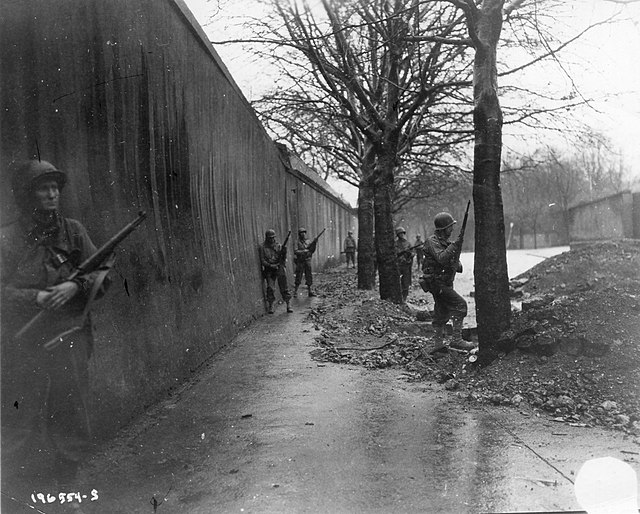 In the U.S. Seventh Army's XV Corps area, the French 2d Armored Division commits Combat Command D on the northern flank of corps in effort to outflank the Saverne Gap from the north while Combat Command L continues enveloping maneuver from the south; Combat Command D crosses the Saar River north of Sarrebourg and drives eastward in two columns, one toward Phalsbourg, at the western entrance to the gap, and the other toward La Petite Pierre, to the north; Combat Command L encounters stiffening resistance in the vicinity of the Wolfsberg Pass, southwest of Saverne, and Combat Command V is committed to assist in that area. In the VI Corps area, the 3d Infantry Division crosses the Meurthe River in the Clairefontaine-St Michel area before dawn to spearhead the drive, beginning at 0645 hours, on Strasbourg via Saales. The attack is preceded by intense artillery preparation and closely supported by the USAAF XII Tactical Air Command of the First Tactical Air Force (Provisional). Photo: A tank crosses a treadway bridge near Belfort, France, as the French drive to take this German strong point. November 20, 1944 Photo: French Commando fires 30 caliber machine-gun at German positions on the road to Belfort, as his compatriots watch. 20 November, 1944 Photo: French Commando fires 30 caliber machine-gun at German positions on the road to Belfort, as his compatriots watch. 20 November, 1944 The Germans, stunned by bombardment and threatened by successes of the Allied forces on both flanks of VI Corps, is incapable of resisting effectively. The 3d Infantry Division gains a substantial bridgehead including the towns of Le Paire, Hurbache, and La Voivre. The 103d Infantry Division, cross the Meurthe River in the 3d Infantry Division zone, during the night of 20/21 November, to drive toward St Die. On the southern flank of the corps, the 36th Infantry Division’s 143d Infantry Regiment seizes ridge commanding Anould and Clefcy. Western Front (1944) - Siegfried Line campaignIn the British Second Army's XXX Corps area, the 334th Infantry Regiment of the U.S. 84th Infantry Division eliminates resistance in environs of Prummern with help of British flame-throwing tanks, but enemy retains heights to NE. Strong opposition is slowing other elements of corps. In the U.S. Ninth Army's XIX Corps area, the 2d Armored Division, assisted by attached British tanks, renews an all-out drive in heavy rainfall; Combat Command B employs three Task Force’s against Gereonsweiler and takes the town; one Combat Command A Task Force overruns Ederen and another clears Freialdenhoven. The 29th Infantry Division, after seizing the village of Niedermerz, makes a two-pronged attack on Aldenhoven, in the second defensive arc of Juelich defenses, and takes the town. In the U.S. Third Army's XX Corps area, Combat Command B, 10th Armored Division, continuing toward Merzig, reaches Hill 378 but pulls back to Hill 383 because of fire from the Merzig area. The weather is bad with low cloud cover and no aircraft fly in support of offensive operations of the US First Army. In the north, the 104th Infantry Division clears the towns of Rohe and Burgrath and up to Hehlrath and the outskirts southwest of Eschweiler. The 3d Armored Division is pinched out by the 104th and 1st Infantry Divisions which also clears Wenau, bypasses Hersten and has elements well across the open ground towards Schnthal. Its attached 47th Regimental Combat Team reaches to within a half mile of the Aachen-Stolberg-Dueren railway. The 4th Infantry Division's 8th Infantry Regiment is counter-attacked and loses some ground, while the 22d Infantry Regiment makes slow progress towards Grosshau. The weather is bad with low cloud cover and no aircraft fly in support of offensive operations of the US First Army. In the north, the 104th Divisions clears the towns of Rohe and Burgrath and up to Hehlrath and the outskirts southwest of Eschweiler. The 3d Armored Division is pinched out by the 104th and 1st Divisions which also clears Wenau, bypasses Hersten and has elements well across the open ground towards Schnthal. Its attached 47th Regimental Combat Team reaches to within ½ mile of the Aachen-Stolberg-D¸railway. The 4th Division's 8 Infantry is counter-attacked and loses some ground, while the 22d Infantry makes slow progress towards Grosshau. Western Front (1944) - Liberation of the NetherlandsIn the British Second Army area, XII Corps continues toward the Maas River with the 49th Division, supported by elements of 4th Separate Armoured Brigade, and the 51st Division. The 51st finds villages on the river southwest of Venlo clear of Germans. Western Front (1944) - Liberation of BelgiumPhoto: How the Royal Navy Cleared the Scheldt To Antwerp. 20 1944, Antwerp. the Royal Navy Sweeping the Scheldt Channel Clear of Mines To Allow Access To Antwerp Air War over Europe Air War over Europe USAAF Fifteenth Air Force B-24s and B-17s encounter bad weather and attack several alternate targets and targets of opportunity: 166 bomb the marshalling yard at Brno, 50 hit the marshalling yard at Hodonin with the loss of one aircraft, 27 attack the Bata synthetic rubber plant at Zlin, 26 bomb the marshalling yard at Lundenburg, 21 hit Kromeriz and one each attack the marshalling yard at Ostrana Moravaska, the city of Trnava and a third unknown target. The USAAF Eighth Air Force flies Mission 718: 60 B-17s are sent to hit the Schowen oil plant at Gelsenkirchen and 92 hit the secondary target, the marshalling yard at Munster. Bad weather prevents USAAF Ninth Air Force bomber operations but fighters fly sweeps and night patrols over broad areas of western Germany and strafe and bomb numerous railroads, trains, buildings and various military targets. USAAF Fifteenth Air Force B-24s and B-17s bomb three targets: 172 bomb the I.G. Farben synthetic oil refinery at Blechhammer, six bomb Oppell and one hits the marshalling yard at Glewitz. During the day, RAF Bomber Command sends 183 Lancasters to make a G-H attack on the Meerbeck synthetic oil plant at Homberg but the weather is stormy and many aircraft are not able to maintain formation with the G-H aircraft on the bombing run. The bombing by 168 aircraft, through cloud, is believed to have been scattered. Five Lancasters are lost. During the night of 20/21 November, RAF Bomber Command sends 43 Lancasters on an unusual Pathfinder solo raid on Koblenz; 42 bombers attack without loss. The purpose of the raid is not recorded. It is possible that either the large road and rail bridges over the Rhine and Mosel Rivers or the local railway yards are the targets. Only high-explosive bombs are carried. Koblenz is completely covered by cloud and all bombing is by H2S from 15,000 feet (4 572 meters). The local report states that some bombs fall in the town, blocking several roads and railways and scoring hits on a road and a rail bridge, although these remained usable. Other raids are made by Mosquitos to six other targets: 58 hit Hannover, 14 bomb the Rauxel/Klocknerwerke synthetic oil refinery at Castrop, 11 attack the Meerbeck synthetic oil refinery at Homberg, seven bomb an aircraft engine factory at Eisenach and one each hit Duisburg and Minden. Three targets of opportunity are bombed by USAAF Fifteenth Air Force bombers: two attack the marshalling yard at Nagykanizsa and one each bomb tactical targets at Gyor and the marshalling yard at Szombathely. Italian campaign As the autumn rains turn to driving snow, General Alexander, the Allied commander-in-chief in Italy, has called a halt to the grueling campaign and stood down his armies. British tanks have found the going almost impossible, particularly across hundreds of rivers in the marshy Po valley. The German defence in Italy has been outstanding - but costly. With the Germans equally exhausted, winter activity at the front lines seems likely to be confined to patrolling and occasional artillery duels. The Allies will devote much time to training, particularly in the skills of river crossing and the Alpine warfare yet to come. In the British Eighth Army's V Corps area, German positions are heavily hit by air. The 46th Division, as a preliminary to their main assault, which is postponed until 21 November, begins to clear the Cosina loop north of Castiglione and takes Castiglione. Bad weather prevents USAAF Twelfth Air Force medium bombers from successfully attacking targets but fighter-bombers are able to operate during the late morning and destroy two factories east of Modena, and supply dumps near Parma, and cause large explosions in a dump near San Felice del Benaeo. Battle of the Mediterranean In Liberated Greece, British General Scobie is given responsibility for disbanding the Greek guerrilla forces. United Kingdom In London, England, five years of darkness end as street lights are switched on in Piccadilly, the Strand and Fleet Street. GermanyWith the Red Army fast approaching Rastenburg, Chancellor Adolf Hitler leaves his old headquarters and returns to Berlin. BelgiumAn agreement to disarm resistance members is made public. United States Heavy cruiser Augusta (CA-31) is damaged by explosion of unknown origin, Boston Navy Yard. Pacific War CHINA (Fourteenth Air Force): 8 B-25s hit the barracks area at Lashio, Burma; 60+ P-38s, P-40s, and P-51s on armed reconnaissance over parts of SE and SW China and French Indochina attack shipping--especially severely in the Chiuchiang, China area--and barracks, radio stations, villages, and other targets of opportunity. In China, the flight of the 21st Photographic Reconnaissance Squadron, Fourteenth AF, operating from Kanchow with F-5s, returns to base at Kunming. Chiang Kai-shek appoints a new Minister of War in an attempt to stem popular disenchantment with his regime INDIA-BURMA (Tenth Air Force): In Burma, 7 B-25s knock out the Hsipaw road bridge; 4 others fail to damage the Bawgyo bridge; 12 P-47s support ground forces in the Pinwe sector; 20+ others hit defenses at Mong Nge, a horse transport unit at Selan, bomb storage areas at Kyungon and Kyakataing, Japanese HQ and troop concentration at Man Mao, and several scattered targets of opportunity. Transports maintain continuous flights to forward bases and frontline areas. BURMA On the Salween front, the Chinese of the XI Group Army push through Mangshih, whose airfield is soon used to land supplies. CAROLINE ISLANDS Fleet oiler USS Mississinewa is sunk in the harbor of Ulithi Atoll, Admiral Halsey's Third Fleet anchorage, after being hit by a Japanese one man suicide submarine (Kaiten) while at anchor. The destruction of the Mississinewa proved to be one of the most important sinkings of the Pacific war as this was the first time the US Navy had encountered this type of submarine. Two kaitens, launched from their mother submarines I-36 and I-47 had penetrated the safety nets across the mouth of the harbor. One ran ashore but failed to explode and is recovered by the USN. The second kaiten found its mark on the starboard side of the Mississinewa which is loaded with 440,000 U.S. gallons of aviation fuel which explodes and erupts into a blazing inferno at 0547 hours local. At about 0900 hours the ship slowly turns over and disappeares. Casualties are three officers and 47 enlisted men killed, 11 officers and 81 enlisted wounded from the ships complement of 298. Photo: Sinking in Ulithi anchorage after she was hit by a Japanese suicide torpedo, 20 November 1944 SOUTHWEST PACIFIC AREA [Far East Air Force]: Units moving to Leyte Island: HQ Fifth AF moves from Owi; 13th Bombardment Squadron, 3d BG, from Hollandia, New Guinea to Dulag with A-20s. The 371st Bombardment Squadron (Heavy), 307th BG (Heavy), ceases operating form Noemfoor with B-24s and moves forward to Morotai. JAPANESE OCCUPIED NETHERLANDS EAST INDIES British carrier aircraft strike Sumatra, Netherlands East Indies. The targets are the airfields at Sabang and oil installations at Belawan Deli. The two carriers launch two strikes at these targets. In the air, USAAF Far East Air Forces (FEAF) B-25s bomb Haroekoe Drome on Haroekoe Island, an island off Ambon Island, and Laha Drome on Amon Island. On Celebes Island, P-38s hit targets of opportunity over Sidate and in the Makassar areas. Eight Australian Bostons and four Beaufighters attack the airfield and buildings at Tanamon Airfield on Celebes Island. NEW GUINEA CAMPAIGN The U.S. Eighth Army's operations on Asia and Mapia Islands are successfully concluded. The islands are to become sites for loran and radar stations. PHILIPPINE CAMPAIGN (1944) In the U.S. Sixth Army's X Corps area on Leyte, the 1st Battalion, 128th Infantry Regiment, 32d Infantry Division, is still held up on Corkscrew Ridge. Company C, 34th Infantry Regiment, joins the main body of the 1st Battalion on Kilay Ridge, abandoning forward positions. Company B tries unsuccessfully to recover knoll lost yesterday. The ammunition supply is critically low. The U.S. merchant ship SS Thomas Nelson, at anchor with twenty other ships in Dulag Bay. Leyte Island, is attacked by a Japanese suicide plane that has dived through a barrage of anti-aircraft fire to crash on her deck. On board are hundreds of tons of ammunition. The plane's single bomb explodes on impact, the explosion and fire causing the deaths of some 140 US Army enlisted men, navy gunners and merchant navy crewmen. USN submarine USS Gar lands supplies on the north coast of Mindoro. ALASKA (Eleventh Air Force): 3 B-24s fly an air cover mission for the US Navy. UNITED STATES NAVY DEPARTMENT COMMUNIQUES, CINCPAC COMMUNIQUÉ NO. 185, NOVEMBER 20, 1944 Aircraft from a carrier task force under the tactical command of Vice Admiral J. S. McCain struck at shipping and airfields in and around Manila on November 18 (West Longitude Date). Incomplete reports show that two large cargo ships and one large oiler were burned in Manila Harbor and about 100 enemy planes were destroyed on the ground. Light fighter opposition was met over the targets and 10 Japanese aircraft were shot down. Our fighters destroyed eight additional attacking planes near our carriers. Fighter planes of the Second Marine Aircraft Wing hit a fuel dump and other storage areas on Babelthuap in the Palaus and sank two enemy barges in waters around this island on November 17. On the same day Catalinas of Fleet Air Wing One bombed the town on Koror in the Palaus. Fighters of the Second Marine Aircraft Wing pounded the runways on Yap Airfield. On November 18 strafing and bombing attacks were made by planes of Fleet Air Wing One on barges near Kits. Iwo Jima in the Bonins. Unaggressive attacks were made on our planes by five enemy fighters. Liberators of the Eleventh Army Air Force on November 18 bombed targets in Suribachi in the Northern Kuriles. Intense antiaircraft fire was encountered. Second Marine Aircraft Wing fighters attacked the phosphate plant on Rota in the Marianas on November 18. Fighters of the Fourth Marine Aircraft Wing encountered intense antiaircraft fire in bombing attacks on the power plant and other installations on Nauru on November 18. An explosion was observed near the power station. PACIFIC Japanese planes attack three U.S. tankers proceeding from Ulithi to Eniwetok, near-misses and strafing account for damage to tanker Fort Dearborn at 12°00'N, 155°00'E. There are, however, only four men wounded among the ship's 50-man merchant complement, 27-man Armed Guard and five passengers. Submarine Atule (SS-403) sinks Japanese minesweeper W.38 southwest of Formosa, 21°21'N, 119°45'E. Submarine Gar (SS-206) lands supplies on north coast of Mindoro. British submarine HMS Tally Ho sinks Japanese auxiliary minesweeper Ma 4 30 miles east of the southern tip of Great Nicobar Island, 06°55'N, 94°15'E. USAAF B-25 (14th Air Force) sinks Japanese merchant cargo ship Daichi Maru in Yangtze River northeast of Shanghai, China, 31°57'N, 122°18'E. USAAF B-25s sink Japanese ship No.79 Nany Maru off Timor.
|
|
lordroel
Administrator
Posts: 68,033 
Likes: 49,431
|
Post by lordroel on Nov 21, 2023 3:47:38 GMT
Day 1898 of World War II, November 21st 1944Eastern Front Albanian resistance members occupy Tirana and Durazzo. Western Front (1944) - Liberation of FranceMap: HQ Twelfth Army Group situation map, November 21st 1944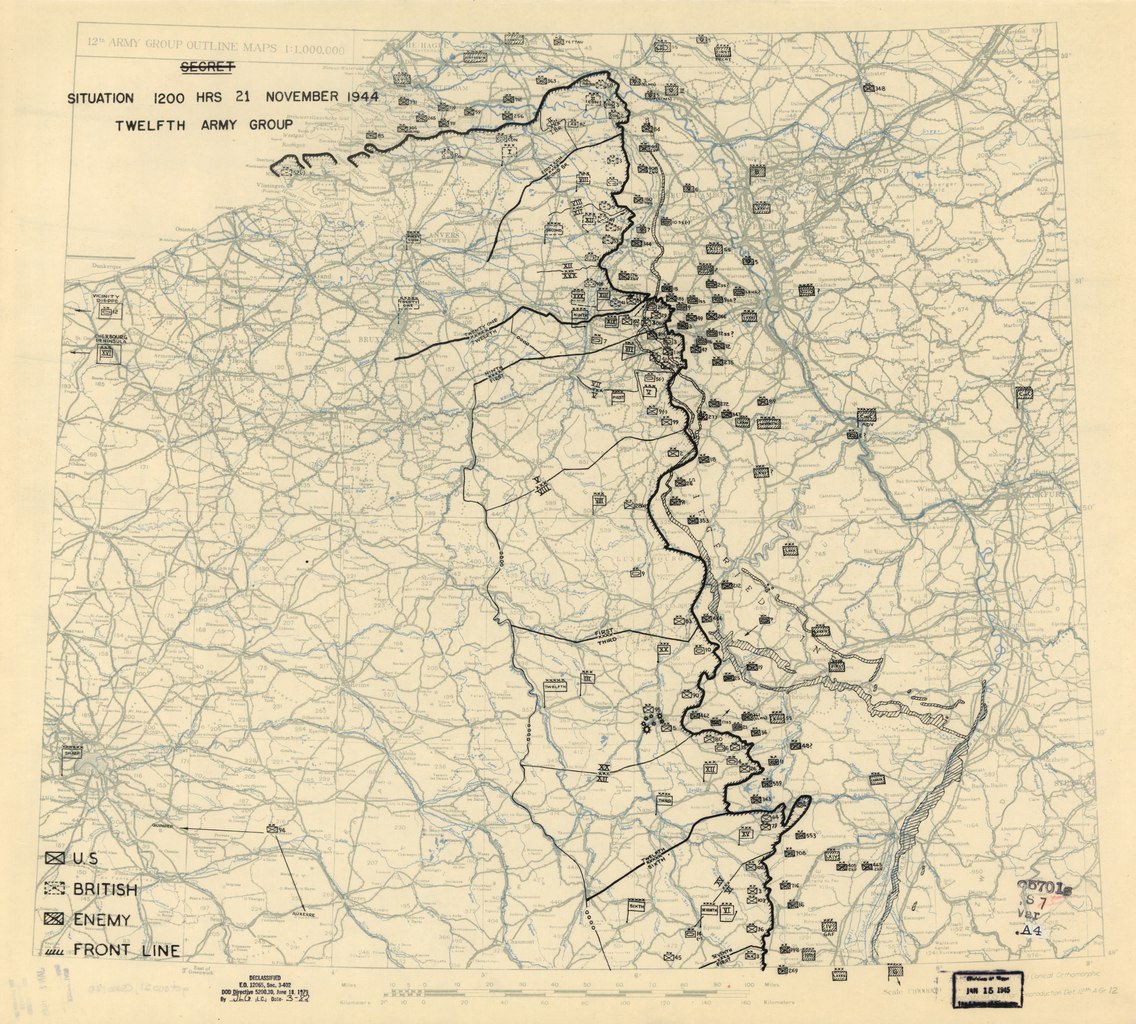 The US 3rd Army continues the siege of Metz while other elements gain ground near Saarebourg. Western Front (1944) - Liberation of the NetherlandsBritish 2nd Army continues attacks near Venlo. Western Front (1944) - Siegfried Line campaignUS 1st and 9th Armies meet firm resistance from German forces west of the Roer River. Photo: An M8 reconnaissance armored car of the 30th Infantry Div., rolls through the streets of Kinzweiler, November 21, 1944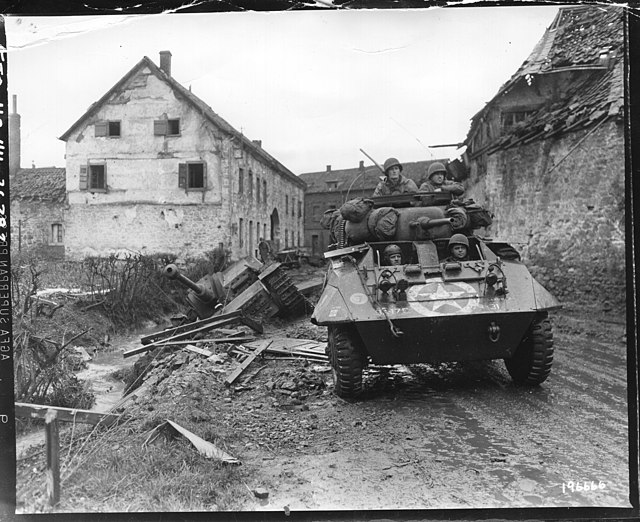 Photo: American infantrymen of 120th Regiment, 30th Infantry Division, pass through a German village as they move up to the front lines near Warden, Germany. 21 November, 1944 Photo: American infantrymen of 120th Regiment, 30th Infantry Division, pass through a German village as they move up to the front lines near Warden, Germany. 21 November, 1944 Photo: Sexton self-propelled gun of 147th (Essex Yeomanry) Field Regiment, the first Royal Artillery unit to fire its guns in Germany, 21 November 1944 Photo: Sexton self-propelled gun of 147th (Essex Yeomanry) Field Regiment, the first Royal Artillery unit to fire its guns in Germany, 21 November 1944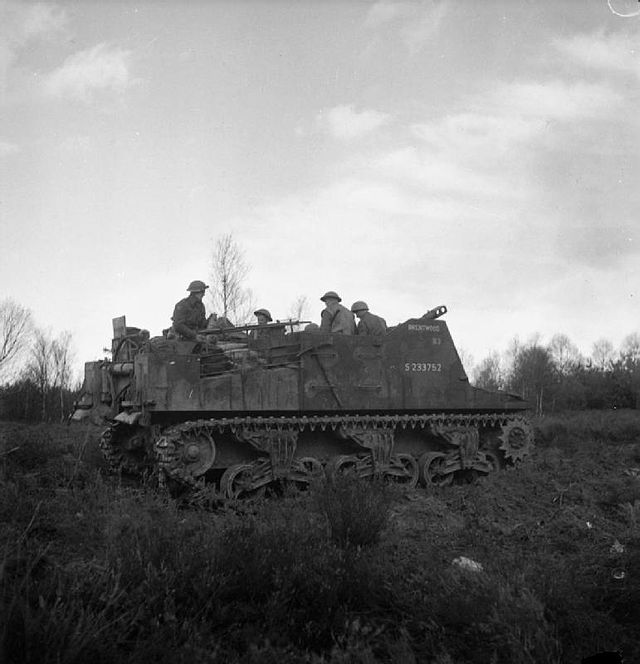 Air War over Europe Air War over Europe Aschaffenburg: 274 RAF Lancasters and 9 Mosquitos of Nos 1 and 8 Groups. 2 Lancasters lost. The object of this raid was to destroy the local railway yards and lines. The local report says that 50 bombs fell in the railway area, causing much damage to the marshalling yards and railway workshops but the: main through lines were not cut. Many other bombs fell in the centre and north of the town. About 500 houses were destroyed and 1,500 seriously damaged. Many old buildings were hit, including the local castle, the Johannisburg, which was hit by 5 high-explosive bombs and had a 4,000lb 'blockbuster' burst near by; the roof and upper storeys of the castle were burnt out. Castrop-Rauxel: 273 RAF aircraft - 176 Halifaxes, 79 Lancasters, 18 Mosquitos - of Nos 1, 6 and 8 Groups. 4 Halifaxes lost. The target was the oil refinery. The local report says that 216 high-explosive bombs, 78 duds and many incendiaries hit the oil plant and caused such a large fire that the fire-fighters could do little more than allow it to burn itself out. It is believe that the refinery produced no more oil after this raid. Bombs fell in many other places, including some important industrial and coal-mining premises. Sterkrade: 270 RAF aircraft - 232 Halifaxes, 20 Mosquitos, 18 Lancasters - of 4 and 8 Groups. 2 Halifaxes lost. The target was again the synthetic-oil refinery. Bomber Command's report says that the plant was not damaged, though some labour barracks near by were hit. Mittelland Canal: 138 RAF Lancasters and 6 Mosquitos of No 5 Group. 2 Lancasters lost. The canal banks were successfully breached near Gravenhorst. Later photographs showed that water drained off over a 30 mile stretch and that 59 barges were stranded on one short section alone. Dortmund-Ems Canal: 123 RAF Lancasters and 5 Mosquitos of No 5 Group. No aircraft lost. The canal near Ladbergen was attacked, some of the Lancasters coming down to 4,000ft to get beneath the cloud. A breach was made in the only branch of the aqueduct here which had been repaired since the last raid and the water once again drained out of the canal. First Tactical Air Force (Provisional): The 95th Bombardment Squadron (Medium), 17th Bombardment Group (Medium), moves from Poretta, Corsica to Dijon, France with B-26s. The 378th Fighter Squadron, 362d Fighter Group, moves from Prosnes to Rouvres, France with P-47s. 160 RAF Lancasters of No 3 Group to attack the Homberg oil refinery. 3 Lancasters lost. The bombing was scattered at first but then became very concentrated, culminating, according to the Bomber Command report, in 'a vast sheet of yellow flame followed by black smoke rising to a great height'. This was a very satisfactory raid after several previous attempts by Bomber Command to destroy this oil refinery. 29 RAF Mosquitos to Stuttgart, 26 to Hannover, 19 to Worms and 4 to Wesel, 38 RCM sorties, 80 Mosquito patrols, 24 Halifaxes and 18 Lancasters minelaying off Oslo, 9 aircraft on Resistance operations. 4 aircraft were lost - 2 Mosquitos and 1 Halifax of No 100 Group and 1 Lancaster from the minelaying force. (US Eighth Air Force): 2 missions are flown. Mission 720: 1,291 bombers and 954 fighters are dispatched to make PFF attacks using H2X on oil targets in Germany; they claim 73-7-25 Luftwaffe aircraft; 25 bombers and 15 fighters are lost: 1. 421 B-17s are sent to hit the Leuna synthetic oil plant at Merseburg (200); targets of opportunity are Meppen (24), Friedburg (21), Hersfeld (12) and Hunfeld (12) marshalling yards, flak gun batteries at Merseburg (12), Leeuwarden Airfield (11), Apolda (10) the Autobahn at Hersfeld (10), Quakenbruck (10), and other (69); the AAF claims 1-0-1 aircraft; 14 B-17s are lost, 3 damaged beyond repair and 205 damaged; 1 airman is KIA, 16 WIA and 129 MIA. Escort is 268 of 310 P-51s; they claim 63-7-20 aircraft in the air and 3-0-2 on the ground; 9 P-51s are lost (pilots MIA). 2. 402 B-17s are sent to Sterkrade, Lendorf and Hamburg but hit the secondary, the Osnarbruck marshalling yard (166) and last resort targets, i.e., Giessen marshalling yard (77), Wetzlar (62), Lingen (24), Koblenz marshalling yard (23), Bielefeld marshalling yard (9), and targets of opportunity (35); 7 B-17s are lost, 3 damaged beyond repair and 142 damaged; 2 airmen are KIA, 6 WIA and 65 MIA. Escort is 382 of 420 P-51s; 4 P-51s are lost (pilots MIA). 3. 366 B-24s are sent to hit the Dpag (178) and Rhenania (171) oil plants at Hamburg; 4 B-24s are lost, 2 damaged beyond repair and 220 damaged; 19 airmen are KIA, 8 WIA and 89 MIA. Escort is 177 P-47s and P-51s; they claim 5-0-2 aircraft in the air and 2-0-1 on the ground; 1 P-47 and 1 P-51 are lost (pilots MIA). 4. 12 of 12 B-17s fly a screening mission. 5. 31 of 33 P-51s fly a scouting mission. Mission 721: 7 B-17s and 5 B-24s drop leaflets in France, the Netherlands and Germany during the night. US Ninth Air Force: In Germany, the 9th Bombardment Division hits rail bridges and defended areas at several points including Bergstein, Echtz, Sinzig, Neuwied, and Derichsweiler; fighters escort the B-26s and also Eighth AF B-17s (to Merseburg), fly area cover, sweeps, and dive-bombing missions in W Germany, and support the US 1st, 8th, and 104th Infantry Divisions in the Hurtgen area and the XII and XX Corps between Merzig and Sarreguemines, France. Italian campaign (US Fifteenth Air Force):25 B-24s bomb troop concentrations, railroad, and highways at Novi Pazar and Cacak, Yugoslavia. 155 P-38s dive-bomb communications lines in S Yugoslavia, destroying several vehicles, blasting roads at Vucitrn, Rogatica, Tvrdosevo, and Duga Poljana, hitting bridges at Vrbasici, and Kukavica and causing a landslide at Pavlica; 87 P-51s strafe communications over wide areas of S Yugoslavia; other fighters fly reconnaissance missions. (US Twelfth Air Force): In Italy, B-25s blast defenses and troop concentrations in the Faenza area as the British Eighth Army's 5 Corps opens a general offensive N towards that town; fighter-bombers hit targets in the US Fifth Army battle area S of Bolonga, in the Po Valley, and in NE Italy; particularly good results are achieved against supply dumps and a rail line in the Brenner Pass is cut in 3 places. Pacific War CHINA (Fourteenth Air Force): In China, 42 P-51s and P-38s on armed reconnaissance attack fuel supplies and the town area at Ishan and road and rail traffic and other targets of opportunity N of Wanling, Burma and in the Chiuchiang area, S of Foochow, and at Hsuchang, Sincheng, and Sheklung. Major General Albert C. Wedemeyer Commanding General China Theater, U.S. Army, and Generalissimo Chiang Kai-Shek's Chief of Staff, formally presents his recently formulated ALPHA Plan to concentrate Chinese forces in the Kunming area as quickly as possible and place them under command of China's best general in order to avert a threat to Kunrning–to Chiang Kai-shek. General Chen Cheng is recommended for command of ALPHA forces, but Chiang Kai-shek prefers General Ho Ying-chin. American assistance will consist of maximum air support and liaison officers to advise the Chinese Army. HQ AAF (Twentieth Air Force): 61 B-29s from Chengtu, China bomb an aircraft plant at Omura, Kyushu Island, Japan; 13 B-29s bomb Shanghai, China, and several others hit alternates and targets of opportunity; the B-29s claim 27 fighters downed, the highest Twentieth AF claim to date. INDIA-BURMA (Tenth Air Force): In Burma, 28 P-47s support ground forces in the Pinwe and Bhamo areas; 37 others hit supply areas, troop concentrations and strongholds at Langwa, Pinmalut, Hlebwe, Mutawng, and Nawnghkem; 15 P-47s hit targets of opportunity while sweeping the Kyaukme-Namyao road; 10 B-25s knock out bridges at Hsipaw and Bawgyo. Transports fly 280+ sorties to forward areas. BURMA USAAF Major General George Stratemeyer Commanding General AAF, India-Burma Sector, CBI Theater and commander of the Eastern Air Command, South East Asia Command, inactivates the Third Tactical Air Force so that the RAF 221 Group may provide close support for the British Fourteenth Army and the RAF 224 Group can support the British XV Corps for the Arakan offensive. On the Northern Combat Area Command (NCAC) front, the Chinese 38th Division continues to close in on Bhamo. The 114th Regiment, bypassing a Japanese outpost at Subbawng, which detachment of 113th Regiment is containing, drives into Shwekyina. Photo: Royal Indian Army Service Corps troops unload an American C-47 cargo plane at an airstrip in the Pinwe area, 21 November 1944 Photo: Casualties from the 36th Infantry Division being loaded into an American C-47 aircraft at an airstrip in the Pinwe area, to be taken to a base hospital in Ledo, 21 November 1944 Photo: Casualties from the 36th Infantry Division being loaded into an American C-47 aircraft at an airstrip in the Pinwe area, to be taken to a base hospital in Ledo, 21 November 1944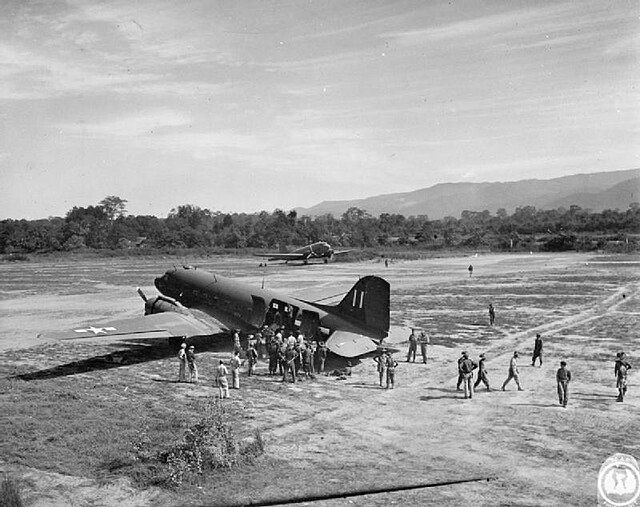 GUAM (Seventh Air Force): Seventh AF service groups are reassigned from the VII Air Service Area Command to the VII Bomber Command and VII Fighter Command, with one service group to support each tactical group in the field. B-24s from Guam bomb shipping and naval shore installations at Chichi Jima and Haha Jima. 5 B-24s from Guam on armed reconnaissance bomb airfields on Iwo Jima JAPANESE OCCUPIED NETHERLANDS EAST INDIES In the Netherlands East Indies, USAAF Far East Air Forces B-25s hit Langoan and Mapanget Airfields on Celebes Island while B-24s in the Kendari area bomb Ambesia Airfield. B-24s sink a Japanese ship in Makassar Strait off Dutch Borneo. PHILIPPINE CAMPAIGN (1944) In the U.S. Sixth Army's X Corps area on Leyte, the 128th Infantry Regiment, less 1st Battalion, which is to contain the Corkscrew Ridge, is ordered to capture Limon and secure a crossing of the Leyte River tributary to the south. In preparation for this attack, fire is placed on Japanese positions along Highway 2 during the night. The action on Kilay Ridge is confined to patrolling and fire exchanges. Supplies brought by hand from Consuegra are being supplemented by airdrops. In the XXIV Corps area, the 3d Battalion of the 32d Infantry Regiment, 7th Infantry Division, moves from Baybay to position just south of the 2d Battalion. Artillery is being emplaced at Damulaan. USAAF Far East Air Forces B-24s bomb Matina and Lumbia Aerodromes on Mindanao Island. On Leyte Island, fighter-bombers hit troop barges and supply dumps in Ormoc Bay and numerous targets of opportunity throughout the central Philippine Islands. ALASKA (Eleventh Air Force): Advance HQ Eleventh AF is established on Shemya with Brigadier General Harry A Johnson as Deputy Commander. 5 B-24s fly air coverage for naval units; another fleet coverage mission by 10 B-25s is cancelled due to weather; before clearance can be obtained from the Soviets through diplomatic channels, a B-24 air-drops provisions to a marooned crew of a B-24 which forcelanded on Kamchatka Island on 17 Nov 44. UNITED STATES NAVY DEPARTMENT COMMUNIQUES, CINCPAC COMMUNIQUÉ NO. 186, NOVEMBER 21, 1944 Army and Marine Infantry units in the Marianas and Palaus continued to clear captured islands of remnants of Japanese garrisons. Total enemy casualties given below are through November 13 (West Longitude Date) Saipan, killed, 26,277; captured, 2,068 Guam, killed, 17,238; captured, 463 Tinian, killed, 6,893; captured, 316 Angaur and Peleliu, killed, 12,980; captured, 420 On November 18, aircraft of the Second Marine Aircraft Wing made a strafing attack on installations on Haha Jima and shipping at Chichi Jima. Additional reports on aircraft strikes by carrier based planes over Manila on November 18 now show that a total of 26 Japanese planes were shot out of the air. Four of these were destroyed by ships' antiaircraft fire. (A total of 18 planes had been reported shot down in communiqué No. 185.) Japanese bases in the Palaus were hit by planes of the Second Marine Aircraft Wing and Fleet Air Wing One on November 18. Several large fires were started. On the same day fighters of the Second Marine Aircraft Wing carried out bombing attacks on the airfield at Yap. Air attacks were made on enemy held bases in the Marshalls on November 19 and 20 as the Fourth Marine Aircraft Wing and search planes of Meet. Air Wing Two continued neutralizing raids on those islands. The enemy sent up meager antiaircraft fire. PACIFIC Two light cruisers and and nine destroyers of TF 92 (Rear Admiral John L. McCrea) bombard Japanese naval air installations on Matsuwa Island, Kurils. Submarine Flounder (SS-251) attacks Japanese convoy in the South China Sea, damaging army cargo ship Gyosan Maru, 10°36'N, 115°08'; later, submarine Guavina (SS-362) completes destruction of Gyosan Maru off Tizard's Reef, 10°22'N, 114°22'E. Submarine Scabbardfish (SS-397) sinks Japanese victualling stores ship Hokkai Maru 200 nautical miles south of Tokyo, 33°20'N, 142°00'E. Submarine Sealion (SS-315) attacks Japanese task force, and sinks battleship Kongo and destroyer Urakaze about 60 miles north-northwest of Formosa, 26°07'N, 121°36'E. Japanese oceanographic research vessel Kaiyo No.2 is sunk by U.S. aircraft in the Celebes Sea. USAAF B-24 sinks Japanese ship Shinsei Maru in Makassar Strait, 02°04'N, 119°12'E. Japanese cargo ship Fukurei Maru is sunk by marine casualty off west coast of Korea, 38°08'N, 124°34'E.
|
|
lordroel
Administrator
Posts: 68,033 
Likes: 49,431
|
Post by lordroel on Nov 22, 2023 3:49:38 GMT
Day 1899 of World War II, November 22nd 1944Western Front (1944) - Liberation of FranceMap: HQ Twelfth Army Group situation map, November 22nd 1944 Forces of the US 3rd Army capture Metz. US 7th Army forces take St. Die as others approach Saverne. The French 1st Army occupies Mulhouse, after defeating a counterattack by German forces. Photo: A Moroccan soldier waits in cover for an expected enemy counterattack, Mulhouse area, France, 22 November, 1944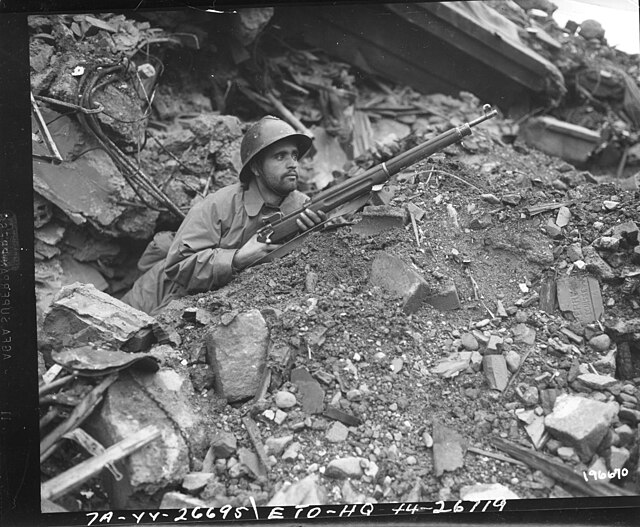 Photo: A group of German snipers, taken during the fight for a road leading out of Belfort, France, is led through the streets of the city by members of the 1st French Armored Division. 22 November, 1944 Photo: A group of German snipers, taken during the fight for a road leading out of Belfort, France, is led through the streets of the city by members of the 1st French Armored Division. 22 November, 1944 Western Front (1944) - Liberation of the NetherlandsPhoto: Churchill tanks of 3rd Scots Guards, 6th Guards Tank Brigade, with infantry of 2nd Argyll and Sutherland Highlanders, advance near Beringe in Holland, 22 November 1944 Western Front (1944) - Liberation of the NetherlandsPhoto: Churchill tanks of 3rd Scots Guards, 6th Guards Tank Brigade, with infantry of 2nd Argyll and Sutherland Highlanders, advance near Beringe in Holland, 22 November 1944 Photo: Infantry of 2nd Argyll and Sutherland Highlanders riding on Achilles 17-pdr tank destroyers during the advance east of Beringe, 22 November 1944 Photo: Infantry of 2nd Argyll and Sutherland Highlanders riding on Achilles 17-pdr tank destroyers during the advance east of Beringe, 22 November 1944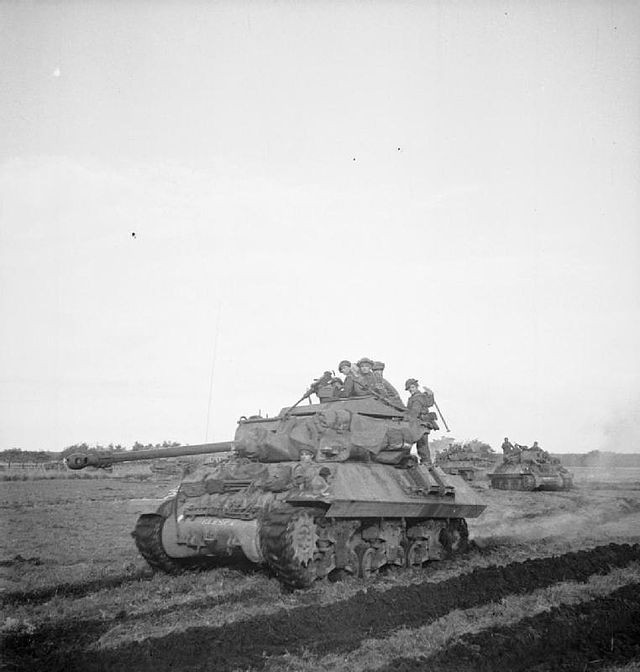 Photo: Sherman Crab flail tanks of the Westminster Dragoons carrying infantry of 2nd Argyll and Sutherland Highlanders during the advance east of Beringe, 22 November 1944 Photo: Sherman Crab flail tanks of the Westminster Dragoons carrying infantry of 2nd Argyll and Sutherland Highlanders during the advance east of Beringe, 22 November 1944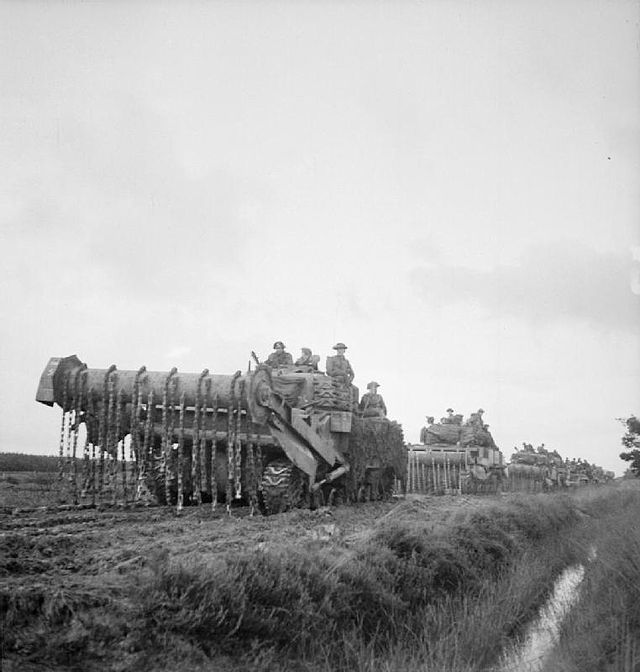 Western Front (1944) - Siegfried Line campaign Western Front (1944) - Siegfried Line campaignOperations of the US 9th Army and the US 1st Army secure Eschweiler. Air War over EuropeFirst Tactical Air Force (Provisional): HQ 63d Fighter Wing moves from San Pietro Italy to Vittel, France; the 432d Bombardment Squadron (Medium), 17th Bombardment Group (Medium), moves from Poretta, Corsica to Dijon, France with B-26s. Ninth Air Force: Bomber operations are cancelled due to bad weather; fighter operations are limited. 16 aircraft from the IX and XIX Tactical Air Commands patrol over the V and VII Corps area (SE of Aachen), the Bonn- Cologne area, and fly reconnaissance around Saarbrucken, Homburg/Saar, Neukirchen and Kaiserslautern, Germany, and Sarrebourg, France. In France, the 377th Fighter Squadron, 362d Fighter Group, moves from Prosnes to Rouvres, France with P-47s. 171 RAF Lancasters and 7 Mosquitos of No 5 Group were dispatched to attack the U-boat pens at Trondheim but the target was covered by a smoke-screen and the Master Bomber ordered the raid to be abandoned after the illuminating and marking force had been unable to find the target. 2 Lancasters and 1 Mosquito lost. (US Fifteenth Air Force): 205 B-17s and B-24s hit E and W marshalling yards at Munich, Germany; 214 others fail to reach primaries because of impenetrable weather and attack alternates and targets of opportunity including marshalling yards at Regensburg, Germany, Salzburg, Lienz, and Villach, Austria and several targets of opportunity at scattered points; fighters provide escort to Munich, Germany. In Italy, 88 B-24s attack a bridge at Ferrara and rail line at Carbola, while 39 P-38s bomb the Osoppo motor transport depot. Italian campaign(US Twelfth Air Force): In Italy, B-25s again pound defenses in the Faenza area as British Eighth Army forces push into that area from the SE; fighter-bombers and fighters fly nearly 350 sorties against rail lines in the Po Valley and very successfully hit guns, vehicles, troops and other targets in the US Fifth Army battle area S of Bologna, and supply dumps and pipelines N of the battle area. Battle of the Mediterranean Photo: Three Enemy Destroyers Sunk in 1 1/2 Hours. 22 November 1944, on Board HMS Wheatland, Malta. the Hunt Class Destroyers HMS Wheatland and HMS Avonvale Sank Three Enemy Destroyers Within 1 1/2 Hours on 1 November 1944, in the Adriatic Near Pag Island Canada CanadaAt a cabinet meeting, Prime Minister King announces that the request for volunteers for overseas duty had failed. The Army High Command threatens to resign if the government does not impose conscription to send soldiers into overseas battle. With a risk of District Officers Commanding threatening to resign, the only option left was mandatory conscription. Defence Minister Andrew McNaughton recommends to Cabinet that 16,000 conscripted soldiers be sent to fight in Europe. FinlandPhoto: Photograph of Finnish military intelligence agents onboard a ship travelling from Närpiö (Närpes), Finland, to Härnösand, Sweden, as a part of the Operation Stella Polaris, 22 September 1944 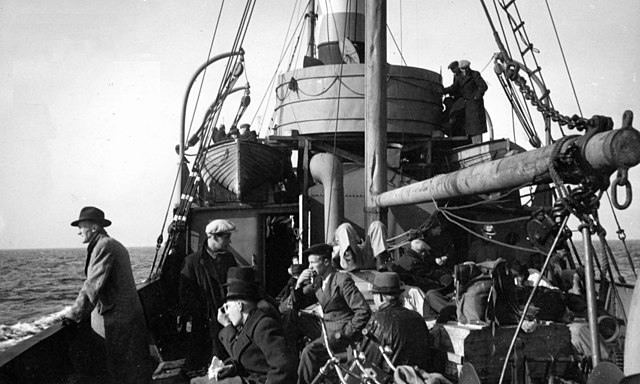 United StatesPhoto: The U.S. Navy destroyer USS John R. Pierce (DD-753) after delivery from Bethlehem Steel off Staten Island, New York (USA), on 22 November 1944. The destroyer was commissioned on 30 December 1944. She is painted in Camouflage Measure 33a United StatesPhoto: The U.S. Navy destroyer USS John R. Pierce (DD-753) after delivery from Bethlehem Steel off Staten Island, New York (USA), on 22 November 1944. The destroyer was commissioned on 30 December 1944. She is painted in Camouflage Measure 33a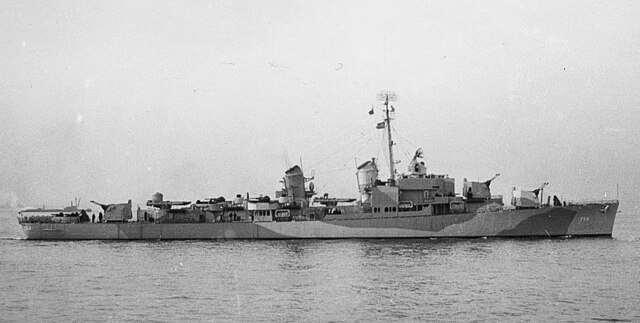 Photo: The U.S. Navy light cruiser USS Atlanta (CL-104) at the New York Shipbuilding Corporation, Camden, New Jersey (USA), on 22 November 1944. She is painted in Camouflage Measure 33, Design 2 Photo: The U.S. Navy light cruiser USS Atlanta (CL-104) at the New York Shipbuilding Corporation, Camden, New Jersey (USA), on 22 November 1944. She is painted in Camouflage Measure 33, Design 24D  Pacific War Pacific War CHINA (Fourteenth Air Force): In China, 22 B-24s bomb Hankow; 11 B-25s pound the Ishan and Liuchenghsien areas while 8 hit storage facilities at Wanling and Kutkai, Burma; 95 P-51s, P-40s, and P-38s on armed reconnaissance over wide expanses of S China attack town areas, supplies, and road and rail traffic, hitting the Chefang area especially hard. INDIA-BURMA (Tenth Air Force): In Burma, 15 P-47s support ground forces at Bhamo while 37 others fly close support in the Pinwe area; supply and personnel areas at Nawngchio, Kutkai, Ingon, Selong, Man Mao, and in the vicinity of Kanbalu are pounded by more than 40 P-47s; 12 others attack the airfield at Kawlin Transports fly 188 sorties to forward areas. In India, the 2d Combat Cargo Squadron, 1st Combat Cargo Group, moves from Sylhet to Imphal with C-47s. BURMA Photo: Private Putterill of the Royal Sussex Regiment, 36th Infantry Division, armed with a Bren gun during a patrol, 22 November 1944 Photo: A Bren gun team of 36th Infantry Division man a front-line position during the final assault on Pinwe, 22 November 1944 Photo: A Bren gun team of 36th Infantry Division man a front-line position during the final assault on Pinwe, 22 November 1944 SAIPAN (Seventh Air Force): 22 B-24s from Saipan escorted by 22 P-38s (the first long-range P-38 escort of Seventh AF bombers), bomb airfields on Moen and Param. P-47s from Saipan pound the airfield on Pagan. CAROLINE ISLANDS Aircraft from a USN Task Group 38.4 bomb Japanese air facilities on Yap using napalm, the first time this weapon had been used by carrier-based aircraft. SOUTHWEST PACIFIC AREA [Far East Air Force]: Fighter-bombers hit targets of opportunity in the Makassar area, loosing the P-38 piloted by Robert Westbrook. JAPANESE OCCUPIED NETHERLANDS EAST INDIES On Celebes Island in the Netherlands East Indies, fighter-bombers hit targets of opportunity in the Makassar area while B-24s bomb the nickel mine and targets of opportunity in the Kendari area and hit airfields in northeastern Celebes. Other B-24s hit small shipping during a sweep over Brunei Bay, British Brunei, Borneo. Nine Japanese aircraft raid Pitu and Wama Airfields on Morotai Island, Netherlands East Indies, destroying 15 RAAF and USAAF aircraft on the ground and damaging 29. PHILIPPINE CAMPAIGN (1944) In the U.S. Sixth Army's X Corps area on Leyte, the 2d and 3d Battalions of the 128th Infantry Regiment, 32d Infantry Division, attack south astride Highway 2 and take Limon, virtually completing the battle of Breakneck Ridge. Bypassed Japanese pockets are eliminated by mid-December. Forward elements of the 128th Infantry Regiment cross the tributary of the Leyte River south of Limon. The 1st Battalion of the 34th Infantry Regiment, under heavy Japanese attack on Kilay Ridge, is forced to compress its defense perimeter to avoid encirclement. In the XXIV Corps area, the 7th Infantry Division is ordered to assemble in the Baybay area as quickly as possible. The 11th Airborne Division, although not originally intended to operate on Leyte, is ordered to relieve the 7th Infantry Division, less the 17th Infantry Regiment, so the 7th can clear the eastern shore of Ormoc Bay. USAAF Far East Air Forces B-24s, B-25s, and fighter-bombers pound Bacalod Airstrip and Ipil on Negros Island, and Ormoc, Leyte Island area bridges, barges, and targets of opportunity. B-24s also bomb Sasa Airfield on Mindanao Island. ALASKA (Eleventh Air Force): 4 B-25s abort an air coverage mission due to weather. UNITED STATES NAVY DEPARTMENT COMMUNIQUES, CINCPAC COMMUNIQUÉ NO. 187, NOVEMBER 22, 1944 Further reports of the air strikes in and around Manila on November 18 (West Longitude Date) reveal the following total damage to shipping and Installations by planes of the Third Fleet: One medium cargo ship and one small coastal cargo ship set afire in Subic Bay. Two medium cargo ships burning and one small coastal cargo ship sunk near San Fernando. One cargo ship burned and another burning in Manila Bay. An oiler in flames and one medium cargo ship and two other oilers hit in Manila Bay. Five luggers burning off Batangas and another sunk at Laoag. Locomotive destroyed at Lucena. Our planes strafed a heavy cruiser which appeared to be beached or in shallow water near Santa Cruz. Ten fires were started in fuel dumps at San Fernando, Del Carmen Field and Clark Field while buildings and other installations were destroyed at West Lipa, Nichols, Malvar and Del Carmen Fields. Liberators and Lightnings of the Seventh Army Air Force on November 21 strafed and bombed airfields on Truk. Five enemy fighters were seen of which four were destroyed. Fighters of the Second Marine Aircraft Wing on November 19 hit Babelthuap in the Palaus, setting fuel dumps afire, and pounded the airfield on Yap. Defenses on Rota in the Marianas were pounded by fighters of the Second Marine Aircraft Wing on November 19. PACIFIC Aircraft from carrier group (Rear Admiral Ralph E. Davison) bomb Japanese air facilities on Yap, Carolines. Japanese planes raid U.S. air facility at Morotai, destroying 15 bombers and damaging 31. Submarine Besugo (SS-321) sinks Japanese landing ship T.151 off northern tip of Palawan, 11°22'N, 119°07'E. Submarine Guavina (SS-362) sinks Japanese army cargoship D_wa Maru near Tizard's Bank, northwest of Borneo, 10°23'N, 114°21'E. Submarine Scabbardfish (SS-397) damages Japanese escort vessel Oki, 33°20'N, 142°00'E. Japanese auxiliary submarine chaser Cha 82 is sunk by aircraft off Balabac Island, P.I., 08°00'N, 117°00'E; USAAF planes damage cargo ship Enoshima Maru at Makassar.
|
|
lordroel
Administrator
Posts: 68,033 
Likes: 49,431
|
Post by lordroel on Nov 23, 2023 3:52:07 GMT
Day 1900 of World War II, November 23rd 1944Eastern FrontIn Czechoslovakia, Soviet troops take Cop. In Hungary, Soviet forces capture Tokay in the north of the country Western Front (1944) - Liberation of FranceMap: HQ Twelfth Army Group situation map, November 23rd 1944 French troops of US 7th Army reach Strasbourg. Western Front (1944) - Liberation of the NetherlandsOn the right flank of the German line, the 15th Army falls back in Holland. Western Front (1944) - Siegfried Line campaignThe German 7th Army launches attacks on forces of US 9th Army. Photo: A newly captured crossroad carries east and west bound traffic as Lt. Gen. George S. Patton's Third Army smashes towards the Rhine. November 23, 1944 Air War over Europe Air War over Europe First Tactical Air Force (Provisional): HQ 42d Bombardment Wing (Medium) moves from Borgo, Corsica to Dijon, France. Ninth Air Force: Unfavorable weather cancels all flights. 168 RAF Lancasters of No 3 Group carried out a G-H raid through cloud on the Nordstern oil plant at Gelsenkirchen. The bombing appeared to be accurate. 1 Lancaster lost. 61 RAF Mosquitos to Hannover, 9 to Eisenach and 6 each to Gottingen and Hagen, 43 aircraft of No 100 Group on RCM and Mosquito operations (separate figures not available). 1 Mosquito lost from the Hannover raid. (US Eighth Air Force): Mission 722: In Germany, 134 of 155 B-17s and 73 of 78 P-51s make a GH attack on the Norstern benzol manufacturing plant near Gelsenkirchen and the marshalling yard at Duisburg with the loss of 1 P-51 (pilot MIA) and 1 P-51 damaged beyond repair; 13 of 13 B-17s fly a screening mission and 10 of 12 P-51s fly a scouting mission. Italian campaign Motor torpedo boat patrol attacks southbound convoy off Portofino, damaging two coasters, while engaged by German shore battery that inflicts no damage on the PTs. (US Twelfth Air Force): In Italy, bad weather restricts operations; medium bombers over the Faenza area abort due to overcast, P-47s hampered by low clouds over the Apennines Mountains, fly only 16 sorties, against rail lines S of Bologna, but succeed in cutting the lines in 6 places. (US Fifteenth Air Force): In Yugoslavia, 81 B-24s attack road and railroad bridges at or near Zenica, Brod, and Doboj; 30 P-38s bomb the Doboj marshalling yard, 13 hit Doboj road and rail bridge, and 4 attack, but miss, a bridge at Maglaj; 13 B-24s and B-17s drop supplies at points in Yugoslavia. Battle of the Atlantic U.S. freighter 'William D. Burnham' is torpedoed by German submarine 'U-978' about five miles off Barfleur, France; 10 of the 26-man Armed Guard perish, as do eight of the 41-man merchant complement. British escort drifter HMS 'Fidget' rescues survivors, transferring most to motor torpedo boat PT-461, and the wounded to British destroyer HMS 'Vesper'. Salvage tug ATR-3 later tows 'William D. Burnham' to Cherbourg where the freighter is beached and ultimately assessed as a total loss. Soviet UnionThe Soviet government announces that, with the assistance of Finnish forces in accord with the terms of the recent armistice, Finnish Lapland has been cleared of German troops. United KingdomTo date, about 200 V-2 rockets have landed in England, about 100 in the London Region, killing about 500. The British Eastern Fleet is disbanded. Older ships and the escort carriers a formed into the British East Indies Fleet, while the modern ships are detached for service as the British Pacific Fleet. United StatesPhoto: The U.S. Navy attack cargo ship USS Torrance (AKA-76) at New York City (USA) on 23 November 1944. She is painted Camouflage Measure 32, Design 8T Pacific War Pacific War CHINA (Fourteenth Air Force): In Burma, 12 B-25s bomb a storage area near Lashio and 8 hit Kutkai and Wanling. 2 B-24s bomb Kowloon Docks in Hong Kong. 120+ P-40s, P-51s and P-38s hit targets of opportunity throughout SW and SE China; 32 of the fighter-bombers support ground forces in the Chefang, China area. INDIA-BURMA (Tenth Air Force): In Burma, 50+ P-47s support ground forces in the Pinwe and Bhamo areas; 16 sweep and strafe airfields and many targets of opportunity from Anisakan to Nawnghkio; 3 hit an ammunition dump at Man Naung; 21 P-47s sweep roads in the Ye-U area and strafe rail installations at Kanbalu; 10 B-25s knock out the Tantabin main bridge and Tangon and Thegyaung bypass bridges, and blast approaches to the Tangon main bridge and Tantabin bypass bridge. 282 transport sorties are flown to forward bases and frontline areas. GUAM (Seventh Air Force): 17 B-24s from Guam Island hit shipping at Chichi Jima and Haha Jima Islands and bomb the town of Okimura in the Bonin Islands. BISMARCK ARCHIPELAGO The RAAF's No. 6 Squadron resumes their attack on Rabaul, New Britain Island, with Beauforts. The town will be attacked three more times before the end of the month. SOUTHWEST PACIFIC AREA [Far East Air Force]: The 63d and 64th Bombardment Squadrons (Heavy), 43d BG (Heavy), move from Owi to Tacloban, Leyte Island with B-24s. JAPANESE OCCUPIED NETHERLANDS EAST INDIES: Eleven RAAF (P-40) Kittyhawks dive bomb Lolobato and Hatetabako Aerodromes on Halmahera Island and 12 others dive bomb Galela Airfield on Galela Island 20 miles from Morotai Island. PHILIPPINE CAMPAIGN (1944) In the U.S. Sixth Army's X Corps area on Leyte, the 128th Infantry Regiment of the 32d Infantry Division improves and consolidates positions south of Limon and for the next few days patrols actively. The 112th Cavalry Regiment, which has been patrolling the Mt. Minoro area, is ordered southwest toward Highway 2 to relieve pressure on the 32d Infantry Division. In the XXIV Corps area, the 77th Infantry Division begins unloading on Leyte and is assigned to the corps. The Battle of Shoestring Ridge opens as the Japanese attack the sector of thinly spread 32d Infantry Regiment, 7th Infantry Division, along the Palanas River, forcing a limited withdrawal. USAAF Far East Air Forces B-24s bomb Matina Aerodrome on Mindanao Island. Submarine Gar (SS-206) lands men and supplies on west coast of Luzon. Attack transport James O'Hara (APA-90) is damaged by kamikaze off Leyte, 10°57'N, 125°02'E. SOLOMON ISLANDS CAMPAIGN Australian troops of the 9th Battalion, 7th Brigade, 3rd Division, relieve the U.S. 2d Battalion, 132d Infantry Regiment, Americal Division, at Cape Torokina, Bougainville. The Australian arrival opens the campaign on Bougainville that cost over 500 Australian lives by the war's end. UNITED STATES NAVY DEPARTMENT COMMUNIQUES, CINCPAC COMMUNIQUÉ NO. 188, NOVEMBER 23, 1944 Matsuwa in Kuriles was bombarded by a Naval task force on November 21 (West Longitude Date). Large fires and explosions were observed. Enemy guns did not reply. None of our ships was damaged. Fighters of the Second Marine Aircraft Wing destroyed an ammunition dump and set fire to trucks and a barge at Babelthuap in the Northern Palau Islands on November 20. One of our planes was lost, but the pilot was rescued. Fighters of the Second Marine Aircraft Wing bombed the airstrip on Yap on November 20. Aircraft of the Seventh Army Air Force bombed and strafed shipping and harbor installations at Chichi Jima and Haha Jima in the Bonin Islands on November 20. One enemy plane was seen over Chichi Jima. Antiaircraft fire was moderate. Venturas of Fleet Air Wing Two bombed and strafed the barracks area and power plant on Wake Island on November 22. A large explosion was observed north of the power plant. Antiaircraft fire was meager and In¬accurate. Search planes of Fleet Air Wing Two and fighters of the Fourth Marine Aircraft Wing continued neutralization raids in the Marshall Islands on November 21 and 22. PACIFIC U.S. freighter Gus W. Darnell is torpedoed by Japanese plane off Samar Island, P.I., and catches fire. Beached to facilitate salvage, the ship is ultimately declared a total loss. There are no fatalities among the 41-man merchant complement, 27-man Armed Guard, and 15 Army passengers, although 17 men are injured. Submarines Bang (SS-385) and Redfish (SS-395) attack Japanese convoy in the Formosa Strait; Bang sinks merchant cargo ship Sakae Maru and transport Amakusa Maru, 24°21'N, 122°28'E; Redfish sinks merchant cargo ship Hozan Maru, 24°27'N, 122°47'E. Submarine Picuda (SS-382) attacks Japanese convoy in Tsushima Strait, sinking merchant cargo ships Fukuju Maru, 34°19'N, 128°05'E, and Shuyo Maru, 34°19'N, 128°58'E. District patrol craft YP-383 is sunk in collision with infantry landing craft LCI(L)-873 in Gulf of Panama, 08°22'N, 79°29'W.
|
|
lordroel
Administrator
Posts: 68,033 
Likes: 49,431
|
Post by lordroel on Nov 24, 2023 7:36:36 GMT
Day 1901 of World War II, November 24th 1944Eastern Front In the Baltic, Soviet forces complete the occupation of Saaremo Island in the Gulf of Riga. About 5000 German troops have been evacuated. Most of the remaining German surface fleet 'Lutzow', 'Admiral Scheer' and 'Prinz Eugen' provide support for the evacuation, in addition to shelling mainland targets in support of German Army Group North. German Army Group North is now isolated in the Baltic province of Kurland. Western Front (1944) - Liberation of FranceMap: HQ Twelfth Army Group situation map, November 24th 1944 Troops of the French First Army (de Tassigny) capture Mühlhausen in Alsace, while the French 2nd Division completes the capture of Strasboug. Photo: Members of Company E, 324th Regiment, 44th Division, who are temporarily supporting a French Armored Division, march through the Strasbourg area of France. 24 November, 1944 Western Front (1944) - Siegfried Line campaign Western Front (1944) - Siegfried Line campaignThe US 3rd Army captures crossings over the Saar River, about 25 miles north of Saarbrucken. Air War over Europe58 RAF Mosquitos to Berlin and 6 to Gottingen, 13 Halifaxes minelaying off Denmark. No aircraft lost. (US Ninth Air Force): Weather cancels all operations except for 3 XIX Tactical Air Command (Provisional) fighters which fly a night intruder mission in Saarbrucken, Zweibrucken, and Homburg/Saar areas of Germany. Italian campaign(US Twelfth Air Force): In Italy, B-25s, in support of the British Eighth Army, bomb defenses in the Faenza area; bad weather restricts fighter-bombers to 2 missions which damage a road bridge and cut rail line S of Modena. Photo: Infantry pass a knocked-out German PzKpfw IV tank on the road to Faenza, 24 November 1944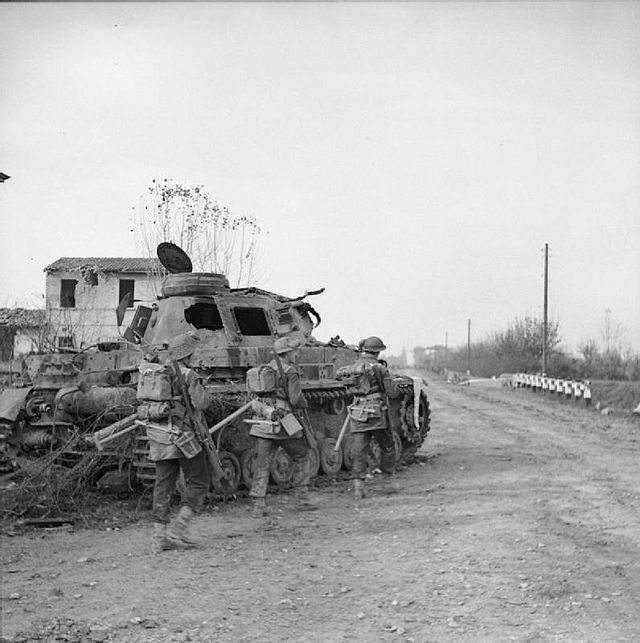 Photo: Sappers of 225 Field Company Royal Engineers remove a shell placed by the Germans to destroy a crossroads on Route 9 to Faenza, 24 November 1944. British troops reached the area before the charges could be detonated Photo: Sappers of 225 Field Company Royal Engineers remove a shell placed by the Germans to destroy a crossroads on Route 9 to Faenza, 24 November 1944. British troops reached the area before the charges could be detonated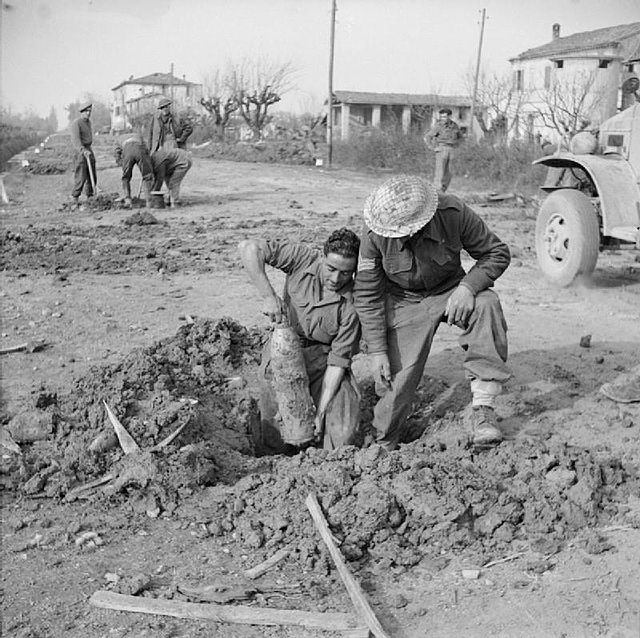 Battle of the Atlantic Battle of the Atlantic In the Cabot Strait, Canada, German submarine 'U-1228' torpedoes and sinks Canadian corvette HMCS 'Shawnigan'. All 90 on board die. Pacific WarCHINA (Fourteenth Air Force): 21 B-24s bomb the warehouse area and docks at Hankow, China. 3 others hit the Haiphong, French Indochina area. 22 B-25s bomb a storage area near Lashio, Burma, targets of opportunity in the Hankow, China area, and the towns of Wanling and Wan Lai-Kam, Burma, and Siangtan, and Wuchang, China. 120+ P-40s, P-38s and P-51s on armed reconnaissance attack many targets of opportunity in E Burma and SW and SE China, concentrating on river and rail traffic and supplies at Chefang, Hengshan, and the Sinshih-Changsha, China area. Japanese forces in southern China, attempting to gain contact with their forces garrisoning French Indochina, take Nanning. INDIA-BURMA (Tenth Air Force): In Burma, 32 P-47s fly close support strikes in the Pinwe and Bhamo se#2ctors; 50 P-47s attack troops and supply areas at Panma, Hpa-Hpen, Nawng-Sang, Kawlin, Wahkyet, Kawngai, and in the Pintha area, 8 damage bridges at Meza, Namhkai, and Hsenwi while 10 others hit Lashio Airfield; 6 B-25s pound the storage and ferry area at Meza and 4 damage approaches to the Namhkai and Hsenwi road bridges. 323 transport sorties are flown to forward areas. SAIPAN (Seventh Air Force): 2 B-24s from Saipan Island on a shipping reconnaissance attack vessels at Haha Jima and Chichi Jima Islands. 3 B-24s from Guam Island on armed reconnaissance bomb Marcus. 14 Saipan based P-47s strafe landing ground on Pagan. SOUTHWEST PACIFIC AREA [Far East Air Force]: In the Philippine Islands, B-24s bomb AA positions and targets of opportunity at Camp Downes and Panalisan Point and US fighters attack and destroy several aircraft over Carigara Bay and the Leyte Island area; B-24s hit AA positions and other targets at Matina Airfield on Mindanao; units arriving on Leyte Island: 25th Photographic Reconnaissance Squadron, 6th Photographic Reconnaissance Group, at Dulag from Biak Island with F-5s; 65th Bombardment Squadron (Heavy), 43d Bombardment Group (Heavy), at Tacloban from Owi with B-24s. Lost on a flight from Biak to Hollanida is C-46 42-101046. JAPAN The USAAF Twentieth Air Force's XXI Bomber Command flies Mission 7, their first against Japan; the objective is Tokyo. The 111 B-29s are led by Brigadier General Emmett O'Donnell Jr, Commanding General, 73d Bombardment Wing (Very Heavy), piloting "Dauntless Dotty," copiloted by Major Robert K Morgan, erstwhile pilot of the famed B-17 "Memphis Belle." Thirty five B-29s bomb the primary target, the Musashino aircraft plant while 50 bomb the secondary target, the urban area and docks. Seventeen others abort en route, the remainder are unable to bomb due to mechanical difficulties. Unfortunately, even with the use of radar, overcast skies and bad weather prove an insurmountable obstacle at 30,000 feet and fewer than 50 bombs hit the primary target. One B-29 crashes off Honshu Island when a fighter rams the bomber, shearing off the elevator and right horizontal stabilizer, becoming the first XXI Bomber Command B-29 lost to Japanese action; one other ditches after running out of fuel. B-29 gunners claim 7-18-9 Japanese aircraft. This is the first time Tokyo has been bombed since the Doolittle raid of 18 April 1942. PHILIPPINE CAMPAIGN (1944) In the U.S. Sixth Army's X Corps area on Leyte, the 1st Battalion of the 34th Infantry Regiment, 24th Infantry Division, repels a minor counterattack against Kilay Ridge. In the XXIV Corps area, the 32d Infantry Regiment recovers some ground previously lost on Shoestring Ridge and holds the perimeter--about 2,000 yards long and less than 1,500 yards deep against a vigorous counterattack during the night of 24/25 November. USAAF Far East Air Forces B-24s bomb antiaircraft positions and targets of opportunity at Camp Downes and Panalisan Point and fighters attack and destroy several aircraft over Carigara Bay and the Leyte Island area. B-24s hit antiaircraft positions and other targets at Matina Aerodrome on Mindanao Island. P-40s and P-47s attack one of the groups of ships involved in the 5th phase of the TA Operation, sinking a submarine chaser and three landing ships in Cataingan Bay, Masbate Island. CAROLINE ISLANDS Photo: The U.S. Navy light aircraft carrier USS Monterey (CVL-26) at anchor in the Ulithi Atoll, Caroline Islands, on 24 November 1944. Note F6F-5 fighters of Carrier Air Group 28 (CVG-28) parked aft on her flight deck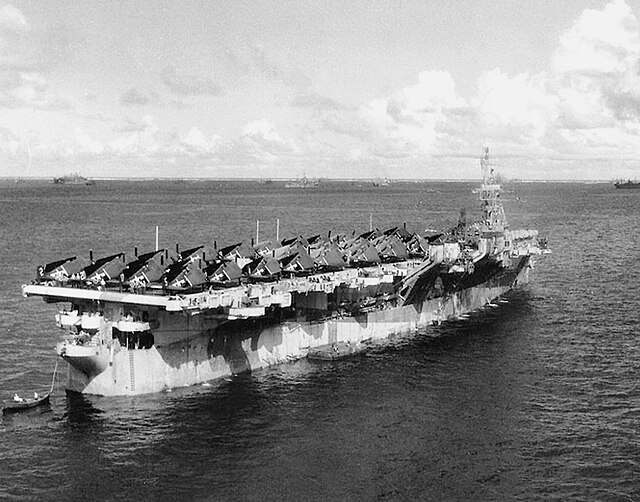 VOLCANO ISLANDS USN heavy cruisers USS Chester, Pensacola and Salt Lake City bombard Iwo Jima.
|
|
lordroel
Administrator
Posts: 68,033 
Likes: 49,431
|
Post by lordroel on Nov 25, 2023 15:06:11 GMT
Day 1902 of World War II, November 25th 1944YouTube (General Patton's Metz Obsession)Western Front (1944) - Siegfried Line campaignMap: HQ Twelfth Army Group situation map, November 25th 1944 US troops break out of the Hurtgen Forest. Forces of US 1st Army, to the southeast of Aachen, advance beyond Hurtgen. Photo: REME troops work to repair the track on a Sherman tank in heavy rain, near Geilenkirchen, 25 November 1944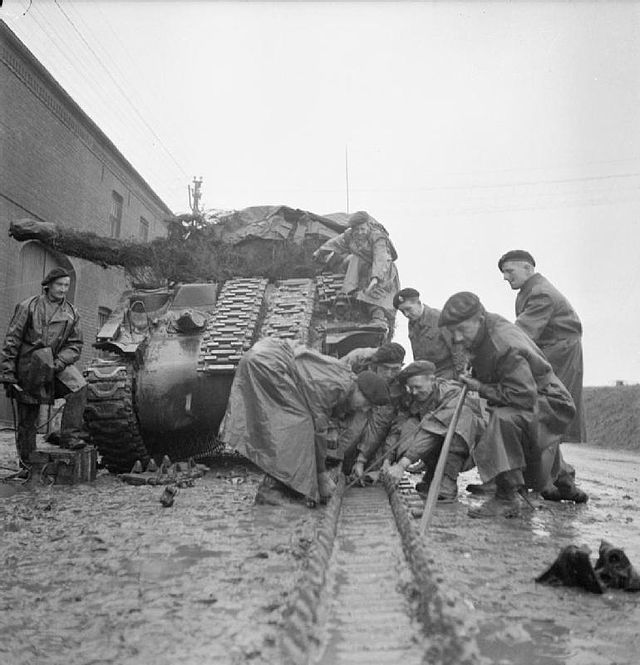 Western Front (1944) - Liberation of the NetherlandsPhoto: British supply trucks crossing a Bailey bridge over the Maas in full flood at Maeseyk in Holland, 25 November 1944 Western Front (1944) - Liberation of the NetherlandsPhoto: British supply trucks crossing a Bailey bridge over the Maas in full flood at Maeseyk in Holland, 25 November 1944 Photo: Troops from the 1st Battalion, South Lancashire Regiment man trenches in the front line in Holland, 25 November 1944 Photo: Troops from the 1st Battalion, South Lancashire Regiment man trenches in the front line in Holland, 25 November 1944 Air War over Europe Air War over Europe(US Eighth Air Force): 2 missions are flown. Mission 723: 1,043 bombers and 965 fighters are dispatched to hit the synthetic oil plant at Merseburg, Germany using H2X and a marshalling yard; 8 bombers and 6 fighters are lost: 1. 671 of 766 hit the Leuna oil plant at Merseburg and 9 hit targets of opportunity; 8 B-17s are lost, 4 damaged beyond repair and 197 damaged; 7 airmen are KIA, 5 WIA and 64 MIA. Escort is 716 of 800 P-51s; they claim 9-0-8 aircraft on the ground; 6 P-51s are lost (pilots MIA) and 1 damaged beyond repair. 2. 254 of 271 B-24s hit the Bingen marshalling yard; 43 B-24s are damaged; 1 airman is WIA. Escort is 129 of 130 P-47s. (US Eighth Air Force): Mission 724: 7 B-17s and 6 B-24s drop leaflets in France, the Netherlands and Germany during the night. The 36th Bombardment Squadron (Heavy), VIII Fighter Command starts daily operations as a screening force for the bombardment divisions; it is assigned the task of protecting the Eighth's primary VHF and fighter-to-bomber communications from interception during assembly; the increase of flak batteries around German military and industrial installations soon compels the 36th to increase radar countermeasures on each mission; the 36th remains on this assignment until the end of war in Europe. (US Ninth Air Force): In Germany, the 9th Bombardment Division hits an ordnance arsenal at Landau, road junctions, and an ammunition dump at Neustadt and Kaiserslautern; fighters escort the 9th Bombardment Division and Eighth AF, fly armed reconnaissance and support ground forces E of Aachen and between Merzig and Sarreguemines, France. (US Fifteenth Air Force): During the night of 24/25 Nov, 40+ B-17s and B-24s bomb the Linz benzol plant, Klagenfurt, and Innsbruck, Austria, and Munich W W marshalling yards in Germany, and 2 unidentified targets of opportunity; during the day P-38s fly photo and weather reconnaissance missions. 68 RAF Mosquitos to Nuremberg, 10 to Hagen and 9 each to Erfurt and Stuttgart, 36 RCM sorties, 38 Mosquito patrols. 1 Mosquito lost from the Nuremberg raid. The 356th Fighter Squadron 354th Fighter Group, moves from Orconte to Rosieres-en-Haye, France with P-47s. Italian campaign (US Twelfth Air Force): In Italy, bad weather again hampers operations; 3 fighter groups fly only 53 sorties against railway targets and targets of opportunity N of the US Fifth Army battle area, cutting lines at 14 places and destroying several vehicles. The 414th Night Fighter Squadron, 62d Fighter Wing, moves from Pisa to Pontedera, Italy with Beaufighters. The British 8th Army crosses the Cosina River. General Alexander is promoted to Field-Marshal. Battle of the Atlantic 'U-482' was sunk in the North Atlantic west of the Shetlands, in position 60.18N, 04.52W, by depth charges from the British frigate HMS 'Ascension'. 48 dead (all hands lost). United KingdomA German V-2 rocket strikes the crowded Woolworths store on New Cross Road, in Deptford, central London, England, killing 160, seriously injuring 77, and injuring 122 others. United StatesPhoto: USS LST 965 after its launch. Photograph of the ceremony to launch LST 965 on 25 November 1944 in Hingham, Massachusetts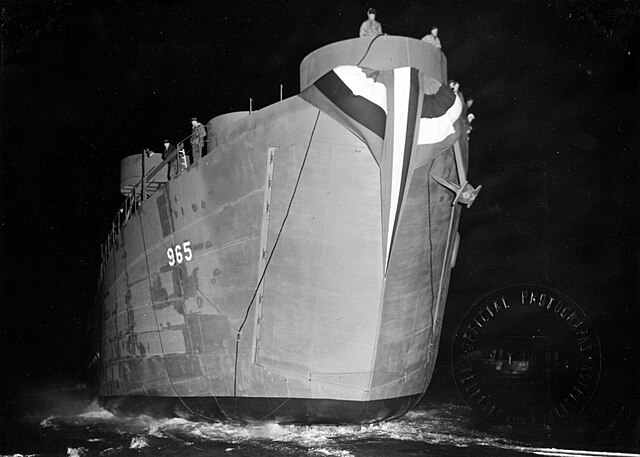 Photo: The U.S. Navy escort carrier USS Kalinin Bay (CVE-68) arriving at San Diego, California (USA), on 25 November 1944 for repair of damages received in the Battle off Samar a month earlier. The ship is painted in Camouflage Measure 33, Design 10A Photo: The U.S. Navy escort carrier USS Kalinin Bay (CVE-68) arriving at San Diego, California (USA), on 25 November 1944 for repair of damages received in the Battle off Samar a month earlier. The ship is painted in Camouflage Measure 33, Design 10A Pacific War Pacific WarCHINA (Fourteenth Air Force): 12 B-25s hit warehouses, village and town areas at Lashio and Wanling, Burma. 6 attack rail targets, trucks, and buildings at Phu Lang Thuong, French Indochina. 75 P-40s, P-51s, and P-38s on armed reconnaissance attack river, road, and rail traffic, troops, buildings, and other targets of opportunity at several Thailand, Burma, S China, and N French Indochina locations, including areas around Bhre and Lampang, Thailand; Paoching, Ankang, Ishan, and Hochih, China; Namsang, and Mongyu, Burma; and Phu Lang Thuong, French Indochina. INDIA-BURMA (Tenth Air Force): In Burma, 24 fighter-bombers support ground forces in the Bhamo area; 24 bomb an airfield at Kawlin while 8 more strafe Tabingaung Airfield and town area; 12 attack the Meza railroad station and boxcars in nearby bridge area, storage and personnel areas in the Lashio area and at Nawngyang, Ashang, and Man Mao; 8 P-47s strafe targets of opportunity along the Wuntho-Shwebo rail line. Transports fly 325 sorties to forward bases and frontline areas. GUAM (Seventh Air Force): 7 Guam Island-based B-24s, escorting a photo aircraft over the Bonin and Kazan Islands, bomb Chichi Jima, Muko Jima, and Haha Jima Islands. JAPANESE OCCUPIED NETHERLANDS EAST INDIES USAAF Far East Air Forces B-25s and fighter-bombers hit airfields on Ceram and Boeroe (Buroe) Islands and B-24s on armed reconnaissance over northern Borneo hit shipping and other targets of opportunity. During the night of 25/26 November, B-25s hit airfields in northeastern Celebes and Halmahera Islands. PHILIPPINE CAMPAIGN (1944) On Leyte, Lieutenant General Walter Krueger, Commanding General Sixth Army, halts work on airfields. In the X Corps area, Company A, the most advanced unit of the 1st Battalion, 34th Infantry Regiment, 24th Infantry Division, on Kilay Ridge, repels a heavy Japanese counterattack, during the night of 25/26 November. In the XXIV Corps area, the 32d Infantry Regiment of the 7th Infantry Division contains another Japanese counterattack, which is made in less strength after nightfall. The 511th Parachute Infantry Regiment, 11th Airborne Division, starts s difficult westward trek over the mountains from Burauen toward Mahonag, 10 miles distant, to ease pressure on the corps units driving on Ormoc. USAAF Far East Air Forces fighter-bombers range over wide areas of Masbate, Cebu, and Leyte Islands, and surrounding waters, attacking shipping, airfields, bivouacs, and a variety of targets. TG 38.2 (Rear Admiral Gerald F. Bogan) and TG 38.3 (Rear Admiral Frederick C. Sherman) aircraft bomb Japanese shipping off central Luzon. Planes from carrier Ticonderoga (CV-14) sink heavy cruiser Kumano in Dasol Bay, 15°45'N, 119°48'E. F6Fs, SB2Cs and TBMs from carriers Ticonderoga and Essex (CV-9), along with F6Fs and TBMs from small carrier Langley (CVL-27) attack convoy about 15 miles southwest of Santa Cruz, on the west coast of Luzon, and sink coast defense ship Yasojima (ex-Chinese cruiser Ping Hai), 15°45'N, 119°45'E, and landing ships T.112, T.142, and T.161, 15°40'N, 119°45'E. Planes from carrier Intrepid (CV-11) sink fast transports T.6 and T.10, and damage fast transport T.9 and escort destroyer Take, Balanacan Harbor, Marinduque Island, 13°25'N, 121°55'E. Planes from Essex and Langley sink army cargo ship No.6 Manei Maru and damage cargo ship Kasagisan Maru in San Fernando harbor, 16°37'N, 120°19'E. Photo: The japanese heavy cruiser Kumano in Santa Cruz Harbor, on 25 november 1944 Kamikazes breach the fleet's fighter defenses, however, and press home determined attacks, damaging carriers Essex, Intrepid and Hancock (CV-19), 15°47'N, 124°14'E, and small carrier Cabot (CVL-28), 15°42'N, 123°09'E. Small carrier Independence (CVL-22) is damaged by crash of own aircraft into island structure, 15°58'N,125°14'E. Photo: The U.S. Navy aircraft carrier USS Essex (CV-9) about to be hit by a Japanese Yokosuka D4Y "Judy" aircraft during Kamikaze attacks off Luzon, 25 November 1944. The plane, afire from anti-aircraft gun hits, struck near the carrier's forward elevator. Note the Cleveland-class light cruiser in the left distance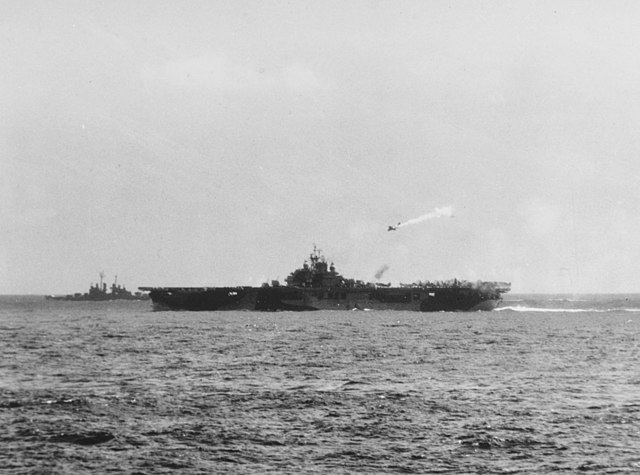 Photo: The U.S. Navy aircraft carrier USS Essex (CV-9) is hit on the flight deck amidships by a Japanese Kamikaze, during operations off the Philippines, 25 November 1944 Photo: The U.S. Navy aircraft carrier USS Essex (CV-9) is hit on the flight deck amidships by a Japanese Kamikaze, during operations off the Philippines, 25 November 1944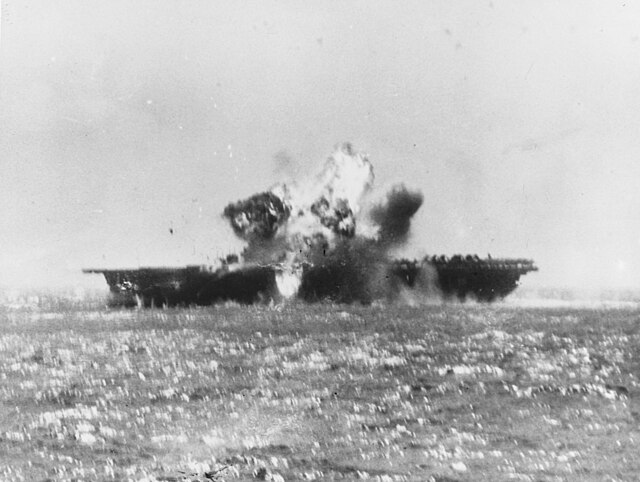 Photo: The U.S. Navy aircraft carrier USS Intrepid (CV-11) burns after being hit by Japanese kamikaze suicide planes off the Philippines on 25 November 1944. Two kamikazes crashed into Intrepid, killing sixty-six men and causing a serious fire. The ship remained on station, however, and the fires were extinguished within two hours. She was detached for repairs the following day, and reached San Francisco on 20 December Photo: The U.S. Navy aircraft carrier USS Intrepid (CV-11) burns after being hit by Japanese kamikaze suicide planes off the Philippines on 25 November 1944. Two kamikazes crashed into Intrepid, killing sixty-six men and causing a serious fire. The ship remained on station, however, and the fires were extinguished within two hours. She was detached for repairs the following day, and reached San Francisco on 20 December Photo: The U.S. Navy light aircraft carrier USS Cabot (CVL-28) is hit by a kamikaze, while operating with Task Group 38.2 off Luzon, 25 November 1944. The kamikaze, already flaming from hits, crashed on the flight deck on the port side, destroying a still-firing 20 mm gun platform, disabling 40 mm mounts and a gun director. Another kamikaze crashed close aboard and showered the port side with shrapnel and burning debris. 62 men were killed or wounded. While Cabot continued to maintain her station in formation and operate effectively, temporary repairs were made Photo: The U.S. Navy light aircraft carrier USS Cabot (CVL-28) is hit by a kamikaze, while operating with Task Group 38.2 off Luzon, 25 November 1944. The kamikaze, already flaming from hits, crashed on the flight deck on the port side, destroying a still-firing 20 mm gun platform, disabling 40 mm mounts and a gun director. Another kamikaze crashed close aboard and showered the port side with shrapnel and burning debris. 62 men were killed or wounded. While Cabot continued to maintain her station in formation and operate effectively, temporary repairs were made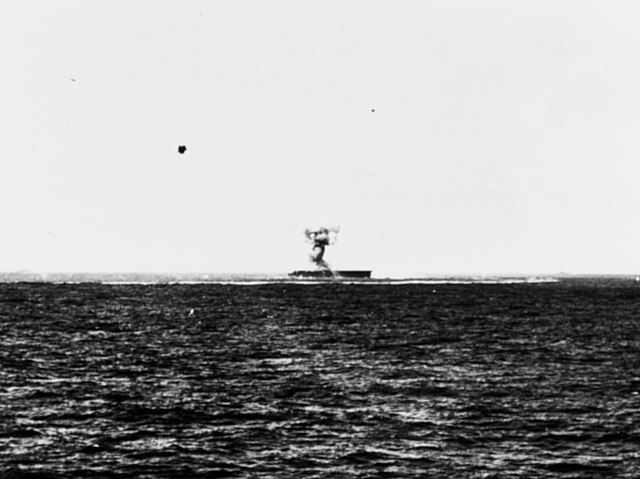 Photo: The U.S. Navy aircraft carrier USS Hancock (CV-19) burning as the result of a Japanese kamikaze attack on 25 November 1944. Antiaircraft fire had exploded the plane some 90 m above the ship, but a section of its fuselage landed amidships, and a part of the wing hit the flight deck and burst into flames. Prompt and skillful damage control quickly extinguished the blaze and prevented serious damage Photo: The U.S. Navy aircraft carrier USS Hancock (CV-19) burning as the result of a Japanese kamikaze attack on 25 November 1944. Antiaircraft fire had exploded the plane some 90 m above the ship, but a section of its fuselage landed amidships, and a part of the wing hit the flight deck and burst into flames. Prompt and skillful damage control quickly extinguished the blaze and prevented serious damage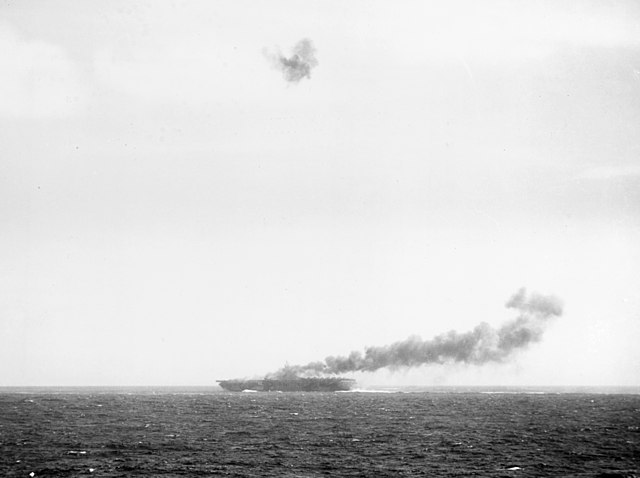 Japanese merchant tanker Ceram Maru is damaged by aircraft in Manila Bay. SOLOMON ISLANDS CAMPAIGN On Bougainville, the Australian 9th Battalion, 7th Brigade, 3rd Division, relieves the 2d Battalion, U.S. 132d Infantry Regiment, Americal Division. Photo: An Ordnance QF 25-pounder Short being moved into a firing position on Bougainville by gunners of the 4th Field Regiment HAWAIIAN ISLANDS Commander-in-Chief, Pacific Ocean Area (CINCPOA) issues Operation Plan 11-44 for the invasion of Iwo Jima. The USN Fifth Fleet commander is to seize Iwo and develop air bases there. The invasion date is tentatively set for 3 February 1945. ALASKA (Eleventh Air Force): A B-24 aborts an armed photo mission over Matsuwa Island due to weather and instead radarbombs Kurabu Airfield on Paramushiru Island; B-25s cancel a shipping sweep due to weather. UNITED STATES NAVY DEPARTMENT COMMUNIQUES, CINCPAC COMMUNIQUÉ NO. 189, NOVEMBER 25, 1944 Seventh Army Air Force planes bombed shipping and dock installations at Chichi Jima and Haha Jima in the Bonins on November 22 (West Longi¬tude Date). Hits were scored on docking facilities on Haha Jima. On November 24, Chichi Jima was again struck by Seventh Air Force planes. On November 22, Corsairs of the Second Marine Aircraft Wing destroyed a number of barges and struck at installations in the Northern Palaus. The airfield at Yap was hit on the same date by Marine Corsairs. Three barges were sunk and fires were started in enemy held bases in the Northern Palaus which were attacked by Second Marine Aircraft Wing fighters on November 24. On the same date Seventh Army Air Force planes bombed Arakabesan, leaving large fires. Installations on Marcus Island were bombed by Seventh Army Air Force Liberators on November 24. Second Marine Aircraft Wing Corsairs encountered moderate antiaircraft fire in attacks on Yap airfield on November 21. On the same date, Marine night fighters hit enemy held bases in the Northern Palaus and Seventh Army Air Force bombers pounded Arakabesan and Yap. Thunderbolts of the Seventh Army Air Force attacked the airfield on Pagan in the Marianas on November 21. A Japanese reconnaissance plane was shot down by an Army fighter over Saipan on November 24. Ponape in the Carolines was bombed on November 21 and 23 by fighters of the Fourth Marine Aircraft Wing. Targets were hit in the area of the airfield, the seaplane ramp and fuel dumps. Planes of the Fourth Marine Aircraft Wing on November 21 and 23, carried out neutralization raids in the Marshalls. PACIFIC Motor torpedo boat PT-363 is sunk by shore battery off Cape Gorango, Halmahera Island, 00°55'N, 127°50'E. Submarine Atule (SS-403) sinks Japanese merchant cargo ship Santos Maru off Sabtang Island, Luzon, 20°12'N, 121°51'E. Although Atule claims destruction of the escorting submarine chaser Ch 33, the latter survives the attack. Submarine Cavalla (SS-244) sinks Japanese destroyer Shimotsuki, west of Borneo, 02°28'N, 107°20'E. Submarine Haddo (SS-255) damages Japanese escort destroyer Shimushu, 14°00'N, 119°25'E. Submarine Hardhead (SS-365) attacks Japanese convoy about 60 miles west of Manila, and sinks Coast Defense Vessel No.38 off Bataan peninsula, 14°33'N, 119°51'E. Submarine Mingo (SS-261) attacks Japanese convoy SIMA-05, sinks army transport Manila Maru about 90 miles northwest of Miri, Sarawak, 05°30'N, 113°24'E, and survives a depth-charging by escort vessel Kurahashi. Submarine Pomfret (SS-391) sinks Japanese Patrol Boat No.38 and transport Shoho Maru, Luzon Strait, 20°18'N, 121°34'E. USAAF B-24s (14th Air Force), on night reconnaissance flight over the South China Sea, attack Japanese shipping south of Hainan Island, bombing and strafing Hida Maru and escorting minesweepers W.17 and W.18, 16°44'N, 108°24'E, damaging both minecraft. Hida Maru takes the crippled W.18 in tow (see 26 November 1944). Chinese aircraft attack Japanese river gunboats on the Yangtze near Anking, China, sinking Fushimi and damaging Sumida.
|
|












































































































